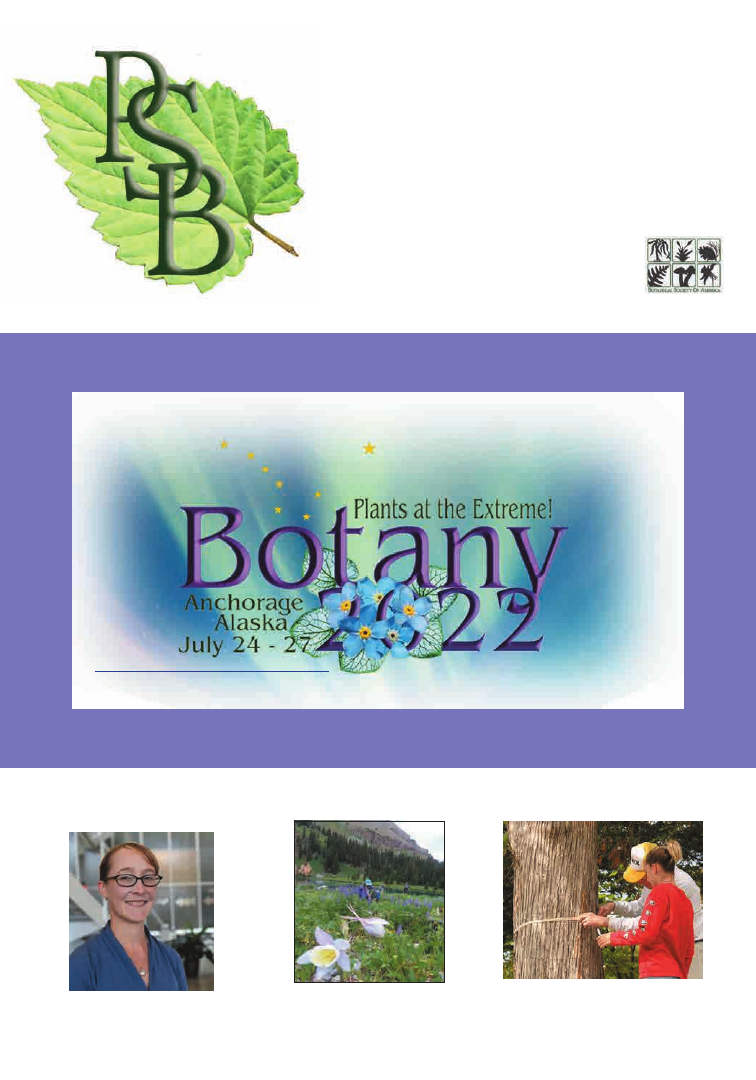
Make Your Plans to Attend—In Person or Virtually!
IN THIS ISSUE...
SPRING 2022 VOLUME 68 NUMBER 1
PLANT SCIENCE
BULLETIN
A PUBLICATION OF THE BOTANICAL SOCIETY OF AMERICA
Targeted plant collection by undergrads
& citizen scientists to understand plant
distribution...p. 24
Registration and Abstract Submission Now Open!
www.botanyconference.org
Welcome to new APPS Editor-in-Chief,
Briana Gross...p. 4
Discovering the microscopic world of live
tree bark...p. 12

Spring 2022 Volume 68 Number 1
FROM THE EDITOR
PLANT SCIENCE BULLETIN
Editorial Committee
Volume 68
James McDaniel
(2022)
Botany Department
University of Wisconsin Madison
Madison, WI 53706
jlmcdaniel@wisc.edu
Seana K. Walsh
(2023)
National Tropical Botanical Garden
Kalāheo, HI 96741
swalsh@ntbg.org
Greetings,
Spring 2022 is upon us. Writing for posterity, I feel I must note a few
world events. Since our Fall issue, the United States has endured a
spike in COVID cases. Fortunately, reported case numbers have fallen
dramatically since and, in Omaha at least, we are seeing some of our
lowest numbers in a year. Anxiety over the virus and the presence (or
absence) of safety protocol continue to affect many of us. Just over
three weeks ago, Russia invaded Ukraine. I’ve heard from both Russian
and Ukrainian colleagues expressing anger and dismay over this turn
of events. We at PSB send our deepest sympathies to our readers directly affected by violence
either there, or anywhere else in the world.
We have several articles and special features in this issue that I hope you will enjoy. We welcome
a new Editor-in-Chief of APPS, and you can read about Briana Gross’ vision for that journal.
We also say goodbye to a large cohort of Botanists we have recently lost in our In Memoriam
section. Please take a moment to read about their extraordinary lives and careers.
Excitement is building over Botany 2022. This will be the first hybrid meeting in BSA history.
I am looking forward to seeing many of you in-person in Anchorage.
Sincerely,
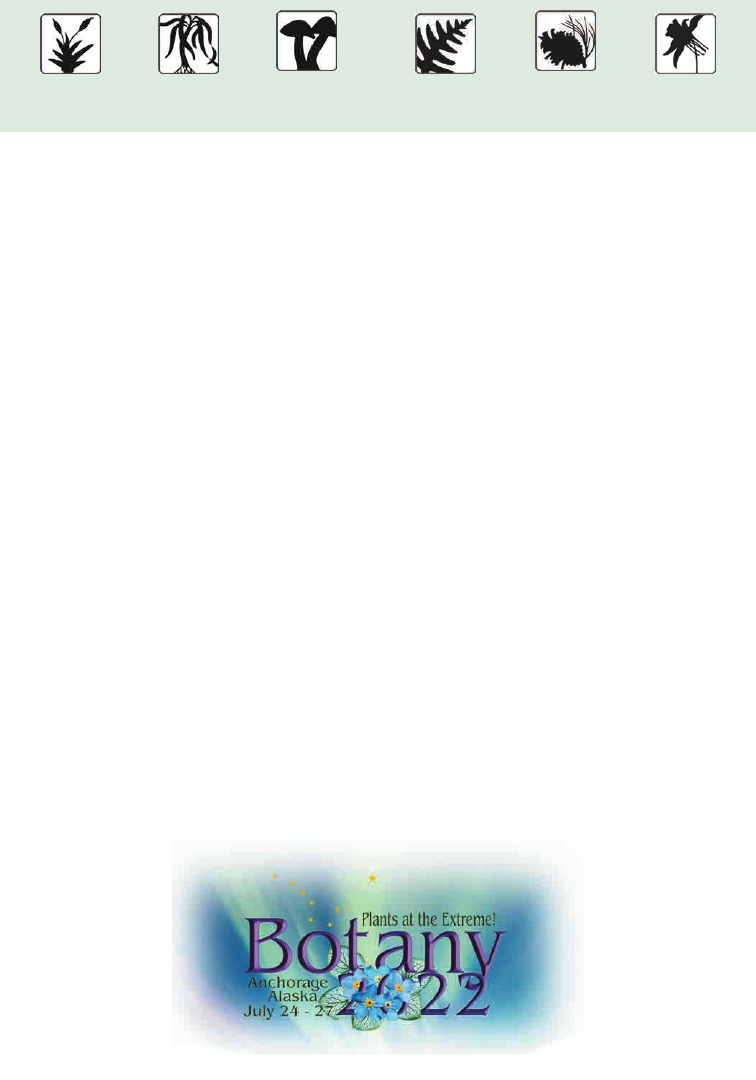
3
TABLE OF CONTENTS
SOCIETY NEWS
BSA Welcomes Briana Gross as New
APPS Editor-in-Chief..................................................................4
Clade Biology, Phylogenetic Biology, and Systematics...............................................................................7
SPECIAL FEATURES
Discovering the Microscopic World of Live Tree Bark ............................................................................12
Filling in the Gaps: Targeted Plant Collection by Undergraduates and Citizen
Scientists to Better Understand Plant Distribution............................................................................24
The Future of Botany: Educating for a Diverse and Inclusive 21st-Century Workforce........32
SCIENCE EDUCATION
PlantingScience Digging Deeper Research Published............................................................................42
Update on PlantingScience .....................................................................................................................................42
Life Discovery Conference 2021..........................................................................................................................45
Updated Teaching Resources................................................................................................................................45
STUDENT SECTION
Roundup of Student Opportunities......................................................................................................................46
ANNOUNCEMENTS
In Memoriam Sherwin Carlquist (1930–2021).............................................................................................66
In Memoriam Jack Lee Carter (1929-2020)..................................................................................................67
In Memoriam Alan Graham (1934–2021)......................................................................................................70
In Memoriam William Louis Stern (1926–2021)........................................................................................73
In Memoriam Ronald L. Stuckey (1938–2022)............................................................................................77
In Memoriam Leonard Thien (1938–2021) .................................................................................................81
MEMBERSHIP NEWS
2021 Gift Membership Drive Results and Drawing Winner...................................................................85
Introducing Botany360: The BSA Community Event Calendar .........................................................86
BSA Award Opportunities.......................................................................................................................................87
Did You Know? ...............................................................................................................................................................87
BOOK REVIEWS..................................................................................................................................................
88
BSA YEAR IN REVIEW ........................................................................................
INSIDE BACK COVER
www.botanyconference.org

4
SOCIETY NEWS
Briana Gross recently took on the role of Editor-
in-Chief of Applications in Plant Sciences
(APPS), the BSA’s first fully Open Access
journal, publishing newly developed, innovative
tools, protocols, and resources in all areas of the
plant sciences. We spoke with Dr. Gross about
her vision for the journal.
What inspired you to apply to be Editor-in-
Chief at APPS?
I was lucky to be nominated by one of my
mentors, Susan Kephart. I had seen the
advertisements for the Editor-in-Chief
position and considered applying, but I
didn’t really dig in until being nominated.
Once I gave myself time to think about it, I
realized how excited I was about APPS and
remembered how much I enjoy editorial work.
This was also an ideal time in my career to take
on this role, so I felt ready to commit. I am
relaying the fact that I was nominated because
I think it’s important for me (and others) to
acknowledge the power of nominating others
for positions that we think they are qualified
for, and I hope that I can “pay it forward” in
the future.
How would you characterize your editorial
philosophy?
At an immediate, personal level, I want the
authors, reviewers, and readers who interact
with APPS to leave with a positive impression
of the journal, even when decisions might not
go in an author’s favor. At a broader level, it
is the responsibility of the Editor-in-Chief to
be mindful of the direction of the journal and
plan strategically for its success in cooperation
with the editorial board and editorial staff.
My objective in this capacity is to work to
communicate our intentions transparently
and create an environment where all our
community members feel heard while still
moving APPS forward.
Many organizations, including the BSA, have
made it a priority to expand opportunities
for people in underrepresented groups. How
do you envision supporting and expanding
diversity and inclusion in APPS? How do
you view the opportunities and challenges
of heading up an Open Access journal, while
furthering diversity, equity, and inclusion?
BSA Welcomes Briana Gross
as New
APPS
Editor-in-Chief

PSB 68(1) 2022
5
Thanks to the work of previous Editor-in-
Chief Dr. Theresa Culley, the editorial board,
and the editorial staff, APPS already has a
good start toward expanding opportunities
for publication through increasing the
representation among its editors. However,
there is still room for us to expand by reaching
out to minority-serving institutions in the
United States and to botanical societies around
the world. These efforts will not bear fruit
immediately, but it is time to plant the seeds
now and cultivate these relationships so that
authors from these groups know that APPS is
a supportive publication venue. Publishing an
Open Access journal is a double-edged sword.
We make our publications available to anyone
with internet access, but this comes at a cost
to authors that is not always backed by their
institutions or funding sponsors. Thus, we can
expand opportunities through making science
a common commodity, but we have to find a
way to back that cost. My long-term objective
is to develop a comprehensive backstop of
funding sources to help cover the publication
costs for articles that are appropriate for APPS
to help fill this gap.
As APPS approaches its 10-year publication
anniversary, this is a time to reflect on
achievements while looking to the future.
What do you see as strengths of the journal
and goals for the next 10 years?
APPS has so many strengths: the quality of
the publications in APPS is high and it has
continued to increase over the years, it has a
great reputation in the botanical community
as a reliable resource for new protocols and
software, and it integrates across the diversity
of fields of plant science. In the next 10
years, I want to see APPS as the destination
for authors and readers interested in plant
genomics (both resources and software) and
the continually evolving catch-all of “big
data” in botany, ranging from herbarium
digitization to ecological modeling for plant
communities. Beyond the subject matter that
we cover, which will inevitably evolve in the
next decade, my goal is for APPS to increase
its profile in the botanical community so that
we are the destination of choice for any new
methods in plant science. As a young journal,
we have enormous potential, and I know
that we have capacity and ability to facilitate
excellent experiences for authors, editors, and
readers as we grow.
APPS is proud to be a Society journal. How
do you think APPS can best serve members
of the BSA community (and beyond),
and why do you think it’s important for
BSA members to support their Society
publications?
APPS can serve its members by being mindful
and responsive to their needs, while also
making sure that the journal continues to
grow its impact factor and feature high-quality
publications. I hope that I can learn more
about what our members want and how we
can provide this every year going forward. We
also strive to give authors a great experience

PSB 68 (1) 2022
6
when they send their work to us. On the flip
side, we depend on our members to send us
their work and to promote APPS to colleagues
who might not be aware of us yet. We are all
part of a team, and as a member-owned Society
we all benefit from small actions that support
our publications. If each of our members
thought of APPS as the primary target for
the new method they cooked up in their labs,
we would be happy to see those submissions
and I think that the ultimate publications will
benefit from the excellent reputation of the
journal.
What are you most looking forward to as
Editor-in-Chief?
There are many different things that I like
about writing and editing, and serving as
Editor-in-Chief will be enjoyable for those
reasons. However, one of the main things
that I look forward to is working with smart,
talented botanists who care about their work
and have great ideas for the field and for
APPS. Working with enthusiastic, intelligent
colleagues is one of the best things we can
experience in our professional careers, and I
think that serving as Editor-in-Chief for APPS is
a place where I can experience this to the fullest.
NEW EARLY CAREER ADVISORY BOARD (ECAB) FOR
2022-2024
The BSA's Early Career Advisory Board (ECAB) is a group of early-career botanists that engages
with and advises the editors of the American Journal of Botany, Applications in Plant Sciences,
and the Plant Science Bulletin in a number of ways, including recommending timely topics for
review papers, identifying papers in pre-print archives that may be appropriate to publish in
our journals, and advising on issues of importance to the publications team.
We had a tremendous response to our recent call for students and postdocs to join the ECAB,
and we are grateful to all who applied. We are pleased to officially welcome the new group!
Row 1: Ajith Ashokan, Liming Cai, Mario Blanco-Sánchez, Urooj Fatima, Ana Flores
Row 2: Jorge Flores, Catalina Flores-Galván, Shelly Gaynor, Huasheng Huang, Luiz Rezende
To learn more about the 2022-2024 ECAB Members, see https://botany.org/home/publications/ecab.html.

PSB 68(1) 2022
7
In his incoming BSA presidential address at
Botany 2021, Michael introduced the phrase
“clade biology.” The idea was to draw attention
to an approach that the two of us have been
thinking needs more attention, and which we
think differs importantly from the area now
widely referred to as “phylogenetic biology.”
How do these two differ? Clade biologists
are those among us who obsess over some
particular group of organisms, wanting to
know as much about them as possible. They are
fascinated to learn any little thing about these
organisms, no matter how inconsequential
this may seem to others. They tend to work on
their organisms for a long time (often over an
entire career), and come at them from multiple
angles (functional morphology, development,
ecology, biogeography, etc.). Of course, their
work tends to be organized phylogenetically,
Clade Biology, Phylogenetic
Biology, and Systematics
and their knowledge of relationships may
eventually yield species delimitations and
a phylogenetic classification system, but in
our view these are natural outcomes of clade
biology, not its primary objectives. Clade
biologists tend naturally to build teams of
collaborators, drawing in other disciplines as
they take deep dives into one aspect or another
of the biology of their organisms. If a clade
biologist has the good fortune of training
students, their students might become
engaged in some dimension of the research
and might then take that along to their own
labs, in which case teams can expand through
multiple labs and academic generations. Over
the years, the group of organisms might ascend
to the level of a “model clade.” Like model
species (think Arabidopsis thaliana), these can
then serve as vehicles for testing hypotheses of
all sorts, taking full advantage of the wealth of
accumulated knowledge. But in this case, they
are mostly used to test hypotheses concerning
patterns and processes at the level of whole
clades.
Phylogenetic biologists, in our view, take
a different approach to understanding
clade-level phenomena. They tend to take a
hypothesis-testing approach from the outset,
focusing on a particular question rather than
on a particular clade, such as the evolution of
dioecy or shifts in the rate of diversification.
They often assemble very large phylogenetic
By Michael J. Donoghue & Erika J. Edwards
Department of Ecology & Evolutionary
Biology, Yale University, PO Box 208106,
New Haven, CT 06520, USA
Address of the Incoming BSA president
Michael Donoghue, with Erika Edwards

PSB 68 (1) 2022
8
trees (e.g., harvesting data from sources
such as GenBank), with multiple instances
of dioecy, for example, scattered throughout.
Alternatively, they may assemble and compare
phylogenetic trees of multiple individual
clades that include dioecious species. In many
cases, data on the trait (or traits) under study
are gathered not from nature but from surveys
of the literature, or perhaps from specialized
trait databases. The many other details of the
organisms under study—the ones that would
fascinate the clade biologist—are mostly
viewed as (or assumed to be) irrelevant to the
particular phenomenon under investigation.
Phylogenetic biologists also have a tendency
to move from one problem to another during
their careers, switching from one group of
organisms to another as appropriate. That
is to say, they are not so deeply committed
to working on one group of organisms for
a long time. They collaborate with clade
biologists and experts from other disciplines,
as necessary, but these alliances change as
they move from one suite of traits or clade to
another. And, to the extent that their studies
involve students, the threads that pass from
one generation to the next tend to revolve
around particular methodologies.
Are you a clade biologist or a phylogenetic
biologist? Or course, you don’t have to be
either one—there are plenty of other things to
be—and you could certainly be both. We have
purposefully set these out as two exclusive
categories, but in actuality there’s a continuum
between them. It’s also quite possible to be a
clade biologist who occasionally ventures
into phylogenetic biology. We think we’ve
done this during our own careers. It’s less
possible, we think, to go the other direction
because, almost by definition, it’s hard to
dabble in clade biology, or at least to do it very
effectively, without pretty complete devotion
to a particular clade, or possibly a few different
clades over the course of a lifetime.
Where is “systematics” in all of this? We
suspect that many BSA members identify
as systematists, although this may be less so
among younger members—at least, in our
recent experience, postdocs and graduate
students don’t identify as strongly with
systematics as they used to. To be sure, they
are happy to publish in journals with the word
systematics in the title, such as Systematic
Biology, but they don’t really see themselves as
systematists.
Traditional systematics doesn’t map very
neatly onto phylogenetic biology, as we delimit
this here, although we suspect that some who
identify as systematists would also consider
themselves to be (at least partly) phylogenetic
biologists. Systematics comes much closer,
we think, to clade biology, especially in as
much as training in systematics often begins
with the choice of a group of organisms on
which to become the world’s expert. On the
other hand, we suspect that our definition
of clade biology will seem overly broad to
many systematists in the sense that it doesn’t
specifically highlight species delimitation
and classification, which have long been the
bread and butter of systematics. In our view,
species delimitation and naming are critical
elements of clade biology, but our definition
puts a greater emphasis on understanding
the complete biology of the organisms in
question (including work at the intersection of
molecular biology, development, physiology,
ecology, etc.), whether or not this knowledge
bears very directly on species delimitation
or classification (although, naturally, it very
often will).

PSB 68(1) 2022
9
If one did wish to equate systematic biology
with clade biology (i.e., if these were viewed
as one and the same; Box 1, option 1), which
name would we chose for this field? One
might argue that we don’t need a new term—
we should just stick with systematics for this
field. On the other hand, we think that clade
biology has a distinct advantage in that it
refers unambiguously to the object of study:
clades. In this sense it is comparable to terms
such as “population biology,” “cell biology,”
etc., where the object of study is clearly
named. “Systematics” is ambiguous on this
score, as “system” itself is pretty vague and
all-encompassing. So, if we had to choose, we
think that clade biology would be the better
choice.
Another possibility would be to make a
hierarchy out of these disciplines (Box 1,
options 2 and 3). But does clade biology
naturally encompass phylogenetic biology, or
vice versa? We think not. As for “systematics,”
we see two possibilities. One would be to use
it to signify the subdiscipline within clade
biology focused squarely on species discovery
and classification. Another possibility, which
we prefer, would be to retain systematics for
the more inclusive field that encompasses both
clade biology and phylogenetic biology. In
any of these cases, we want to emphasize that
we see both clade biology and phylogenetic
biology as totally worthwhile and necessary
endeavors. There’s no better or worse here—
just alternative approaches to studying clade-
level phenomena. Which way you lean just
depends on what you find most satisfying.
Of course, it’s perfectly okay to not worry
at all about where you fit into this schema,
and to chart your own path. And, in doing
so, you might find yourself flirting with
other somewhat ill-defined terms, such as
“integrative biology” or “comparative biology.”
We won’t tackle these here, except to note that
integrative biology aligns pretty well in some
respects with clade biology, although some
who identify with this term are not so focused
on individual clades. Likewise, comparative
biology aligns in some respects with
phylogenetic biology in our sense of the word.
It’s a confusing landscape of terminology, to
be sure.
Our main point here is that it’s worth
recognizing clade biology as a distinct
endeavor, with its own peculiar and enduring
scientific value. To illustrate this, we’ll
briefly highlight the work of our recently
deceased zoological colleague, David Wake.
Box 1. Where does “systematics” fit in? Of these three options, we prefer number 3.
1. Clade Biology (= Systematic Biology)
Phylogenetic Biology
2. Clade Biology
Systematic Biology (species delimitation, classification)
Phylogenetic Biology
3. Systematic Biology
Clade Biology
Phylogenetic Biology

PSB 68 (1) 2022
10
Dave, along with his spouse and colleague,
Marvalee, both of UC Berkeley, devoted their
careers to understanding amphibians, but
especially salamanders, and especially lungless
salamanders (Plethodontidae). If you haven’t
followed this work, you should look into it,
and you’ll find one discovery after another
grounded in their deep commitment to, and
knowledge of, these organisms, built up over
more than five decades (Griesemer, 2013).
James Hanken (quoted in Sanders, 2021),
long the Director of Harvard’s Museum of
Comparative Zoology, described Dave Wake
in these words:
“He chose a particular lineage of organisms—
in this case, the family Plethodontidae—
and pursued it in all respects in order to
understand how the group diversified and
why it did the way it did. It was molecules
to morphology to ecology to behavior to
development, overlaid by taxonomy—his was
a deliberate conviction that in order to really
understand the evolution of organisms, you
have to focus on a particular group and get to
know it extremely well.”
This captures perfectly the way that we’re
thinking about clade biology: complete
immersion in a group of organisms, studied
from every possible angle. Add to this a team-
building mentality and lots of enthusiasm
and you’re in for a lifetime of pleasure and
discovery. And the beauty of such a long-
term commitment is that it leads naturally
to discoveries of very broad significance. As
Michael Nachman (quoted in Sanders, 2021),
Director of the UC Berkeley Museum of
Vertebrate Zoology, put it: “Salamanders were
his love and passion, but he was really a deep
thinker who used salamanders as an entry
way to thinking about the biggest questions in
evolutionary biology.”
Clade biology, done well, starts with some
organism-of-interest problem, but works its
way out to questions and answers in realms
that were never anticipated. Wake, for
example, was at the epicenter of the formation
of the field of evolutionary developmental
biology, and of the study of parallel and
convergent evolution, and of speciation (e.g.,
“ring species” in Ensatina). He also alerted
the world to the global decline of amphibian
populations. All of this flowed naturally from
his deep knowledge of salamanders.
One last thought concerns the career choices
faced by students and early-career scientists,
who may consider a long-term commitment
to a clade—with uncertain outcomes—to be
too risky in this day and age. We certainly
understand this worry but would offer the
following advice. If you are passionate about
a group of organisms, keep that passion alive
even as you pursue other things that might
lead to more immediate accomplishments.
We think you’ll find that the deep knowledge
that you accumulate will provide you with a
special lens through which to view biological
phenomena of all sorts, and will serve as an
unending source of fresh ideas. Get to know
a group of organisms “extremely well,” we’re
certain you won’t regret it!
Our overall conclusion is that clade biology
is a highly productive way of knowing,
which provides a necessary compliment to
other approaches, including what we have
distinguished here as phylogenetic biology. We
are confident that we won’t lose this approach
so long as at least some people continue to
obsess over particular groups of organisms,
which seems inevitable. However, what we
must do is to properly value, encourage,
and support this approach, and consciously
improve it not just for or own happiness but
for the betterment of science at large.
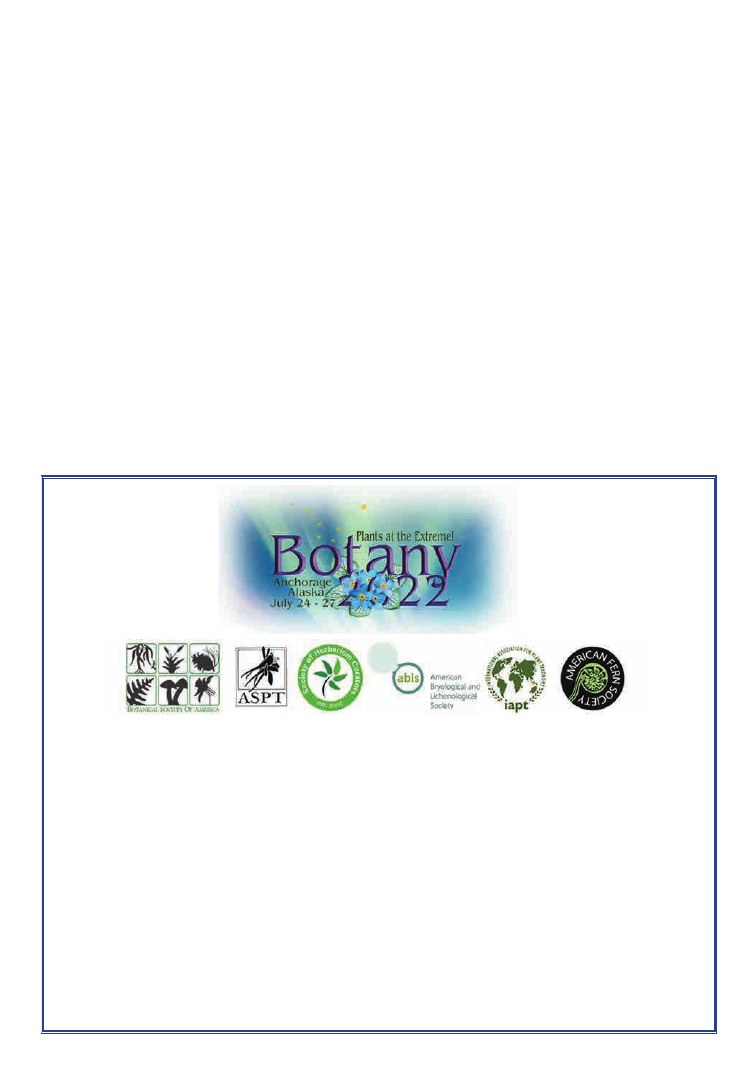
PSB 68(1) 2022
11
ACKNOWLEDGMENTS
We are very grateful to the BSA for the
opportunity to present these views, and to
the many students and colleagues who have
discussed these topics with us over the years.
REFERENCES
Griesemer, J. 2013. Integration of approaches
in David Wake’s model-taxon research plat-
form for evolutionary morphology. Studies in
History and Philosophy of Biological and
Biomedical Sciences 44: 525–536.
Sanders, R. 2021. David Wake, a prominent
herpetologist who warned of amphibian de-
clines, is dead at 84. Berkeley News, May
4, 2021. Website: https://news.berkeley.
edu/2021/05/04/david-wake-a-prominent-
herpetologist-who-warned-of-amphibian-de-
clines-is-dead-at-84/.
Are you registered for Botany 2022
Plants at the Extreme?
Don't miss out on the amazing field trips, workshops, scientific sessions, compelling
speakers and all the social and networking events - just like in the past!
As a bonus, it will be a hybrid conference, which means everything that is recorded at
the conference will be available to view and review for a year after the conference on the
online platform.
Register now! Conference information including hotels and dorms can be found at:
www.botanyconference.org
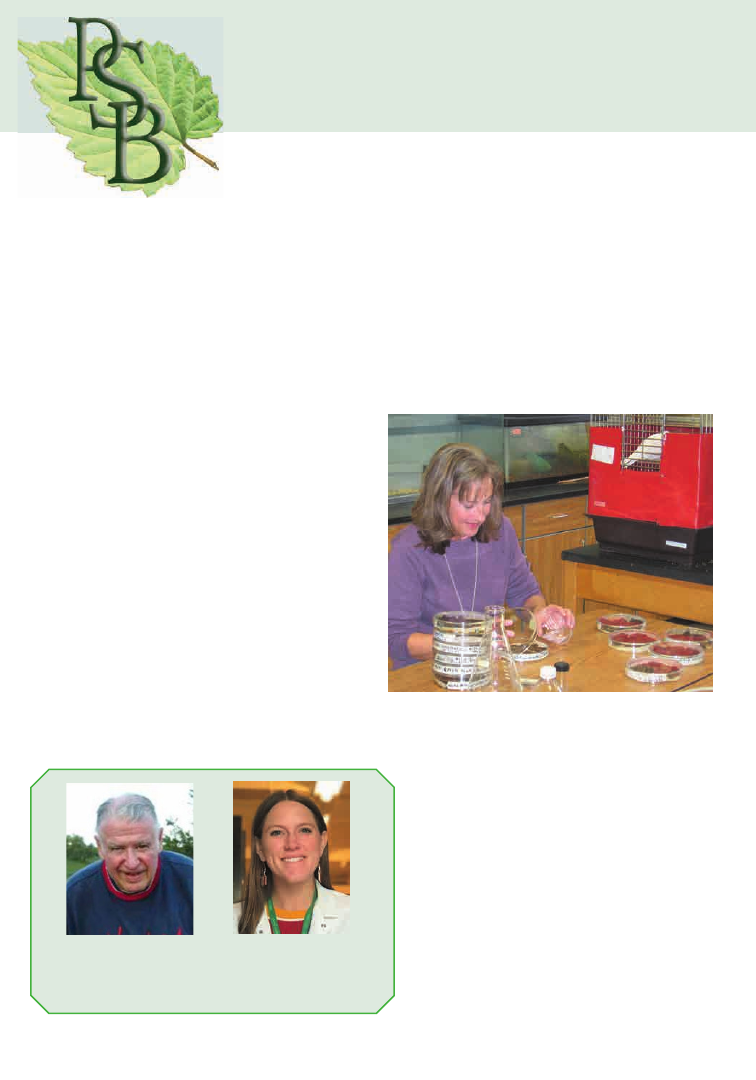
12
RATIONALE FOR
INSTRUCTIONAL
EXPERIENCE
Patricia (Trish) A. Smith, now retired, was
a seventh-grade Life Science teacher at
Warrensburg RVI Middle School (WMS), at
Warrensburg, MO during 2004–2007. Her
expertise in finding grant funds supported
her laboratory classroom activities with
extramural funding. These grant funds came
from the Missouri Department of Elementary
and Secondary Education and local private
organizations. She shared her classroom
Discovering the Microscopic World
of Live Tree Bark
A Model Instructional Experience for Students and Teachers
Using a Virtual iAdventure, Teacher Preparation Guide,
Student Worksheets, and Moist Chamber Cultures
By Harold W. Keller and Ashley Bordelon
Botanical Research Institute of Texas,
1700 University Drive, Fort Worth, Texas 76107
and laboratory experiences on how live
animals and trees were integrated into her
laboratory activities in presentations given
nationally and in Missouri (Figure 1). Her
connections to the University of Central
Missouri (UCM) led her to explore a possible
National Science Foundation-Research
Experience for Teachers (NSF-RET) grant
Figure 1. Trish Smith in her classroom labora-
tory wetting moist chamber tree bark cultures.
Note labeled plastic Petri dishes with moist
chamber tree bark ready for observation.
(Photo by H.W. Keller.)
SPECIAL FEATURES

PSB 68(1) 2022
13
as a supplement to the iAdventures that was
already part of her synergistic laboratory
experiences. The intent of the NSF-RET was
to provide funds for professional development
targeted for teachers K–12 on the cutting edge
of science, to strengthen partnerships between
institutions of higher learning and local school
districts. She consulted in 2004 with then
NSF grant-holder, and Principal Investigator,
Harold W. Keller at UCM, who had an NSF
grant titled “Biodiversity and Ecology of Tree
Canopy Biota in the Great Smoky Mountains
National Park.” The objectives of this tree
canopy biodiversity research project were
chronicled in previous publications and will
not be repeated here (Keller, 2004, 2005, 2019;
Smith and Keller, 2004; Kilgore et al., 2008).
This partnership appeared to be a good fit
for an NSF grant proposal to the Division of
Environmental Biology, Biodiversity Surveys
and Inventories Program.
Prospective applicants for RET grants must
prepare a cooperative grant proposal after first
consulting with the appropriate NSF Program
Officer. This grant proposal application
included a three-page descriptive narrative, a
two-page teacher curriculum vitae, a prepared
budget, and justification for up to a limit of
$10,000. This RET supplemental funding
application was submitted electronically
through the grant-holder’s university by NSF
Fastlane.
Current application instructions are included
in opportunity announcement NSF18-089.
Some of these details have changed (for
example, teacher budget costs are now up to
$15,000). The following quotation represents
in part current NSF priorities: “Another goal
of the RET supplement activity is to build
collaborative relationships between K-12
science educators and the NSF research
community. BIO is particularly interested in
encouraging its researchers to build mutually
rewarding partnerships with teachers at urban
or rural schools and those in school districts
with limited resources.”
EXPERIENCING TREE
CANOPY BIODIVERSITY
IN GREAT SMOKY MOUN-
TAINS NATIONAL PARK:
CONNECTING SEVENTH
GRADE STUDENTS
THROUGH AN
iADVENTURE
This activity was part of the virtual field
tree canopy experience in the Great Smoky
Mountains National Park (GSMNP -
iAdventure) during 2004. The field collection
of live tree trunk bark samples of Eastern Red
Cedar (Juniperus virginiana) trees took place
at Pertle Springs, the land laboratory for UCM
(see Teacher Preparation Guide and Student
Worksheets below). Seventh-grade life science
students from WMS were bused to Pertle
Springs where they collected live tree bark
samples and prepared moist chamber bark
cultures in the classroom laboratory. Many life
forms, including myxomycetes, were observed
during laboratory class sessions.
The iAdventure live link with all its web
content was removed from the Warrensburg
Middle School site when Trish and Stan
Smith retired. However, the papers, images
and documents and original Uniform
Resource Locator were preserved by the
authors. In September 2021, Jason Best,
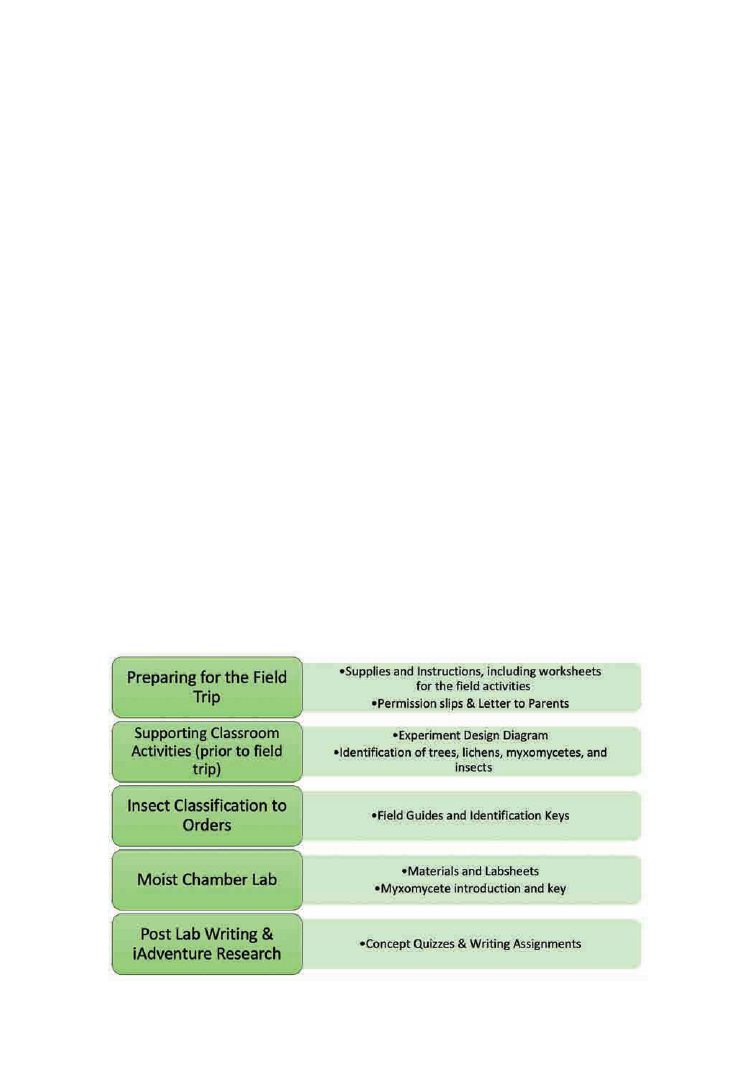
PSB 68 (1) 2022
14
the Director of Biodiversity Informatics at
the Botanical Research Institute of Texas
(BRIT), was able to revive the original website
through GitHub (https://britorg.github.io/
GSMNP_iAdventure). Interested persons can
now access and experience the full content
of the iAdventure in GSMNP, as well as the
Teacher Information Page that has Student
Worksheets related to the collection of field
samples. The intent is to extend the benefits
of these field experiences for students and
teachers worldwide through this linked
inquiry-based iAdventure available as an
interactive web-based activity. Additionally,
historical snapshots of the iAdventure site
can be accessed through Archive.org at:
https://web.archive.org/web/2016*/http://
warrensburg.k12.mo.us/iadventure/
gsmnpiadventure/.
SYNOPSIS OF
iADVENTURE, TEACHER
PREPARATION GUIDE,
AND STUDENT
WORKSHEETS CONTENT
In the summer of 2004, Trish and Stan Smith
arrived at GSMNP, pitched a tent, and recorded
daily activities of the tree canopy research
team as part of the iAdventure. Exploring Life
in the Forest Canopy highlights and tracks the
activities of five undergraduate UCM students
(Amber, Ashley, Cheryl, Erin, and Tommy) as
they participate in the tree-climbing school
at Pertle Springs and the field experience
climbing giant trees in the GSMNP collecting
tree trunk bark samples. On the iAdventure
website, visitors can explore topical headings
such as Research Objectives; GSMNP All Taxa
Biodiversity Inventory, with geographical area
description; Field Trip Organization Pre-trip
Planning; Knott Clinic; Tree Climbing School;
Meet Charly Pottorff, professional arborist;
Figure 2. Summary of resources provided for teachers on the Teacher
Information Page, iAdventure website.

PSB 68(1) 2022
15
meet Dr. Steve Wilson, entomologist world
authority on plant hoppers; meet Dr. Joe Ely,
biometrician and plant ecologist; Field Work,
climbing trees and collecting bark samples,
as well as preparing and raising insect flight
intercept canopy traps; Life at the Research
Station; about Trish and Stan Smith; and
Stories from the Field, about the discovery of a
new tree canopy myxomycete species, Diachea
arboricola, by Melissa Skrabal, among others.
The Teacher Information Page has a list of
resources needed, as well as a list of questions
for students about their observations of the
iAdventure. It also includes links to worksheets
that provide more detailed information about
how to prepare for the field trip, as well as
information about lichens, myxomycetes, and
insects (Figure 2). Some examples included a
List of Field Tasks; Supply List; Tree Tags; Field
Task Instruction Sheets: Meadow Sweepers;
Canopy Catchers; Barking up the Right
Tree; Myxo-O-Masters; Red Cedar Database
Sheet; Lichen Log; Tree Sleuths; Entomology
Worksheet; Insect Identification Key; Moist
Chamber Laboratory Supplies (used for
preparation of moist chamber cultures); Bark
pH Procedure Document; Examination of Moist
Chamber Cultures Labsheet; and Key to the
Myxomycete Orders, among others. Lectures
describing the illustrated myxomycete life
cycle, color images of myxomycete fruiting
bodies using Smart Board presentations,
and question-and-answer sessions enabled
students to interact with the presenter.
References were available for student reading
and picture keying of myxomycete fruiting
bodies observed in moist chamber cultures
(Keller and Braun, 1999).
The two main student activities are nested
under the Title Page (Tier One) and
iAdventure (Tier Two) (Figure 3). The Tier 1
Figure 3. Snapshot of the ‘Site Map’ of the
iAdventure website
iAdventure website allows worldwide access to
the tree canopy field experiences in GSMNP
and the parallel field research at Pertle
Springs. This was a problem-solving activity
that helped students determine the direction
and outcome of a content-rich storyline
using resources available on the internet,
particularly resources providing real-world
data and primary documents. Participating
students should experience the three phases of
research emphasized in the original GSMNP
NSF grant: the Adventure Phase (tree climbing
using ropes and collecting bark samples
for moist chamber cultures (Kilgore et al.,
2008); the Laboratory Phase (sample sorting
and preparation of moist chamber cultures);
and the Publication Phase (poster and oral
platform presentations for local, regional, and
national scientific meetings).
The Tier 2 site emphasizes the collection of
live tree trunk bark of Eastern Red Cedar,
American Elm (Ulmus americana), and
White Oak (Quercus alba) at Pertle Springs.
Students were divided into four groups and
then subdivided into task groups of one or
two students (Figures 4 and 5). UCM faculty
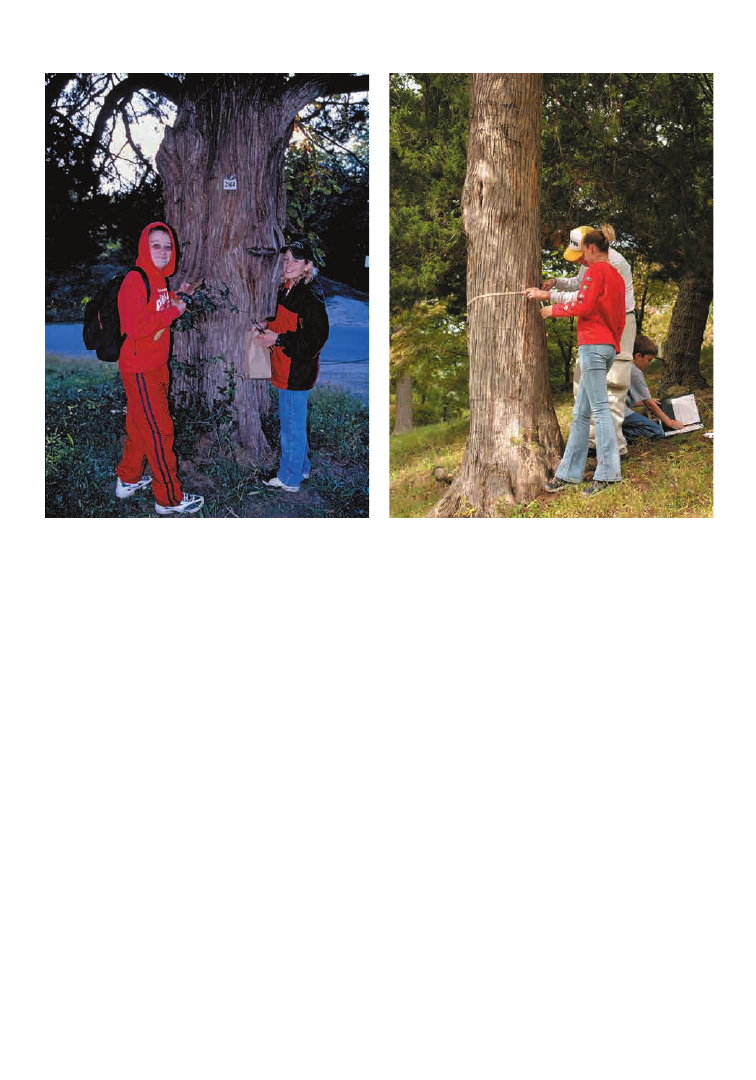
PSB 68 (1) 2022
16
Figure 4. Two seventh-grade WMS students
collecting trunk bark samples from a live East-
ern Red Cedar tree at Pertle Springs. Note tree
tag number, collecting gear, and students enjoy-
ing this field experience. (Photo by H.W. Keller.)
and students from the Biology Department,
along with student parents, assisted with field
collections. Six groups of 20 WMS students
were transported to Pertle Springs for one-
hour field trips on September 28 and 29,
2004, for a total of 240 students. Safety of the
seventh-grade WMS students was a priority.
Therefore, they did not climb trees, use knives,
or shoot slick lines with the Big Shot… much
Figure 5. Author and student measuring tree
trunk diameter of Eastern Red Cedar tree
at Pertle Springs. Note student on ground
recording tree data. (Photo by T. Smith.)
to their dismay! Tree bark samples were
used to prepare moist chamber cultures so
students could observe a miniature ecosystem
composed of myxomycetes, fungi, lichens,
mosses, liverworts, green algae, cyanobacterial
algae, myxobacteria, tardigrades, insects, and
nematodes, among others. This is only an
overview of the two tiers; more information is
available on the website.
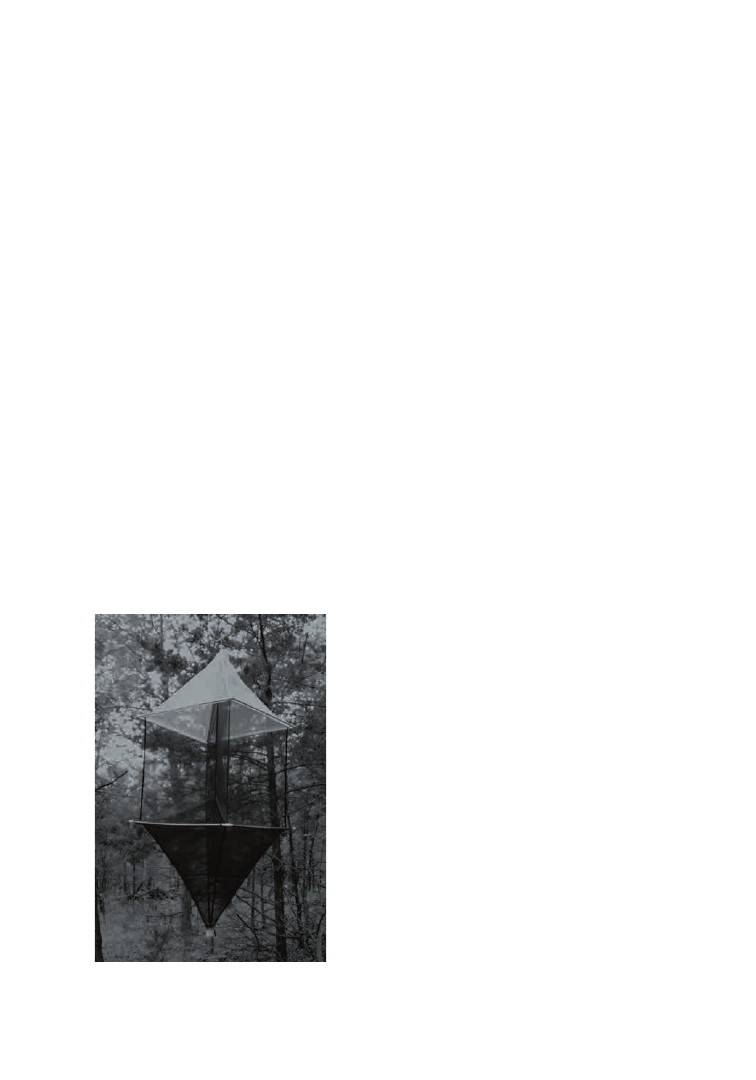
PSB 68(1) 2022
17
INSECT FLIGHT
INTERCEPT TRAPS
Steve Wilson at UCM was in charge of the
aerial installation of the Sante insect flight
intercept tree canopy traps at GSMNP, Big Oak
Tree State Park, and Pertle Springs (Figure 6).
Students assisted in raising the fine-meshed
canopy traps with two open pyramid structures
(9 feet high by 4 feet wide) with a top and
bottom 500-mL collector bottle (killing jar)
filled with 70% isopropyl alcohol. This canopy
trap was tethered to a horizontal branch at 50
to 60 feet for five days. Top canopy collection
bottles tended to trap insects that hit the trap
then climbed upward such as leafhoppers, tree
hoppers and planthoppers, and moths; flies
and beetles tended to hit the trap and drop
downward into the bottom bottle (Wilson et
al., 2003). Students also collected from ground
sites using sweep nets. The collected insect
specimens were used to perfect the taxonomic
keys and create a basis for understanding
diversity and adaptation. .
PERTLE SPRINGS FIELD
COLLECTIONS AND
LABORATORY
PREPARATION OF MOIST
CHAMBER CULTURES
USING LIVE TREE TRUNK
BARK
General credit for the use of moist chamber
bark cultures from living trees goes back to the
early 1930s, when tiny species of myxomycetes
new to science were discovered by graduate
student Henry C. Gilbert working under
the supervision of Professor Dr. George W.
Martin at the University of Iowa Mycological
Laboratory (Gilbert and Martin, 1933; Gilbert,
1934). Since then, many papers and books
have described preparations of moist chamber
cultures that may differ in methodology but
involve wetting field collections of bark from
living trees (Keller, 2004; Keller et al., 2004;
Everhart et al., 2009; Scarborough et al., 2009;
Snell and Keller, 2003), herbaceous plants
(Kilgore et al., 2009), and decaying wood
or leaves from ground sites, usually at times
when myxomycete fruiting bodies are not
present (Keller et al., 2008). This technique
gives the observer the opportunity to create
a self-contained moist environment where
the myxomycete plasmodium and developing
fruiting body stages are present, although they
are not always seen in the field.
Seventh-grade WMS life science students field-
collected live tree trunk bark from Eastern Red
Cedar trees at Pertle Springs (Figures 4 and 5).
This is a short 10-minute bus trip from WMS
to a series of trees that line the paved roadway
at the entrance of the area (Scarborough et al.,
2009). This tree species was targeted because it
Figure 6. Flight intercept tree canopy insect
trap installed in a tree at Pertle Springs. (Photo
by H.W. Keller.)
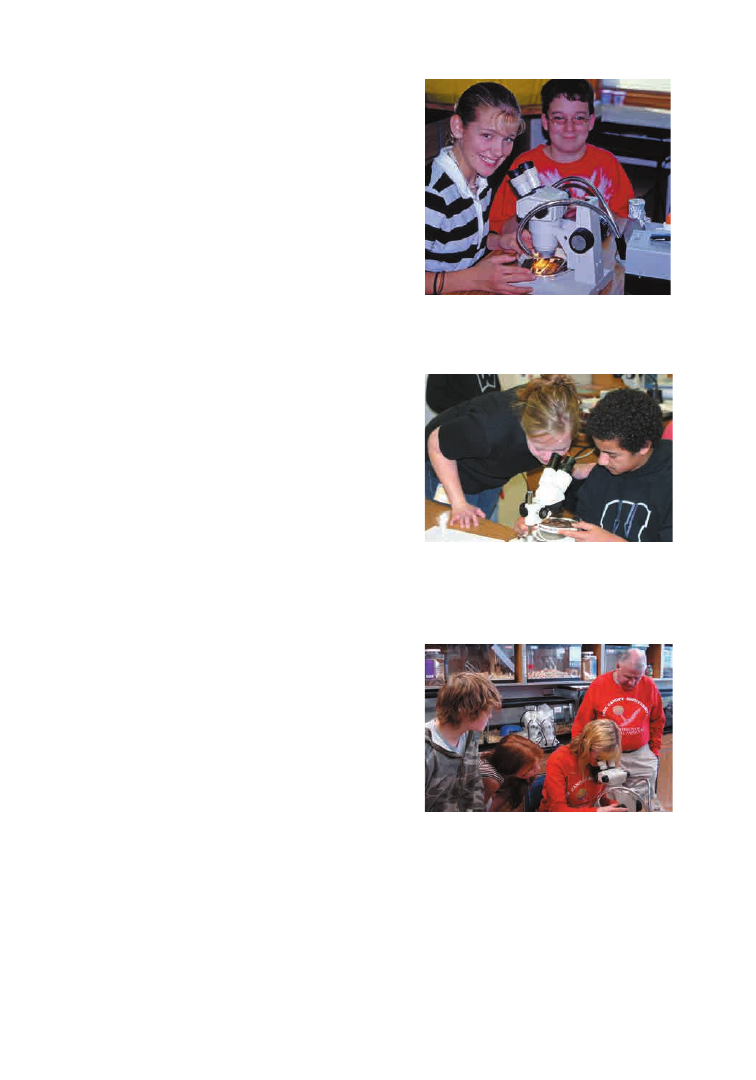
PSB 68 (1) 2022
18
has the highest species diversity of life forms,
which provided students with the best chance
of success observing moist chamber bark
cultures (Keller and Braun 1999; Keller and
Marshall, 2019; Scarborough et al., 2009; Perry
et al., 2020). Two-student team members were
briefed on the safe collection of tree trunk bark
following instructions on Data Worksheets
that recorded species of tree, overall estimated
size of the tree (height and diameter; Figure
5), characteristics of bark surface, presence
of other life forms (for example, lichens), and
height on tree where the bark sample was
collected.
Bark samples collected in paper bags were
transported to the WMS class laboratory,
where students prepared moist chamber
cultures in oversized sterile plastic Petri dishes
(150 × 25 mm) that were lined with sterile
filter paper. About six pieces of bark sample
covering the bottom of the dish were arranged
without overlapping. Thirty mL of sterile
deionized water was added around the bark,
avoiding directly wetting the bark surface
areas. These moist chamber bark cultures
were allowed to soak for 24 hours, and any
excess water was decanted during the next
laboratory period. Observations were made
during normal laboratory class sessions twice
a week for approximately four weeks. Students
recorded pH values using litmus color-coded
papers and observed life forms over this
period using the naked eye and 20 to 50×
power dissecting microscopes (Figures 7–9).
Angela Scarborough (senior undergraduate
student, Figure 8) and Courtney Kilgore
(master’s degree graduate student, Figure 9)
from UCM served as mentors for the seventh-
grade students, helping them locate and
identify life forms in the moist chamber bark
cultures. They were also available to answer
questions about their tree canopy–climbing
experiences in the GSMNP.
Figure 7. Two WMS students scan moist
chamber bark cultures with dissecting
microscope. (Photo by H.W. Keller.)
Figure 8. Undergraduate UCM student Angela
Scarborough assisting WMS students search
for life forms in moist chamber bark culture.
(Photo by H.W. Keller.)
Figure 9. UCM graduate student Courtney
Kilgore scanning moist chamber cultures using
a dissecting microscope. Two WMS students
on the left, and Harold Keller on the right. Note
the red shirts worn by the UCM tree canopy
research team highlighting the iridescent
myxomycete sporangium Diachea arboricola,
a tree canopy species new to science. (Photo by
T. Smith.)

PSB 68(1) 2022
19
MOIST CHAMBER BARK
CULTURE HOW-TO VIDEO
In 2021, the first moist chamber culture
instructional video, How to Create a Moist
Chamber Culture to View the Biodiversity
Growing on Live Tree Bark, was made available
by Ashley Bordelon, Herbarium Digitization
Coordinator, of BRIT’s Urban Ecology
Program. A PDF with accompanying written
instructions is also available and can be
found at https://brit.org/research/research-
projects/urban-ecology-program/ with the
title: Preparation of Moist Chamber Tree Bark
Cultures: A Beginner's Primer for Use at Home
by Ashley Bordelon and Harold W. Keller (Fort
Worth Botanic Garden Botanical Research
Institute of Texas).
This video emphasizes the moist chamber
culture technique using live tree trunk bark
samples and store-bought low-cost supplies
readily available at local stores for teachers,
students, and hobbyists that may want to
use this technique. Many teachers cannot
afford the more expensive supplies used by
the seventh-grade students supplied by an
NSF grant–funded activity and the more
reproducible protocols required by some
publication formats. Nevertheless, this video
was created for teachers and community
enthusiasts based on live trees in their own
backyards or nearby forested areas. Examples
of myxomycete fruiting body development are
highlighted in this video. This moist chamber
technique sometimes results in the discovery
of species new to science, as well as rare
species seldom or never collected in the field
(Keller, 2004; Keller and Marshall, 2019; Perry
et al., 2020). This can be an added incentive
for beginners to share their discoveries with
other myxomycetologists, mycologists, and
botanists.
RESULTS AND
OUTREACH ACTIVITIES
Each fall for a four-year period (2004–2007),
Keller met with six different seventh-grade life
science classes (approximately 120 students)
for a total of 18 hours. More than 500 WMS
students were involved in this teaching activity
over the course of 90 hours. On September 28
and 29, 2004, six groups of 20 WMS students
were transported to Pertle Springs for one-
hour field trips to collect trunk bark samples
from living trees. During much of this time,
Angela Scarborough and Courtney Kilgore
also assisted students (Figures 8 and 9).
These activities were presented in popular
media such as newspapers, television, websites,
and exhibits. For example, UCM highlighted
our research with a color image and short
storyline on the front page of the university
website. The Daily Star Journal ran two color
images under the banner headline featuring
Local Nature Lesson, that described the
seventh-grade life science students collecting
activities at Pertle Springs, and another front-
page article titled Junior Scientists at Work,
showing a color photograph of students and
Dr. Keller observing moist chamber cultures
with a description of the RET-NSF Program.
Local interest in this RET-NSF funded project
was noted in UCM News under the title Grant
Provides Experience in Scientific Research.
Campus Today featured Trish Smith collecting
bark samples, and another article More Than
a Bug’s Life Fascinates, showed students
collecting insects using flight intercept canopy
traps at Pertle Springs. Television station
KMOS, housed at UCM, sent film crews to
shoot footage of WMS students at Pertle
Springs that aired as a five-minute segment
on University Magazine. The RET-NSF
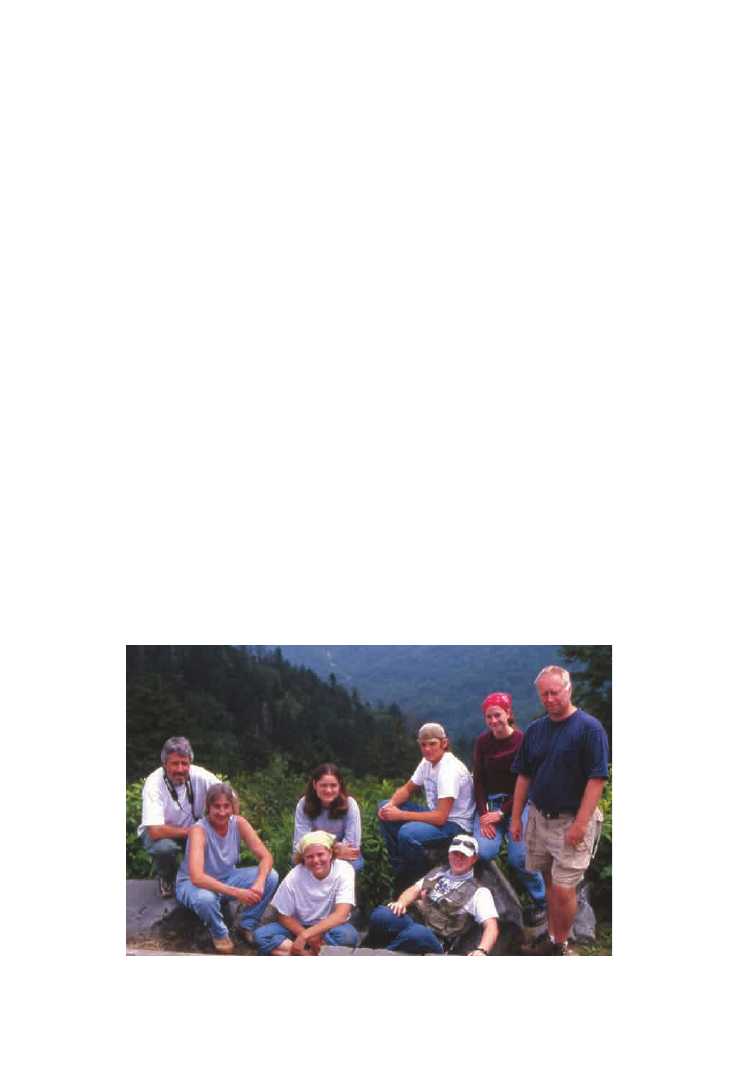
PSB 68 (1) 2022
20
Figure 10. Tree canopy research team in GSMNP. Far left, Stan and Trish Smith; UCM
undergraduate students Amber, Tommy, Ashley back row, bottom row Erin and Cheryl; far right,
Steve Wilson. (Photo by H.W. Keller.)
poster (Keller et al., 2005) presented at the
Fifth International Congress on Systematics
and Ecology of Myxomycetes (ICSEM5) in
Tlaxcala, Mexico, was displayed at WMS and
also at the UCM Morris Science Building.
One striking example of student observations
was the surprise discovery of nematodes.
These attention-getting nematodes, with their
S-shaped wiggling and writhing movements in
thin films of water, were frequently observed
by students in moist chamber cultures from
bark of living trees. Nematodes in some bark
cultures were attached by their posterior ends,
standing and waving in a behavioral pattern
known as nictation. Nematode movements
were also observed in the video of moist
chamber bark cultures highlighted here by
Ashley Bordelon.
Our efforts to involve seventh-grade students
in the research objectives of this project was to
transfer knowledge about how biodiversity is
documented to the next generation of students.
Websites and posters also disseminated field
biology to a broader audience of students and
teachers alike (Figure 10).
CONCLUSIONS
“Teaching has been an extremely rewarding
job in many ways, but bringing the GSMNP
research project into my seventh-grade life
science classroom through the RET Program
is one of my proudest moments,” Trish
Smith said. The highest tribute or reward
Keller could ever receive is the twinkle in
the eyes and glow and smile on the faces of
the seventh-grade life science students at
WMS when they said that “it’s awesome”
or “it’s cool” after observing a myxomycete
sporangium or plasmodium. These students
learned to picture key and recognize different
myxomycete species, insect taxa, and general
life forms of lichens, mostly crustose and
foliose types. The aim of this activity was to
assist and encourage students and teachers to
experience field trips and laboratory exercises
that will create excitement and interest in
exploring, collecting, and discovering life
forms often overlooked in nature.

PSB 68(1) 2022
21
ACKNOWLEDGMENTS
Special thanks go to Trish Smith, who was
responsible for preparing the iAdventure,
Teacher Preparation Guide, Student
Worksheets, and logistics for the student field
experience at Pertle Springs and laboratory
observations. Without her and Stan’s help,
this activity would not have been possible.
Ashley Bordelon used her creative talents
to brainstorm the video content, organize
the visual images, and narrate the moist
chamber instructions. Dr. Joe Ely, ecologist
and biometrician, and Dr. Steve Wilson,
entomologist from UCM, were essential co-
investigators on this research project. Charly
Pottorff, a professional arborist, taught UCM
students the double rope climbing method and
how to shoot the Big Shot at a climbing school
at Pertle Springs. Many people contributed
their volunteer expertise and we thank them
all, including parents, faculty from the UCM
Biology and Education Departments, the
UCM student mentors and tree climbers, and
investigators from other institutions. This
student activity would not have been possible
without the help of many people not named but
who contributed time, effort, cooperation, and
authorship on publications. Multiple grants
provided financial assistance in part from the
National Science Foundation, Discover Life in
America, National Geographic Society, Sigma
Xi, The Scientific Research Honor Society,
Missouri Department of Natural Resources,
the U.S. Department of Education McNair
Scholars Program, and the UCM Summer
Undergraduate Research and Creative Projects
Program. Photographic credits are given after
each photograph, and image release forms
were obtained from all WMS students. We
trust that this spirit of discovery described
here will lead others to explore, enjoy, learn,
and share their results with others.
REFERENCES
Everhart, S. E., J. S. Ely, and H. W. Keller. 2009.
Evaluation of tree canopy epiphytes and bark char-
acteristics associated with the presence of cortico-
lous myxomycetes. Botany 87: 509–517. [Techni-
cal, postgraduate level]
Gilbert, H. C, and G. W. Martin. 1933. Myxomy-
cetes found on the bark of living trees. University
of Iowa Studies in Natural History. Papers on Iowa
Fungi IV 15: 3–8. [Technical, college level]
Gilbert, H. C. 1934. Three new species of
Myxomycetes. University of Iowa Studies in
Natural History. Contributions from the Botanical
Laboratories 16: 153–159. [Technical, college level]
Keller, H. W. 2004. Tree canopy biodiversity:
student research experiences in Great Smoky
Mountains National Park. Systematics and
Geography of Plants 74: 47–65. [General audience,
non-technical]
Keller, H. W. 2005. Undergraduate Research
Field Experiences: Tree Canopy Biodiversity
in Great Smoky Mountains National Park and
Pertle Springs, Warrensburg, Missouri. Council
on Undergraduate Research Quarterly 25: 162–
168. [Invited Paper, for a non-technical, general
audience]
Keller, H. W. 2019. Student team-based tree canopy
biodiversity research in Great Smoky Mountains
National Park. Plant Science Bulletin 65: 28–37.
[General audience]
Keller, H. W. and K. L. Braun. 1999. Myxomycetes
of Ohio: Their Systematics, Biology and Use in
Teaching. Ohio Biological Survey Bulletin New
Series Volume 13, Number 2. [High school and
college level]
Keller, H. W., C. M. Kilgore, S. E. Everhart, G. J.
Carmack, C. D. Crabtree, and A. R. Scarborough.
2008. Myxomycete plasmodia and fruiting bodies:
unusual occurrences and user-friendly study
techniques. Fungi 1: 24–37. [All age groups]

PSB 68 (1) 2022
22
Keller, H. W. and V. M. Marshall. 2019. A new
iridescent corticolous myxomycete species (Licea:
Liceaceae: Liceales) and crystals on American elm
tree bark in Texas, U.S.A. Journal of the Botanical
Research Institute of Texas 13: 367–386. [Technical,
for university level graduate students and teachers]
Keller, H. W., M. Skrabal, U. H. Eliasson, and
T. W. Gaither. 2004. Tree canopy biodiversity
in the Great Smoky Mountains National Park:
ecological and developmental observations of a
new myxomycete species of Diachea. Mycologia
96: 537–547. [College level]
Keller, H. W., S. W. Wilson, and P. A. Smith. 2005.
Research Experience for Teachers-National Science
Foundation: Biodiversity Survey (Myxomycetes
and Insects) of Pertle Springs, Warrensburg,
Missouri, by 7th Grade Life Science Students.
5th International Congress on Systematics and
Ecology of Myxomycetes (ICSEM5). Tlaxcala,
Mexico, Universidad Autonoma de Tlaxcala,
pp. 47–48 (Abstract, Poster Presentation #35).
[General audience]
Kilgore, C. M., H. W. Keller, and J. S. Ely. 2009.
Aerial reproductive structures on vascular plants
as a microhabitat for myxomycetes. Mycologia 101:
303–317. [Technical, college, graduate student level.
First study of myxomycetes on herbaceous prairie plants.]
Kilgore, C. M., H. W. Keller, S. E.
Everhart, A. R. Scarborough, K. L. Snell, M.
S. Skrabal, C. Pottorff, and J. S. Ely. 2008.
Research and student experiences using the
doubled rope climbing method. Journal of the
Botanical Research Institute of Texas 2: 1309–1336.
[High school and college level]
Perry, B. A., H. W. Keller, E. D. Forrester, and B. G.
Stone. 2020. A new corticolous species of Mycena
section viscipelles (Basidiomycota: Agaricales)
from the bark of a living American elm tree in
Texas, U.S.A. Journal of the Botanical Research
Institute of Texas 14: 167–185. [College Level,
Technical]
Scarborough, A. R., H. W. Keller, and J. S. Ely. 2009.
Species assemblages of tree canopy myxomycetes
related to pH. Castanea 74: 93–104. [Technical
for college students and teachers. Description of
GSMNP and Pertle Springs]
Smith, P. A. and H. W. Keller. 2004. National
Science Foundation Research Experience for
Teachers (RET). Inoculum 55: 1–5. [All age groups]
Snell, K. L. and H. W. Keller. 2003. Vertical
distribution and assemblages of corticolous
myxomycetes on five tree species in the Great
Smoky Mountains National Park. Mycologia 95:
565–576. [Technical, college level. The first tree
canopy study of cryptogams and myxomycetes using
rope-climbing techniques in the USA.]
Wilson, S. W., N. M. Svatos, and H. W. Keller.
2003. Canopy insect biodiversity in a Missouri
State Park. What’s Up? The Newsletter of the
International Canopy Network 10: 4–5. [Technical,
college level]
ADDITIONAL RELATED
PUBLICATIONS NOT CITED
Alexopoulos, C. J. and J. Koevening. 1964. Slime
molds and research. American Institute of Bio-
logical Sciences. Biological Sciences Curriculum
Studies BSCS Pamphlet 13. Boston. D.C. Heath
and Company. 36 p. [High school and college level,
targeted for teachers]
Carson, M. K. 2003. Fungi. Newbridge Education-
al Publishing. 21 pp.; see pp. 16, 17 for myxomy-
cetes. [Elementary and middle school level, part of
Ranger Rick Series]
de Hann, M. 2005. The Adventures of Mike the
Myxo. English Translation by Henry Becker. Bel-
gium KMAK. The Royal Antwerp Mycological So-
ciety. 14 p. [Elementary school level]
Keller, H. W. and T. E. Brooks. 1976. Corticolous
Myxomycetes V: Observations on the genus Echi-
nostelium. Mycologia 68: 1204–1220. [Technical,
college level]

PSB 68(1) 2022
23
Keller, H. W., and T. E. Brooks. 1977. Corticolous
Myxomycetes VII: Contribution toward a mono-
graph of Licea, five new species. Mycologia 69:
667–684. [Technical, college level]
Keller, H. W. and S. E. Everhart. 2006. Myxo
my-
ce
tes (True Slime Molds): Educational Sources for
Students and Teachers – Part I. Inoculum 57: 1–2.
and part II. Inoculum 57: 4–5. [All age groups
]
Keller, H. W. and S. E. Everhart. 2010. Importance
of Myxomycetes in biological research and
teaching. Fungi 3: 29–43. [All age groups,
targeted for teachers. This is the most cited article
on myxomycetes, first posted June 2016 on the
University of Nebraska Digital Commons and as of
February 2022 with 4,290 downloads, running at
more than 100 hits per month.]
Lloyd, S. J. 2014. Where the slime mould
creeps: the fascinating world of myxomycetes.
Tympanocryptis Press, Tasmania, Australia. 102
p. [Spectacular photography, text written for all age
groups. On pp. 40 and 41, two Slime Mould Rounds
are set to music.]

PSB 68 (1) 2022
24
By Stephen R. Stern
1,3
, Nora S. Oviatt
1,2,
, and Grace E. Gardner
1,2
1
Department of Biological Sciences, Colorado Mesa University, 1260 Kennedy Ave,
Grand Junction, CO 81501, USA
2
Undergraduate students at Colorado Mesa University that conducted the study
3
Author for correspondence: sstern@coloradomesa.edu
Abstract
Research experiences benefit undergraduates and
citizen scientists alike, and new resources allow for new
research opportunities. With the expansion of online
databases, current understanding of plant distributions
is better than it has ever been. Database resources
also show gaps in species distribution and allow rapid
identification of areas that are under-collected. Targeted
collecting of common but often overlooked plant
species is an excellent way to engage undergraduates
and citizen scientists. Here we provide an example
of targeted plant collecting by undergraduates that
resulted in 118 collections made over four days in Ouray
County, Colorado. These collections resulted in 34 new
country records not listed in the Flora of Colorado and
15 new county records not listed on SEINet.
Filling in the Gaps: Targeted Plant
Collection by Undergraduates and
Citizen Scientists to Better
Understand Plant Distribution
Key words
citizen science, Colorado, flora, species
distribution, undergraduate
Course-based Undergraduate Research
Experiences (CUREs) and outreach to the public
through citizen-science projects have become
increasingly common (AAAS, 2011; Dolan,
2016). Applications like iNaturalist have
millions of users around the globe, showing
that there is a strong interest in participating
in science (iNaturalist.org). Research can
help form beneficial collaborations between
amateurs and professionals, increase scientific
communication and engagement, and help
prepare the next generation of scientists. In
the botanical sciences, a variety of methods
has been used to engage high school students
(Ragostra et al., 2020), undergraduates (Ward
et al., 2014; Mitchell et al., 2017), and citizen
scientists (Boho et al., 2020).

PSB 68(1) 2022
25
One area ripe for research by amateurs
is utilizing online database resources.
Online databases, such as SEINet (www.
swbiodiversity.org) and the USDA PLANTS
database (https://plants.sc.egov.usda.gov/
java/), as well as traditional floras, allow
unprecedented access to plant distributions.
Mapping tools on online databases allow
users to rapidly assess plant distributions
and visualize areas that are likely habitat
for plant species but currently do not have
specimen records. Impetus for this study
began with observation of distribution maps
in the Flora of Colorado (Ackerfield, 2015)
where it was noted that Ouray County was
often a gap in species distribution maps.
Further investigation using online databases
showed that although Ouray County has been
moderately well collected compared to other
areas in western Colorado, many common
species have not been collected in this county.
Targeted collecting not only increases
understanding of species distribution, but
also benefits amateur botanists. While many
scientists use online databases, these resources
are often unknown or underutilized by the
general public. Training amateur botanists
to use online resources and technical keys,
to plan and implement a plant collecting trip,
and to process and curate specimens in the
herbarium, broadens interest in botany and
trains the next generation of botanists. Not
only are valuable data collected and made
available to scientists via databases such as
SEINet, but these studies also help to form
collaborations between scientists and plant
enthusiasts. The goals of this study were to (1)
collect specimens to fill in the gaps of species
distribution in Ouray County, Colorado, (2)
engage undergraduates in plant collecting,
and (3) provide a model for other scientists
working with undergraduate or citizen
scientists.
MATERIALS AND
METHODS
This study was conducted as part of a summer
undergraduate research project led by Dr.
Stephen Stern supervising undergraduate
students Nora Oviatt and Grace Gardner. All
aspects of the project were performed by the
two undergraduate students. To become more
familiar with the area prior to collecting, the
Flora of Colorado (Ackerfield, 2015) was
used to compile a list of plants that had not
previously been collected in Ouray County.
Emphasis was given to plants that were present
in two or more neighboring counties on maps
in the Flora and therefore likely to be present in
Ouray County. The list included plant family,
common name, scientific name, elevation
range, and flowering time. This list was then
used to identify collecting sites, including
a wide range of habitats and elevations, to
maximize species diversity. Collection sites
included pinyon-juniper forests, subalpine
meadows, riparian areas, parking lots, and
other disturbed areas to include common and
invasive species (Figure 1).
Collections were made in Ouray County,
Colorado on July 14-17, 2020 by Nora Oviatt
and Grace Gardner, two undergraduates at
Colorado Mesa University in Grand Junction,
Colorado. Areas collected included a variety
of habitats, elevation ranges, and moisture
gradients (Figure 2). Plants were collected if
they were known to be missing from Ouray
County or if their identity was unknown.
Plant specimens were pressed and locality
information including GPS coordinates and
elevation was collected, along with habitat
and plant characteristic data.
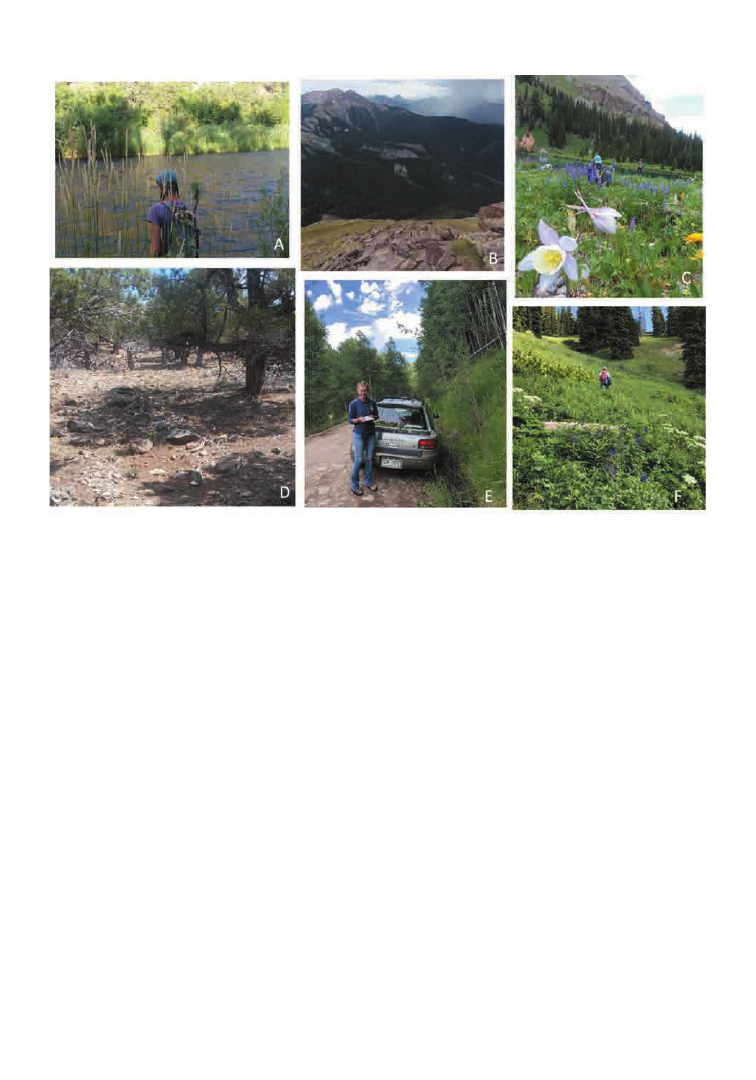
PSB 68 (1) 2022
26
After collecting, the undergraduates identified
unknown plants using the Flora of Colorado
(Ackerfield, 2015). Plant specimens were
mounted onto herbarium paper with a label
including all specimen data and deposited
in the Walter A. Kelley Herbarium at
Colorado Mesa University. Specimen data
were entered in the Intermountain Region
Herbarium Network database (https://
intermountainbiota.org/portal/). Collections
were compared with distribution maps in
the Flora of Colorado (Ackerfield, 2015)
and SEINet (https://intermountainbiota.org/
portal/) to identify collections that were new
county records.
RESULTS
Over the course of four days of collecting in
Ouray County, 118 collections representing
99 species were made from a variety of
localities and habitats (Figures 1 and 2).
These species represent both native and
introduced, naturalized species. The goal
of this project was to provide herbarium
specimens to increase understanding of plant
distribution. Herbarium specimens collected
for this project represent 34 new county
records for Ouray County (Table 1) when
compared to distribution maps in the Flora
of Colorado (Ackerfield, 2015). Collections
Figure 1. Diversity of Habitats in Ouray County. (A) Nora Oviatt by the Uncompahgre River.
(B) Top of Courthouse Mountain. (C) Nora Oviatt in meadow by lower Blue Lake. (D) Pinyon-
Juniper habitat at the Ridgeway Area Trails. (E) Grace Gardner collecting in roadside habitat
along Ouray County Road 10. (F) Grace Gardner on Courthouse Mountain Trail.
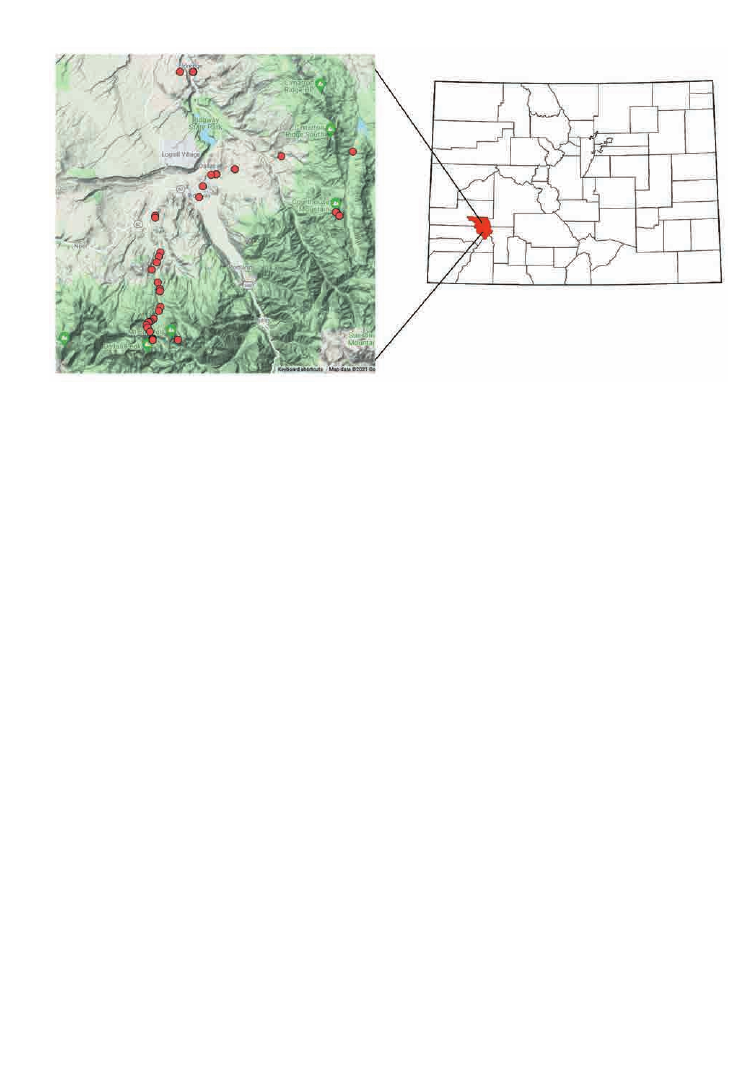
PSB 68(1) 2022
27
were also compared with SEINet (https://
intermountainbiota.org/portal/), a regularly
updated database. Based on SEINet search
results in July 2021, the collections made in
this study represent 15 new county records for
Ouray County, Colorado (Table 1).
DISCUSSION
While much of the flora of the United States
is well-represented in herbaria, there are
significant gaps in understanding species
distributions. As the results show, a four-day
collecting trip by two undergraduates yielded
numerous new county records, indicating
that this research is beneficial in building
knowledge of species distributions. The
discrepancy in the number of new records
when comparing the distribution maps in
the Flora of Colorado versus SEINet can be
attributed to the fact that SEINet is continually
being updated. Databasing projects, such as
the NSF-funded databasing project focused
on plants of the Southern Rockies (https://
www.soroherbaria.org/portal/; Tripp et al.,
2017), have added many new records since
the publication of the Flora of Colorado.
Despite this influx of new databased records,
many areas still lack sufficient representation
by herbarium specimens.
Of the 118 collections, 34 represented
new county records based on the Flora of
Colorado and 18 represented new county
records based on SEINet (Table 1). In Ouray
County, some species were expected, such as
Convolvulus arvensis (field bindweed) that is
represented in all surrounding counties but
was lacking in Ouray County in the Flora
of Colorado distribution maps. Centaurea
stoebe (spotted knapweed) is listed as a class
B noxious weed in Ouray County (https://
ouraycountyco.gov/155/Weed-Control) but
had not previously been collected and was
not represented on SEINet or in the Flora of
Figure 2. Map of Colorado with Ouray County highlighted in red (right) with zoomed in map of
Ouray County including the towns of Ridgeway and Ouray showing collection sites (left). Red
points represent collections sites. Between 1 and 31 collections were made at each site.
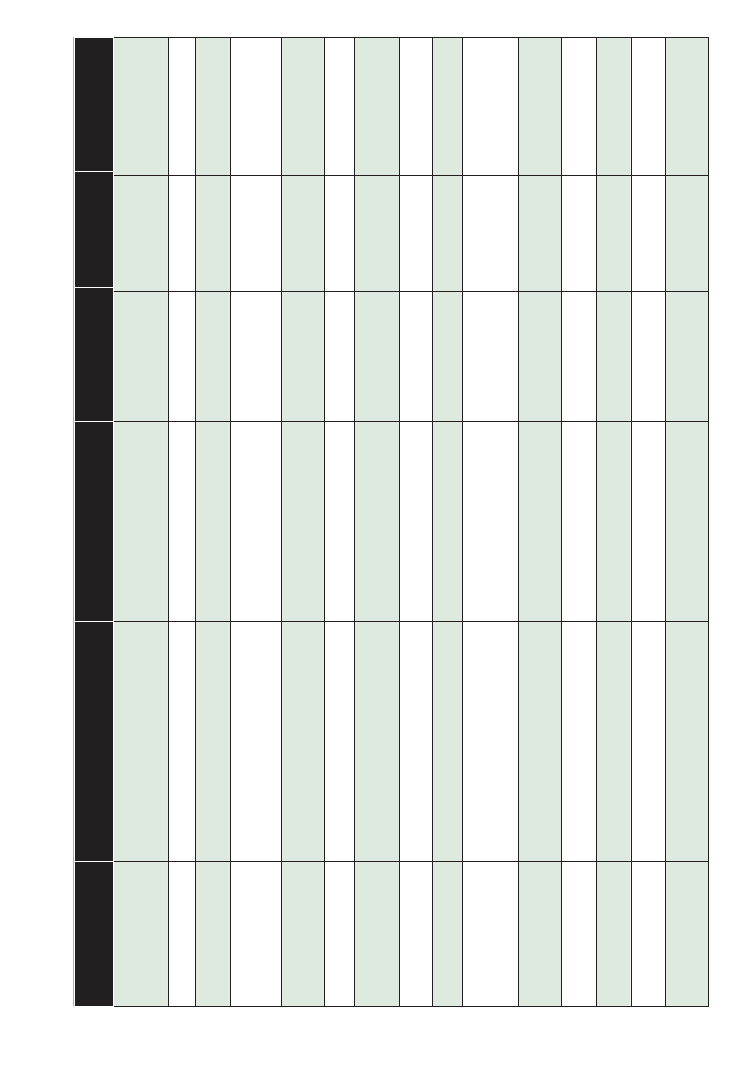
Fa
mi
ly
Sci
en
tifi
c N
ame
C
ommo
n na
me
N
ew t
o
Acke
fie
ld?
N
ew t
o
SEIN
et?
C
ol
le
ct
io
n
nu
mb
er
A
m
ara
nt
hace
ae
At
rip
lex c
an
es
cens
(Pur
sh.) N
ut
t.
Fo
ur
-w
in
g Sa
ltb
us
h
ye
s
N. O
vi
at
t 73
Ap
iace
ae
Ang
eli
ca
p
in
na
ta
S. W
ats
on
Sm
al
l-w
in
g A
ng
elic
a
ye
s
ye
s
G. Ga
rdn
er 129
Ap
oc
yn
ace
ae
As
clep
ia
s s
pe
cio
sa
To
rr
.
Sh
ow
y M
ilk
w
eed
ye
s
ye
s
G. Ga
rdn
er 171
A
sterace
ae
Ca
rd
uu
s n
ut
ans
L.
M
us
k Thi
stle
ye
s
G. G
ar
dn
er 173
;
N. O
vi
att 102
A
sterace
ae
Ce
nta
ur
ea
sto
eb
e su
bsp
. m
icr
an
th
os
(S.G.G
m
elin ex. G
ug
ler) H
ay
ek
Sp
ot
ted
K
na
pw
eed
ye
s
N. O
vi
at
t 77
A
sterace
ae
Ci
ch
or
ium
in
ty
bu
s L.
C
omm
on C
hico
ry
ye
s
ye
s
G. Ga
rdn
er 179
A
sterace
ae
Er
ig
er
on
ph
ila
de
lph
icu
s v
ar
.
ph
ila
de
lph
icu
s L.
Phi
lade
lp
hi
a Fle
ab
an
e
ye
s
ye
s
G. Ga
rdn
er 112
A
sterace
ae
H
eli
an
thu
s a
nnu
us
L.
C
omm
on S
unflo
w
er
ye
s
G. Ga
rdn
er 147
A
sterace
ae
La
ct
uc
a s
er
rio
la
L.
Pr
ic
kl
y L
et
tuce
ye
s
ye
s
G. Ga
rdn
er 168
A
sterace
ae
So
lid
ago n
em
or
al
is
su
bsp
. d
ec
emfl
or
a
(D
C.) B
ra
mm
al
l ex S
em
ple
G
ra
y G
oldenr
od
ye
s
ye
s
N. O
vi
at
t 108
A
sterace
ae
Sy
m
ph
yo
tri
ch
um
ci
lia
tum
(L
ede
b.)
G.L. N
es
om
Ra
yles
s A
lka
li A
ster
ye
s
ye
s
G. Ga
rdn
er 175
A
sterace
ae
Tet
rad
ym
ia
ca
ne
sce
ns
DC
C
om
m
on
H
or
se
br
us
h
ye
s
ye
s
G. Ga
rdn
er 111
C
on
vo
lvu
lace
ae
Con
vol
vu
lu
s a
rv
en
sis
L.
Fie
ld B
in
dw
ee
d
ye
s
N. O
vi
at
t 75
Cyp
erace
ae
Ca
rex r
ay
no
ld
sii
D
ew
ey
Ra
yn
old's S
edg
e
ye
s
ye
s
N. O
vi
at
t 113
Cyp
erace
ae
Sc
irp
us
va
lidu
s V
ahl
So
fts
tem B
ulr
us
h
ye
s
ye
s
G. Ga
rdn
er 115
Table 1.
List of collections fr
om Ouray County that r
epr
esent new county r
ecor
ds for the Flora of Colorado (Ackerfield, 2015) and SEINet.

Fa
bace
ae
As
tra
ga
lu
s ci
cer
L.
Chic
kp
ea M
ilk
vet
ch
ye
s
G. Ga
rdn
er 170
Fa
bace
ae
M
ed
ica
go s
at
iv
a
L.
A
lfa
lfa
ye
s
G. Ga
rdn
er 117
Fa
bace
ae
M
eli
lo
tu
s a
lba
M
edi
k.
W
hi
te S
w
eet C
lo
ver
ye
s
G. Ga
rdn
er 113
Fa
bace
ae
Tr
ifol
iu
m
pr
ate
ns
e L.
Re
d C
lo
ver
ye
s
G. Ga
rdn
er 139
G
era
ni
ace
ae
Er
odium
ci
cu
ta
rium
(L.) L'H
er
. ex
A
it.
Fi
la
ria
ye
s
G. Ga
rdn
er 109
M
al
vace
ae
Si
da
lce
a ne
ome
xi
ca
na
A. G
ra
y
Ro
ck
y M
oun
ta
in C
he
ck
er
-
Bl
oom
ye
s
G. Ga
rdn
er 142;
N. O
vi
at
t 78
N
yc
ta
gin
ace
ae
M
ira
bi
lis
lin
ea
ris
(Pur
sh) H
eim
er
l
N
ar
ro
w
le
af F
our O'C
lo
ck
ye
s
G. Ga
rdn
er 177
On
ag
race
ae
Ch
am
er
io
n l
at
ifo
lium
(L.) H
ol
ub
D
wa
rf Fir
ew
ee
d
ye
s
N. O
vi
at
t 91
On
ag
race
ae
Ep
ilob
ium
h
or
ne
m
an
nii
R
ch
b.
H
or
nem
ann's W
illo
w-h
erb
ye
s
N. O
vi
at
t 114
Or
ob
an
ch
ace
ae
Pe
di
cu
la
ris p
ro
cer
a
A. G
ra
y
Gi
an
t L
ou
se
wo
rt
ye
s
N. O
vi
at
t 88
Phr
ym
ace
ae
M
im
ulu
s t
illing
ii
Re
ge
l
Su
ba
lp
in
e M
on
ke
y-Flo
w
er
ye
s
ye
s
N. O
vi
at
t 117
Pl
an
ta
gin
ace
ae
Pl
an
ta
go tw
ee
dy
i A. G
ra
y
Tw
ee
dy's P
la
nt
ain
ye
s
ye
s
G. Ga
rdn
er 116
Po
ace
ae
Ag
ro
py
ron
cr
ista
tu
m
(L.) Gaer
tn.
Cr
es
te
d W
he
at
gra
ss
ye
s
G. Ga
rdn
er 148
Po
lyg
on
ace
ae
Er
iogo
nu
m m
icr
ot
he
ca
va
r. l
axi
flo
ru
m
Ho
ok
.
Slen
der B
uc
kw
he
at
ye
s
ye
s
G. Ga
rdn
er 110
Ros
ace
ae
Cr
at
ae
gu
s s
uc
cu
len
ta
Sc
hrad
.
Ro
ck
y M
oun
ta
in H
awt
ho
rn
ye
s
ye
s
N. O
vi
at
t 81
Ros
ace
ae
Po
ten
til
la p
la
ttens
is
Nu
tt.
Pl
at
te R
iv
er Cin
quef
oi
l
ye
s
ye
s
G. Ga
rdn
er 130
Ros
ace
ae
Sa
ng
ui
so
rb
a m
in
or
S
co
p.
Ga
rden B
ur
net
ye
s
G. Ga
rdn
er 176
Sa
lic
ace
ae
Po
pu
lu
s d
eltoi
de
s W
. B
ar
tra
m ex
M
ar
sh
all
C
ot
to
nw
ood
ye
s
G. Ga
rdn
er 172
Typ
hace
ae
Ty
ph
a l
at
ifol
ia
L.
Br
oad
le
af C
at
ta
il
ye
s
N. O
vi
at
t 79

PSB 68 (1) 2022
30
Colorado. This work also expanded the known
range of species, such as Mimulus tillingii
(subalpine monkeyflower) and documented
previously unknown populations.
This study focused on an under-collected area
of western Colorado. Ouray County (542 mi
2
)
is represented on SEINet by 6885 collections.
Many other significant gaps remain in the Flora
of Colorado. For example, in northeastern
Colorado, Sedgwick County (549 mi
2
) has
913 collections on SEINet, Philips County
(688 mi
2
) has 628 collections on SEINet, and
Crowley County (800 mi
2
) has 459 collections
on SEINet. Similar collection projects in
these counties would add many new species
records to SEINet and the Flora of Colorado.
In Colorado, it appears that areas further from
population centers and universities generally
have fewer plant collections. However, even
urban areas can be under-collected, such as
Broomfield County (33 mi
2
), which only has
12 collection records on SEINet. This trend is
likely similar in other areas, and mapping tools
on sites like SEINet or the USDA PLANTS
database can provide localities for similar
projects in other states.
In addition to increasing scientific
understanding, this research is a useful
teaching tool for undergraduates and citizen
scientists. The planning, collection, and
specimen preparation described above was
led by undergraduates. Students had to plan
an “expedition,” determine logistics, research
distributions using databases, collect plants in
the field, identify plants, prepare specimens,
and database specimens. While there was
guidance from a professor, the implementation
of all aspects was done independently by
students. Although this project was a trail run,
occurred outside of a class, and only included
two undergraduates, all of the components of
the project could easily be incorporated into
a plant identification or plant systematics
course and would make an excellent CURE.
This could also be implemented as a project
for native plant enthusiasts where interested
participants have many of the skills but may
not know how they can contribute to the
scientific community. The Colorado Native
Plant Society (CONPS.org) frequently has
“bioblitz” events, but independent, guided
collecting in targeted areas would allow
enthusiasts to conduct investigations on their
own schedule, would allow more flexibility,
and would encourage revisiting sites to collect
plants throughout the growing season.
While targeted collecting can be largely
independent, there are some logistics that
require oversight. The undergraduates
involved in the project were well-versed in
plant identification and collecting methods
but found the planning and implementation
of their own collecting trip to be the most
difficult, but also most rewarding, aspect of
the project. For supervisors, knowing the
abilities of students and adjusting the level
of supervision accordingly is crucial. For
example, some students may have more
difficulty with plant identification and need
additional help in this area. This study only
included two undergraduates, so as the group
size increases there would likely be more
challenges managing larger cohorts. However,
this also provides a great opportunity for group
work. Collecting must follow state and federal
restrictions, with care taken to avoid private
property, protected areas, and protected
plants. Arrangements should be made for
herbaria to receive specimens, and there
should be oversight during the databasing
process. In lieu of making collections, amateur
botanists could make observations along with
photographic evidence (as is done with the
iNaturalist app). While this reduces specimen
preparation, it presents challenges for correct
identification and makes verification much

PSB 68(1) 2022
31
more difficult. With either collections or
observations, amateur botanists may need
assistance identifying difficult taxa. Each
of these steps requires oversight but can be
“teachable moments” to help train the next
generation of botanists. Coupling the passion
and enthusiasm of amateur botanists with the
oversight and guidance of professional can
greatly benefit both.
ACKNOWLEDGMENTS
The authors thank Colorado Mesa University
for support and herbarium space; the
Saccomanno Higher Education foundation for
their support of Grace Gardner through the
Saccomanno Internship Program in Biological
Research and the Grand Junction Field Office
of the Bureau of Land Management; Jennifer
Ackerfield for her excellent Flora of Colorado
that spurred this research; and Dr. Mackenzie
Taylor and two anonymous reviewers for their
suggestions to improve this manuscript.
AUTHOR
CONTRIBUTIONS
Dr. Stephen Stern supervised the planning and
implementation of this research and prepared
the manuscript. Undergraduates Nora Oviatt
and Grace Gardner conducted fieldwork,
identified and prepared plant specimens,
databased specimens, and reviewed the
manuscript.
DATA AVAILABILITY
All specimen data are available online through
the SEINet portal at intermountainbiota.org.
REFERENCES
Ackerfield, J. 2015. Flora of Colorado. Botanical
Research Institute of Texas.
American Association for the Advancement of Sci-
ence (AAAS). 2011. Vision and Change: A call to
action, Final Report, Washington DC.
Boho, D., M. Rzanny, J. Wäldchen, F. Nitsche, A.
Deggelmann, H. C. Wittich, M. Seeland, and P.
Mäder. 2020. Flora Capture: a citizen science appli-
cation for collecting structured plant observations.
BMC Bioinformatics 21: 576.
Dolan, E. L. 2016. Course-based undergraduate re-
search experiences: Current knowledge and future
directions. Washington DC: National Research
Council.
Mitchell, N., M. Triska, A. Liberatore, L. Ashcroft,
R. Weatherill, and N. Longnecker. 2017. Benefits
and challenges of incorporating citizen science
into university education. PLoS One 12: e0186285.
Ragosta, S., D. Potter, and H. Bartosh. 2020. Broad-
ening Student Perceptions of Science through Par-
ticipatory Data Collection and Research-education
partnerships: A case study in California’s Central
Valley. The American Biology Teacher 82: 8.
Tripp, E., D. Clark, and J. Allen. 2017. Digitization
TCN: Using herbarium data to document plant
niches in the high peaks and high plains of the
southern Rockies-Past, Present and Future. Na-
tional Science Foundation award 1702516.
Ward, J., H. Clarke, and J. Horton. 2014. Effects
of a Research-Infused Botanical Curriculum on
Undergraduates’ Content Knowledge, STEM
Competencies, and Attitudes toward Plant Sciences.
CBE-Life Sciences Education 13: 387–396.

PSB 68 (1) 2022
32
The National Science Foundation–funded
conference grant “The Future of Botany:
Educating for a Diverse and Inclusive 21st
Century Workforce” (NSF DBI-1929435, $64K,
Adams & Krakos, 2019–2021) has ended after
supporting three years of Botany conference
activities related to strategic efforts to broaden
participation and teach inclusively. Originally
a single-year award, BSA received a no-cost
extension to continue to provide support for
activities and participation by community
college/tribal college and university (CC/
TCU) faculty and undergraduates at the 2020
and 2021 virtual Botany conferences. The
project had three main goals:
1. To support CC/TCU faculty to attend and
participate in the Botany conference to help
more effectively recruit, retain, and support a
diverse and inclusive next generation of plant
scientists
2. To support additional undergraduate
students primarily from CC/TCU institutions
to attend and participate in the Botany
conference as part of the existing PLANTS
mentoring program for students from
underrepresented minority groups.
3. To develop, deliver, and promote diversity
and inclusion programming at the Botany
conference for all attendees.
The Future of Botany:
Educating for a Diverse and
Inclusive 21st-Century Workforce
By Kyra N. Krakos, Catrina Adams, Matt Haberkorn, Adolfina Koroch,
Sonali Saha, Karen Wellner, and Daniel Wright
The grant supported a coordinated Diversity
and Inclusion (D&I) initiative starting at
Botany 2019 by integrating several new
sponsored activities with ongoing DEI and
Education activities (including the NSF-
supported PLANTS Botany conference
mentoring program and programming
developed by the BSA’s DEI committee,
Education Committee and Teaching Section).
The co-PIs, Catrina Adams and Kyra Krakos,
worked with an advisory board including
Ann Sakai, Muriel Poston, Mike Barker, Jim
Cohen, Chris Martine, and Anna Monfils to
create a set of activities centered around D&I
needs of Botany, and to recruit participating
speakers, students, and faculty.
This article is a summary of the activities and
impact of the grant, enhanced with personal
experiences and insights shared by five co-
authors: Matt Haberkorn (Phoenix College,
AZ); Adolfina Koroch (Borough of Manhattan
Community College, NY); Sonali Saha (Miami
Dade College, FL); Karen Wellner (Chandler-
Gilbert Community College, AZ); and Daniel
Wright (Pima Community College, AZ), who
were faculty participants in the initiative over
several years.

PSB 68(1) 2022
33
DIVERSITY AND
INCLUSION INITIATIVE
BEGINS AT BOTANY 2019
IN TUCSON, ARIZONA
The grant sponsored some new programming
at Botany 2019 in Tucson, AZ open to all
conference attendees including:
1. A Special Session titled “Educating for a
Diverse and Inclusive Community in Botany
for the 21st Century,” featuring talks by
invited speakers Teresa Newberry (“The Role
of Tribal Colleges in Promoting a Diverse
and Inclusive Community in Botany”),
Anthony DePass (“Increasing Diversity in
STEM: Bridging Practice and Scholarship”),
Monica Gaughan (“The Ecological Fallacy
and Why Botanists Still Need to Understand
Student Demographics”), and Pamela Soltis
(“Engaging a Diverse Biodiversity Workforce
through Natural History Collections”), and
including a moderated discussion between
the audience and speakers;
2. A workshop on inquiry-based learning in
plant science led by Gordon Uno and Marsh
Sundberg, with an emphasis on exchanging
best practices and ideas on methods for
engaging students with diverse backgrounds
in learning science using plants; and
3. A special contributed paper section in the
Teaching Section with a specific emphasis
on inclusive pedagogical practices in various
institutional settings. All of these activities
took place at Botany 2019 meetings in
Tucson, AZ.
In 2019, the grant was able to support 13
CC/TCU faculty to attend Botany and
participate in the Initiative’s activities. In
addition to attending the activities open to
all Botany attendees, participants attended an
orientation/meet-and-greet to allow others
from the BSA community to welcome and get
to know the grant participants, as well as to
introduce the conference activities and answer
any questions. The participants also attended
a working dinner to process and discuss
what they’d learned and to discuss options
for continued participation and networking
beyond the Botany conference.
Post-conference, CC/TCU faculty participants
were asked to respond to a prompt about
what they gained from participating in the
conference. New perspectives on teaching
were mentioned by several faculty. Several
faculty mentioned that the workshop led by
Uno and Sundberg was a highlight for them.
One wrote, “The workshop on broadening
pathways changed my whole perspective
on teaching, so now I focus on making my
classes more equitable, not just inclusive,
understanding that students all start in
different places.” Another responded, “The
2019 Botany meeting provided me with a
significant amount of teaching processes,
activities as well as accessible research
questions that can be covered in a typical
community college class...as a result, we
have seen students interest and engagement
increase in some of our course-based
research programs...I attribute this to making
research-based course projects accessible,
understandable, and multidisciplinary for our
students.” A third contributed an anecdote
about how a workshop activity sparked a
redesign of a food web activity for students
that led to a highlighted activity during a “Free
College for a Day” event showcasing learning
highlights for prospective students.

PSB 68 (1) 2022
34
The grant also supported eight additional
undergraduates from underrepresented
minority groups to participate in the
longstanding PLANTS mentoring program
(supported by NSF DEB-1137471, $100K,
Sakai & Hirsch 2011-2016 and NSF DEB-
1549708, $106K, Sakai & Monfils 2015-2021)
as PLANTS Scholars in 2019, along with
four PLANTS alumni recruited to serve as
near-peer mentors for these students. The
PLANTS student experience kicked off with
an early morning meeting for past and current
PLANTS Scholars, followed by field trips
and a workshop on Applying to Graduate
School led by PLANTS co-PI Anna Monfils
and a career panel discussion. A meeting of
PLANTS Scholars with their peer and senior
mentors followed. Scholars and Mentors
were provided with materials to facilitate
meaningful interactions and information
exchange, including some suggested questions
to seed the conversation. Throughout the
Botany conference, each group consisting
of the Scholar and Mentors met daily to
organize activities, plan to attend specific talks
together, and discuss talks post-attendance.
Scholars attended the Diversity Luncheon,
which in 2019 was led by Tom Antonio from
the Institute of American Indian Arts. A final
working lunch was held the last day for a
meeting wrap-up and review of the program.
FUNDED INITIATIVE
EVENTS & PARTICIPANT
REGISTRATION WERE
EXTENDED THROUGH
BOTANY 2020 & 2021
VIRTUAL CONFERENCES
In response to the Covid-19 pandemic,
Botany 2020 and 2021 moved to a virtual
platform. We applied for and received a no-
cost extension from NSF in order to continue
the Diversity and Inclusion Initiative, to build
on the positive outcomes of the first year, and
to ensure that the new networks among CC/
TCU faculty being built would be retained. The
virtual format provided a unique opportunity
to expand the reach of the initiative. In the
virtual years, the remaining funding could go
further in extending participant support. The
extended grant provided registration funds for
seven of the previous faculty grant awardees to
return to the conference with preference given
to those who would be presenting a paper or
poster. In addition, four of the undergraduate
PLANTS students were funded to return and
participate in some of the PLANTS activities
with the 2020 cohort to share their experiences,
although they did not receive faculty and peer
mentoring for a second year.
Programming at the Botany 2020 conference
organized and promoted as part of this
grant’s Diversity and Inclusion Initiative and
open to all attendees included a workshop
“Teaching Online Botany Laboratory for
Non-Majors,” a themed paper session
“Education and Outreach III: Diversity
and Inclusion in Botany,” and a roundtable
discussion “Creating an Inclusive Experience
in the Classroom and Across the Discipline
of Botany: Perspectives from Community

PSB 68(1) 2022
35
College Faculty.” Additional conference-
wide D&I programming recommended to
participants included a “Diversity, Equity and
Inclusion Listening and Discussion Session,”
the Diversity in Plant Biology Special Session
“Diversity and Inclusion in the Sciences:
Relationships and Reciprocity” given by Beth
Leonard, University of Alaska Anchorage, and
the plenary address “What Have We Learned?
Lessons and strategies from the Chaos” by
Brian Dewsbury, University of Rhode Island.
In 2021, five of the existing faculty cohort
were funded to return and we also were able
to offer participation to seven new faculty
participants drawn from CC/TCU and other
minority serving institutions (MSIs). Faculty
who were accepted to participate were invited
to bring up to 5 of their undergraduate
students to attend the conference, and 18
undergraduate students took advantage of the
offer to participate with their faculty.
Initiative events open to all attendees followed
the same pattern as in 2020, including
a workshop “Challenges and Successes
of Research at Primarily Undergraduate
Institutions: Jumpstarting Your 2021-2022
Research Program,” a themed paper session
“Education and Outreach I: Botany for
Diverse Audiences and Under-Resourced
Communities,” and a roundtable discussion,
“Educating for a Diverse and Inclusive
Community in Botany for the 21st Century.”
Additional D&I conference programming
recommended to participants included the
Belonging in Botany: Perspectives on DEI
Lecture “Race and Science: from Collectors
to Allies” given by David Asai, Howard
Hughes Medical Institute, and the plenary
address “From Seeds of Change to a Harvest
of Discovery” by Beronda Montgomery,
Michigan State University.
In 2021, the roundtable discussion was
particularly robust, with participants
sharing their best practices and solutions
to challenges. Key points included the
importance of paying attention to climate
in the classroom for greater inclusivity,
being mindful of student group work norms
and group composition, and establishing
student cohorts through intentional activities
designed to increase a sense of belonging
and community. Encouraging research at
the undergraduate level including CURES
and modeling best practices of collaborative
science during research was also mentioned.
Challenges included a lack of botany research
opportunities for interested undergraduate
students compared to in the medical field or
biotechnology (or a lack of awareness of these
opportunities by CC/TCU faculty), increasing
pressure to closely tie course offerings at
community colleges to available jobs on
graduation and the decreasing prevalence of
botany course availability as well as increased
need to “market” the importance of plant
science classes to students and administrators.
Several faculty mentioned how useful it is
or could be to have connections with faculty
at nearby 4-year institutions who could
support transferring CC students interested
in botany careers, and suggested this as a
place where BSA may be able to help. Many
participants mentioned the lack of time,
mental resources, or funds available to CC
faculty and other faculty who work with
diverse student populations, as well as often
feeling disconnected from peers and lacking
support from peers in their discipline(s). A
helpful wish list of future possible workshops
was proposed by participants, including
interactive activities to implement in the
classroom (as was offered by D&I in 2019),
a repeat of the Online Botany Laboratory
workshop (offered by D&I in 2021), as well

PSB 68 (1) 2022
36
as new ideas for workshops similar to those
offered by the University of British Columbia’s
Kindness Project, workshops focusing on
new technologies for classroom and research
in undergraduate institutions, as well as
workshops on gender identity and pronouns
and on traditional ecological knowledge. Final
thoughts on making use of exemplary programs
and models from other disciplines were also
shared along with existing resources that
participants had found useful or interesting.
Some excellent ideas on how to support
each other were shared: “We talk about the
importance of cohorts for our students...what
about for ourselves?” The discussion of this
need led to plans for implementing a kind of
virtual support system to extend connections
beyond the Botany conference. Part of these
plans may be fulfilled through the Teaching
Section and Education Committee’s plans to
schedule year-round events as part of BSA’s
new Botany360 initiative.
IMPACT OF THE PROGRAM
The coordinated emphasis on D&I
throughout the Botany 2019, 2020, and 2021
conferences, including activities associated
with this Diversity and Inclusion Initiative
(pedagogy workshops, targeted contributed
paper sessions on teaching with equity and
inclusion, roundtable discussions including
D&I participating faculty), is an important
way to share pedagogical knowledge,
scientific knowledge, and culturally sensitive
practices in the plant sciences across the BSA
and Botany conference communities. These
combined activities were intended to stimulate
members and conference participants to
think strategically about how to broaden
participation and to be more inclusive in how
they teach and work. The project also enabled
both faculty and students from under-
resourced groups to attend Botany, with an
opportunity to promote the development of a
set of best practices to support outreach and
mentoring of diverse students in the plant
sciences.
PLANTS Scholars supported by this grant
were able to experience the excitement of
basic research, gain greater appreciation
of the critical importance and application
of the botanical sciences in their lives, and
understand the job opportunities in these
areas, thus broadening their career options. By
supporting additional students to participate
in the longstanding PLANTS mentoring
program, we were able to introduce more
students who are making critical decisions
about their careers to the breadth of disciplines
within plant sciences. Including CC and TCU
students meant including PLANTS Scholars
who are earlier in their undergraduate careers
than typically accepted. These students
have more time to use what they learn from
the Botany experience and their mentors
to consider whether graduate school is
something they’d like to pursue as part of their
career pathways. This can lead them to make
more informed choices as an undergraduate
to better prepare them for whatever career
pathway they choose.
Feedback and evaluation surveys for PLANTS
Scholars are anonymous, so it’s not possible
to pull out responses of the eight Scholars
specifically sponsored by this grant. However,
feedback from the Scholars as a whole speaks
to the impact of the program for these students.
The most common response to the question
about the best part of the program was the
mentors, and some students were especially
appreciative that their two mentors could offer
different perspectives to them. Some notable

PSB 68(1) 2022
37
quotes from the free-response questions
included: “This conference has shown me
HOW COOL plants are and the many ways you
can study them.” “This program affirmed my
dedication to plant science: It was a wonderful
diverse community which was welcoming and
kind and encouraging; I am glad to be a part
of it and continue to be a part of it.” This idea
of feeling welcome occurred in other quotes,
for example: “going into BOTANY 2019 I felt
lost and like I didn’t really have a place within
the scientific community…The PLANTS
program made me feel like I do have a place
or at least can make a place for myself. It made
me realize that I want to pursue a PhD and
push myself to achieve my goals.”
Techniques for engaging students from
underrepresented minority groups, for
adapting to online teaching during the
pandemic, and for training students in critical
thinking, data literacy, and other science skills
covered during the meeting will translate
beyond botany to other classes participating
faculty will teach. The focus on techniques
for engaging non-majors with plant science
is likely to impact many students who do not
intend to focus their future careers on botany,
but will go on to pursue other disciplines in
and outside of STEM and will benefit from
an introduction to the importance of plants
and science in their everyday lives as well as
practical experience with scientific thinking
and making sense of data.
Many faculty participants mentioned how
useful they found the programming. One
wrote, “Everything I’ve participated in has been
helpful to me and my students. I’ve learned
lots of new ideas and techniques to use in my
classes, and my students have benefited from
participating in the scientific community as
peers.” Another participant shared, “Honestly,
I reached another level in terms of initiating
class-based activities, research projects,
service hours opportunities that enable
students to learn about different aspects of
plants: how they grow, structure-function
relationships and the services they provide.” A
third wrote, “...I think I was able to come up
with more spontaneous critical questions after
attending the teaching workshops. Students
enjoyed those dynamic conversations.” As
one faculty participant stated, “The initiative
provides a gateway to establish oneself as an
educator who can influence students’ lives and
careers in multiple ways.” Another mentioned
his own growth in knowledge about plant
sciences, “I was able to interact with scientists
and educators who really desire to work with
undergraduates. My biggest benefit was to see
the very broad research in botany. As a non-
botanist myself, I was just amazed at the types
of research and I know that my students would
be too.”
Several participant co-authors have shared
specific contributions to plant science
education they’ve been able to make inspired
by their participation in this initiative. Karen
Wellner (Chandler-Gilbert Community
College, AZ) credits the program for inspiring
her to contribute to the Plant Science Bulletin
(“Botany with Spirit: Cornell Rural School
Leaflets and Gardening”) and to develop a
teaching project based on the Saguaro cactus
on her campus that she presented at the
BSA co-sponsored Life Discovery – Doing
Science Education conference held in Estes
Park, Colorado in October 2021. Sonali Saha
(Miami Dade College, FL) writes: “The decline
in community college enrollment across the
United States has worsened since the pandemic.
Faculty scrambled to restructure and make
their content accessible online and help
with college retention and enrollment. Any

PSB 68 (1) 2022
38
implementation of innovative programming,
techniques, and research initiatives had to
be cast aside to cater to more basic needs
such as availability of laptops. Amidst these
challenging times, the workshops, roundtable
discussions and focus groups organized by
the Diversity and Inclusion Initiative, and
the listening ear provided by the initiative
were extraordinarily significant in boosting
enthusiasm. It honestly catapulted me into
implementing innovation. I opened a small
field laboratory at the premises of our college
arboretum with a grant I received and with
additional funding from the college so the
students could be outdoors and continue to get
learning and research experiences in botany.
In this short time, ‘Viva Florida Garden and
Laboratory’ has been a success beyond our
imagination: enhancing student participation,
learning, and fostering student research.”
THE PROGRAM’S
LEGACY AS PART OF
THE NEW BOTANY AND
BEYOND GRANT
Many of the activities of this initiative will
continue as part of the BSA’s newly awarded
“Preparing Leaders and Nurturing Tomorrow’s
Scientists: Botany and Beyond (PLANTS III)”
grant (NSF DEB-2138730, $1.25M, Monfils,
Poston & Adams, 2021–2026). The overall goals
of Botany and Beyond are to engage, support,
and sustain a diverse community of emerging
scientists, foster inclusive practices across the
BSA and botanical sciences, increase plant
awareness, and advance research and training
for a more diverse, inclusive, and accessible
21st-century botanical science workforce. The
new grant will take a three-pronged approach
to achieving these goals. The Botany and
Beyond grant includes funding to continue
the successful PLANTS pathway program
that provides mentoring and career support
to historically excluded undergraduate
students (PLANTS III) attending the annual
Botany conference. Along with continued
updates, assessment, and new support
programming for PLANTS, the Botany and
Beyond funding will support CC/TCU/
MSI faculty travel, professional development
and engagement at Botany meetings in ways
that build on the work and outcomes of this
D&I initiative. The Botany and Beyond grant
will also support a new initiative to provide
opportunities for early degree students and
their faculty to explore botany and other
biodiversity careers through an annual place-
based science identity workshop held prior
to each year’s Botany meeting in the region
of the upcoming conference. These hands-on
workshop experiences will expose the students
and faculty to careers, opportunities, and
resources spanning the breadth of botanical
and biodiversity careers.
GROWING A MORE
INCLUSIVE SOCIETY BY
SUPPORTING
CC/TCU/MSI FACULTY
AND STUDENTS IN BSA
LEADERSHIP
Faculty from CC/TCU/MSI who were
supported to attend reported feeling more
connected to the larger botany community,
finding support from peers and new resources
to take back to their own institutions. Several
participants have volunteered for leadership
roles in the BSA (Charles Bush: undergraduate
student representative, BSA Diversity, Equity

PSB 68(1) 2022
39
and Inclusion Committee; Karen Wellner,
member BSA Education Committee; Sean
Whitcomb, member Advisory Committee,
Botany and Beyond grant), enabling their
important perspectives to shape the future of
the Society and Society initiatives. As one focus
group participant stated, “I’ve always been a
passive member of scientific societies, but I
feel much more motivated and encouraged
to get involved in BSA because of the work
you’ve done.”
Science will not thrive unless it is equally
accessible to students from all backgrounds,
including those from groups that are
historically excluded. Access involves
knowledge about the discipline, understanding
the culture of science, feeling welcome as a
participant in scientific endeavors and as a
member of the scientific community, and
understanding job opportunities in the area.
This program directly encourages URM
students to become part of the scientific
community. The faculty professional
development offered by this project and
inclusion of CC/TCU faculty in the Botany
conference ensure that faculty who instruct
URM students can do so using best practices
for supporting outreach and mentoring of
diverse students in the plant sciences, and that
faculty from CC/TCU who might otherwise
feel isolated from the botanical research
community are resourced to participate
fully and to make connections within that
community. A participant wrote, “Personally,
the biggest benefit to me was connecting
and networking with the members, and
learning of resources and opportunities to
teach and foster interest in plants to a diverse
audience attending a community college.”
Another spoke to the welcoming nature of the
conference: “It is a great opportunity to grow,
to meet new colleagues, to network, to get and
share ideas and possible collaborations. The
environment is welcoming and dynamic.”
D&I initiatives like these supporting diverse
students as well as faculty from CC/TCU/
MSI (where many diverse students begin their
science careers) bring important perspectives
to our Society’s activities and leadership.
Making D&I events and resources broadly
available at the Botany conference and in other
venues is an important step towards engaging
the entire Botany community in efforts to
encourage the diversity of plant scientists
within the BSA and the plant sciences as a
whole. It’s critically important to honor the
voices and perspectives of these students and
faculty to continue to foster a welcoming,
inclusive environment at our conferences, and
to live up to the aspirations of our Society’s
mission and goals.
ACKNOWLEDGMENTS
Thanks are due to all the D&I program
participants, advisory board members,
speakers, as well as the PLANTS program
leaders, administrators, and mentors and to
the Botany conference planning team and
staff who helped to make this grant successful.
This material is based upon work supported by
the National Science Foundation under Grant
DBI-1929435. Any opinions, findings, and
conclusions or recommendations expressed
in this material are those of the author(s)
and do not necessarily reflect the views of the
National Science Foundation.

PSB 68 (1) 2022
40
60 years ago:
“Dr. Sherwin Carlquist has recently received a grant from the National Science Foundation
which will enable him to pursue his studies on the genus Scaevola (Goodeniaceae). Because
this genus is most widespread in Pacific regions, Dr. Carlquist expects to depart in June and
spend most of his forthcoming sabbatical year surveying the plants of this genus on the islands
of the Pacific Ocean. Dr. Carlquist is Associate Professor of Botany in the Claremont Graduate
School, and a staff member of the Rancho Santa Ana Botanic Garden in Claremont, California.
Announcements PSB 8(1): 11.
Editor’s note: An in memoriam for Dr. Carlquist can be found on p. 66. Sixty years ago, the
Editor-in-Chief of Plant Science Bulletin was William L. Stern (see p. 73).
50 years ago:
William T. Gillis writes the lead article about the Fairchild Tropical Garden.
“Have you ever heard of a garden that sponsors the region’s largest white elephant sale, grows
no annual plants, sometimes has to plant trees with a stick of dynamite, and invites the public
to walk on the grass? The Fairchild Tropical Garden near Miami, Florida, is such a garden.”
Gillis, William T. Continental America’s Tropical Garden. PSB 18(1): 2-4
40 years ago:
C. K. Sheng writes the lead article about the history of plants and Botanic Gardens in China
“Upon the founding of the People’s Republic, plant introduction developed into an organized
and scientific enterprise. Since 1954, ten major botanic gardens in different climates and
vegetational regions were established under the sponsorship of Academia Sinica. A Commission
of Botanic Gardens was established under the Academy and, according to the Rules of Botanic
Gardens (1978), five functions should be performed:
1. The exploitation of wild plant resources, introduction of indigenous and exotic economic
plants, breeding of new varieties so as to enrich the resources of cultivated plants.
2. To study the new techniques and methods on plant introduction and acclimatization, so as
to improve the productivity, quality or tolerance of introduced plants.
3. To summarize the principles regulating the growth, development, adaptability, economic
characteristics and variation of introduced plants.
4. Extensive collection of plant resources, especially those of rare, threatened and endangered
species, followed by studies on their evolution, taxonomy, preservation and utilization.
5. To mold a botanical garden with both pleasing landscapes and scientific displays, to make the
garden an important place to study modern botany and to popularize botanic knowledge in the public.”
Sheng, C.K. Plant Introduction and Botanic Gardens in China. PSB 28(1): 25-28
FROM THE
PSB
ARCHIVES
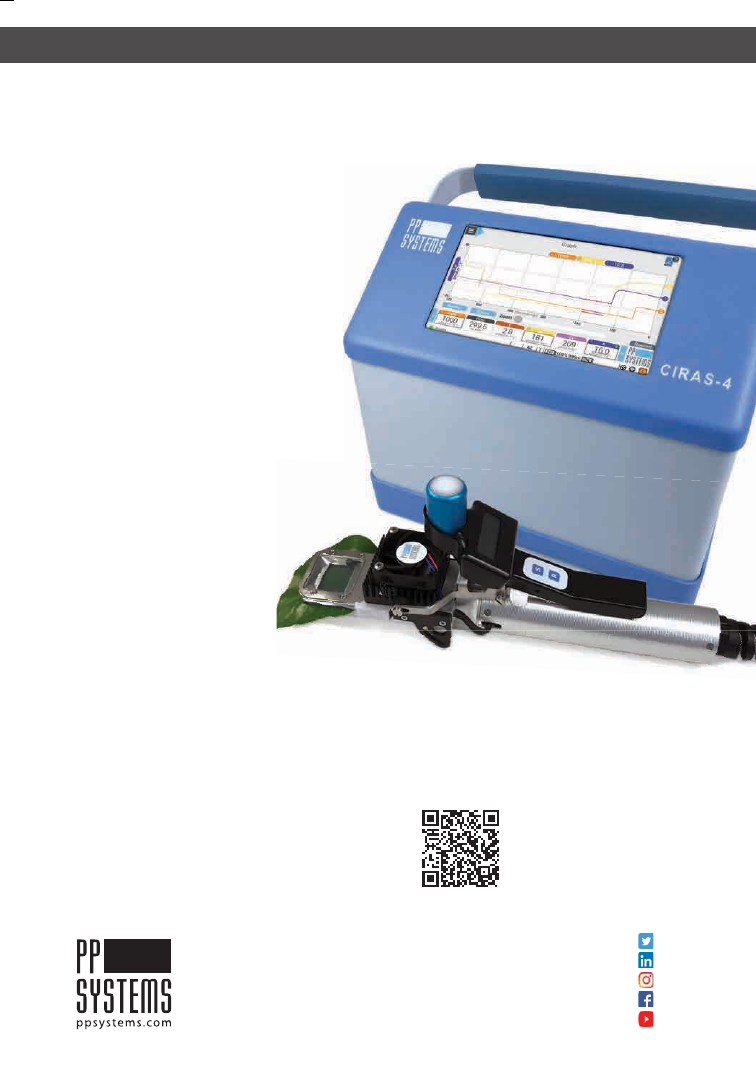
Unrivaled Performance,
Portability
& Power.
Don’t let its compact size fool you.
The highly accurate
CIRAS-4
Portable Photosynthesis System is a
lightning-fast portable powerhouse that
will elevate your research experience.
Its advanced software is exceptionally
intuitive and customizable. You can manage
environmental controls—as well as how
you view your data—all from the large,
full-color touchscreen.
It’s so easy to use, you can begin
taking measurements right
out of the box.
Just a few of the NEW CIRAS-4 features:
• Large, full-color touchscreen.
• Highly advanced user interface.
• Up to 16 hours of continuous operation.
• Fastest, simplest rapid A/C
i
curves available.
•
PLC4 Leaf Cuvettes include magnetic head
plates—no tools required!—and rulers on
apertures for accurate estimation of leaf area.
•
PLC4 LED Light Units (RGBW-FR) offer
4 far-red LEDs with light intensity up to
30% of PAR and auto control of light
intensity and ratio.
•
CFM4 Chlorophyll Fluorescence Module
offers OJIP fast induction kinetics, high frequency
measurements with optimized signal-to-noise
ratio, and auto control of light intensity, ratio of
red/green/blue/white LEDs, and far-red.
Redefining the high-level research experience worldwide.
110 Haverhill Road, Suite 301 | Amesbury, MA 01913 U.S.A. | +1 978-834-0505 | sales@ppsystems.com
pp_systems
pp-systems
ppsystemsinc
ppsystems.intl
ppsystemsinc
Introducing the CIRAS-4 Portable Photosynthesis System
Learn more about the fastest,
most accurate portable leaf gas
exchange system available.

42
SCIENCE EDUCATION
By Dr. Catrina Adams,
Education Director
Jennifer Hartley,
Education Programs
Supervisor
The Education team is pleased to announce
the formal publication of the results of our
Digging Deeper research partnership (Taylor
et al., 2022). Initiated in 2016, this large-scale
research study showed the effectiveness of
the PlantingScience Power of Sunlight theme
for increasing students’ content knowledge
around photosynthesis/cellular respiration
and in improving their attitudes about
scientists. For a summary of the research
and our findings, see our press release at:
https://www.eurekalert.org/news-releases/945679.
UPDATE ON
PLANTINGSCIENCE
Between mask mandates, vaccination
requirements, and students readjusting to a
school day routine after a year spent learning
from home, teachers have had a lot to juggle
this school year. Nonetheless, they returned to
PlantingScience Digging Deeper
Research Published
PlantingScience! During the Fall 2021 session,
we had groups from 24 schools, comprising
1018 students—the highest participation rate
we have experienced since 2018. The groups
used a wide variety of themes this session as
well; factors affecting seed germination (The
Wonder of Seeds) was the most popular, but
groups also studied Brassica and Arabidopsis
genetics, tree ecology, plant tissues, and
photosynthesis. Combined with our unusually
large Spring 2021 session, PlantingScience
has shown considerable growth over previous
years, even prior to the pandemic.
Our Spring 2022 session began on February
14. This session is somewhat smaller, but as
we look ahead to the upcoming F2 research
planned for 2023, we are working with our
platform developer to make important
programming updates and improvements. We
are excited about the days to come and proud
to facilitate the amazing partnership that
makes this incredible mentoring opportunity
available to teachers and students.
Please join us as a mentor! We are particularly
short on mentors who are comfortable
mentoring for our Pollen and Pollination,
Agronomy Feeds the World, and Power of
Sunlight (photosynthesis and respiration)
themes right now. Learn more about these
and other investigation themes here: https://
plantingscience.org/investigationthemes.
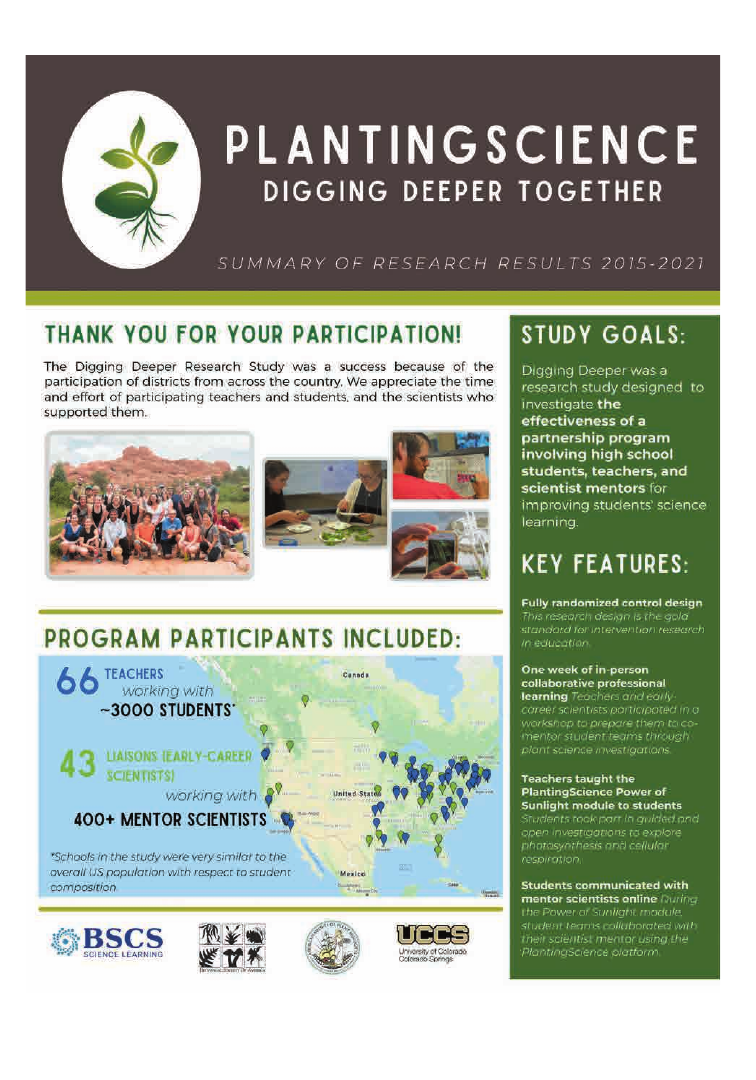

PSB 68 (1) 2022
44

PSB 68(1) 2022
45
LIFE DISCOVERY
CONFERENCE 2021
The question of whether conferences will
ever be the same after the pandemic has been
on the minds of every conference organizer
since the global shutdown in 2020. This was
no less true for the team organizing the 2021
Life Discovery Conference, which was held
in Estes Park, Colorado this past September.
Organized by the Ecological Society of
America in partnership with the BSA and
the Society for the Study of Evolution, the
Life Discovery Conference brings together
life science educators from high schools,
community colleges, and universities to
discuss best practices in biology education.
The 2021 conference’s theme was “Pushing
Past Barriers: Ecological Science for All,” and
it sought to focus on ways to underscore the
relevance of ecological and biological science
to all students, regardless of life situation,
cultural background, or career trajectory.
Sessions addressed technology tools to
facilitate communication and accessibility,
citizen science opportunities to engage
students in data collection and analysis, and
use of the “4DEE” (Four-Dimensional Ecology
Education) framework to guide pedagogical
approaches at all levels, including both majors
and non-majors in higher education settings.
The conference was held in-person as
scheduled! For many it was the first face-to-
face conference we had attended in nearly
two years. As you might expect, strict safety
protocols were implemented. Seventy-five
educators attended, representing a range
of university, community college, and high
school. Many thanks to all who attended, to
the organizing committee, to the YMCA of
the Rockies for hosting, and to the University
of Colorado for its sponsorship!
Organization of the 2023 Life Discovery
Conference is underway. If you are interested
in attending this exciting life science education-
focused conference, visit https://www.esa.org/
ldc/ for the most updated information.
UPDATED TEACHING
RESOURCES
Be sure to check out our recently updated
Teaching Resources page at https://botany.
org/home/resources/online_resources.html.
Originally created to provide support to
those teaching plant-related topics during
the pandemic, this page has been revised
and reorganized to provide an updated list of
available resources to teachers and instructors
at all levels. The list includes video collections,
interactive websites, blogs, articles, and more!
If you have favorite web resources that you
feel should be added to this page, contact
Jennifer Hartley at jhartley@botany.org. We
will continue to update this list regularly.
REFERENCES
Taylor, J., A. Westbrook, C. Adams, J.
Creasap-Gee, J. K. Spybrook, S. M. Kowalski,
A. L. Gardner, and M. Bloom 2022. The
effect of participation in a student-scientist
partnership-based online plant science
mentoring community on high school
students’ science achievement and attitudes
about scientists. Journal of Research in
Science Teaching. 59: 423–457. https://doi.
org/10.1002/tea.21733
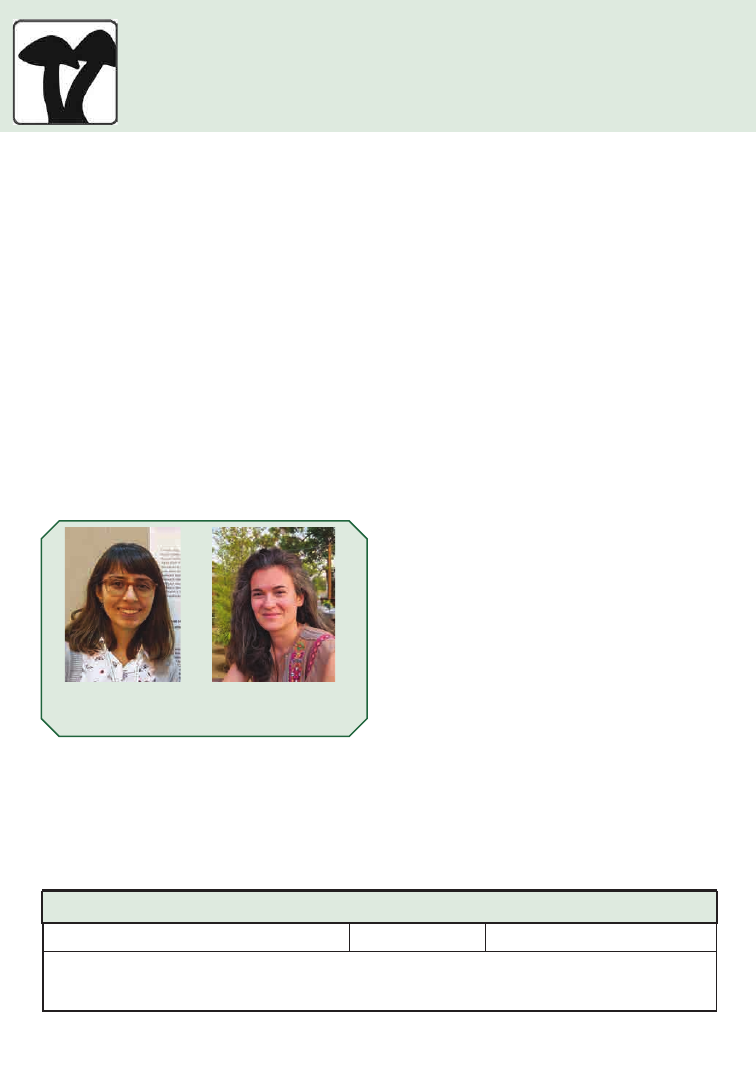
46
STUDENT SECTION
By Imeña Valdes and Ioana Anghel
BSA Student Representatives
It’s that time of the semester where you start to
compile every opportunity you want to apply
to into one list. To make this easier for you,
we have compiled a list of all the opportunities
we know about. Even if the deadline of this
application cycle is passed for this academic
year, make sure to check by the end of this
year for the next application cycle. Below, we
have divided these into categories for easy
browsing that include the following: BSA
Grants and Awards, Fellowship, Research
Awards, Broader Impacts, Short Courses and
Workshops, Job Hunting, and ways that may
help you to travel to Botany 2022.
Roundup of Student Opportunities
Of course, all the grants and awards
information will also be announced and
reminded via the BSA social media, so make
sure to follow us on Facebook (Botanical
Society of America), Twitter (@Botanical_),
and Instagram (@botanicalsocietyofamerica),
and stay updated! Also feel free to reach out
to your BSA student representatives, Imeña
(imenavaldes2020@u.northwestern.edu) and
Ioana (studentrep1@botany.org), if you have
questions about the listed opportunities, or
any questions or comments about BSA.
BSA GRANTS AND AWARDS
Here we listed a number of grants and awards offered by BSA this year, and make sure to pay
attention to the deadlines. All the BSA awards are open to its members and students of any
career stage and any nationality are encouraged to apply.
Donald R. Kaplan Award in Comparative Morphology
Amount: $10,000
Deadline: April 1
Purpose: Research Funds
More Info: https://botany.org/home/awards/awards-for-students/
kaplancomparativemorhpology.html

PSB 68(1) 2022
47
BSA Graduate Student Research Awards & the J. S. Karling Award
Amount: $1500
Deadline: April 1
Purpose: Research Funds
More Info: https://botany.org/home/awards/awards-for-students/
BSA Graduate Student Research Awards Given by Sections
Amount: $500
Deadline: April 1
Purpose: Research Funds
More Info: https://botany.org/home/awards/awards-for-students/
BSA Undergraduate Student Research Awards
Amount: $500
Deadline: April 1
Purpose: Research Funds
More Info: https://botany.org/home/awards/awards-for-students/
BSA Young Botanist Award
Amount: NA
Deadline: April 1
Purpose: Recognition
More Info: https://botany.org/home/awards/awards-for-students/bsayoungbotanistawards.html
American Association of University Women (AAUW) Dissertation Fellowship
Amount: $20,000
Deadline: November 1
Nationality/Affiliation requirement: Must be a female U.S. citizen, national, or permanent resident
Purpose: Dissertation Fellowships offset a scholar’s living expenses while she completes her
dissertation. The fellowship must be used for the final year of writing the dissertation. Applicants
must have completed all course work, passed all preliminary examinations, and received approval for
their research proposals or plans by the preceding November.
More info: https://www.aauw.org/what-we-do/educational-funding-and-awards/american-
fellowships
FELLOWSHIPS
Fellowships fund you during your graduate or postdoctoral work. Here we summarize some
of the available fellowships that could be applicable to your graduate or postdoctoral work.

PSB 68 (1) 2022
48
American Association of University Women (AAUW) International Fellowship
Amount: $18,000 – $30,000
Deadline: November 15
Nationality/Affiliation requirement: Have citizenship in a country other than the U.S. or possession of
a nonimmigrant visa if residing in the U.S.
Purpose: International Fellowships are awarded for full-time study or research in the United States to
women who are not U.S. citizens or permanent residents. Both graduate and postgraduate studies at
accredited U.S. institutions are supported.
More info:
www.aauw.org/what-we-do/educational-funding-and-awards/international-fellowships/if-
application/
Research Fellowships/Awards from the Arnold Arboretum
Amount: Up to $10,000
Deadline: February 1
Nationality/Affiliation requirement: Fellowships differ in requirements.
Purpose: Multiple awards and/or fellowships are offered for undergraduate and graduate students
with topics that focus on Asian tropical forest biology and comparative biology of woody plants.
More info: https://arboretum.harvard.edu/research/programs-and-opportunities/
Banting Postdoctoral Fellowships
Amount: $70,000 per year
Deadline: Unknown for 2022
Nationality/Affiliation requirement: Open to Canadian citizens and permanent residents of Canada.
Purpose: To promote research in Canada and Canadian scholars abroad.
More info: https://banting.fellowships-bourses.gc.ca/en/home-accueil.html
Burroughs Wellcome Fund: Career Awards at the Scientific Interface
Amount: $500,000 over five years
Deadline: January 7
Nationality/Affiliation requirement: Open to U.S. and Canadian citizens, permanent residents, and
temporary residents.
Purpose: To bridge advanced postdoctoral training and the first three years of faculty service. Research
bridging computational and biological approaches; PhD typically in chem, physics, math, etc.
More info: https://www.bwfund.org/grant-programs/interfaces-science/career-awards-scientific-
interface

PSB 68(1) 2022
49
Ford Foundation Fellowship Programs
Amount: $27,000 – $50,000 for 1–3 years
Deadline: 2023–2024 competition will open
December
Nationality/Affiliation requirement: All U.S. citizens, U.S. nationals, and U.S. permanent residents
(holders of a Permanent Resident Card), as well as individuals granted deferred action status under
the DACA Program.
Purpose: Three fellowship types are offered: Predoctoral, Dissertation, and Postdoctoral. The Ford
Foundation seeks to increase the diversity of the nation’s college and university faculties.
More info: https://sites.nationalacademies.org/PGA/FordFellowships/index.htm
Fulbright U.S. Student Program Study/Research Award
Amount: Variable
Deadline: 2023–2024 competition will open April
Nationality/Affiliation requirement: Must be citizens or nationals of the U.S. at the time of application;
permanent residents are not eligible.
Purpose: Covers transportation and living expenses in the host country. Tuition and school-related
fees covered in some countries.
More info: https://us.fulbrightonline.org/applicants/types-of-awards/study-research
National Science Foundation Graduate Research Fellowship Program (NSF GRFP)
Amount: $34,000 per year + tuition aid
Deadline: October
Nationality/Affiliation requirement: Must be a U.S. citizen, national, or permanent resident.
Purpose: Support outstanding graduate students in NSF-supported disciplines who are pursuing
research-based Master’s and doctoral degrees at accredited U.S. institutions.
More info: https://www.nsfgrfp.org/
National Science Foundation: Earth Sciences Postdoctoral Fellowships
Amount: $90,000 per year
Deadline: October 2
Nationality/Affiliation requirement: Must be a U.S. citizen, national, or permanent resident.
Purpose: Earth science research including geobiology and paleobiology; current theme: “issues relating
to scale.”
More info: https://www.nsf.gov/funding/pgm_summ.jsp?pims_id=503144&org=NSF

PSB 68 (1) 2022
50
Postdoctoral Research Fellowships in Biology (PRFB)
Amount: Varies
Deadline: Varies
Nationality/Affiliation requirement: All U.S. citizens, U.S. nationals, and U.S. permanent residents.
Purpose: The Directorate for Biological Sciences (BIO) awards Postdoctoral Research Fellowships in
Biology (PRFB) to recent recipients of the doctoral degree for research and training in selected areas
supported by BIO and with special goals for human resource development in biology. The fellowships
encourage independence at an early stage of the research career to permit Fellows to pursue their research
and training goals in the most appropriate research locations regardless of the availability of funding for
the Fellows at that site.
More info: https://www.jsps.go.jp/english/e-fellow/index.html
Schlumberger Foundation Faculty for the Future Fellowship
Amount: Up to $50,000 per year
Deadline: 2023–2024 competition will open in
November.
Nationality/Affiliation requirement: Applicant has to be a woman from developing/emerging
economies.
Purpose: The program’s long-term goal is to generate conditions that result in more women pursuing
scientific careers by lowering the barriers women face when entering STEM disciplines, thus reducing
the gender gap. Faculty for the Future Fellows are expected to return to their home countries after
completion of their studies to contribute to economic, social, and technological advancement by
strengthening the STEM teaching and research faculties of their home institutions.
More info: https://www.facultyforthefuture.net/content/about-faculty-future-program
Smithsonian Institution Fellowships
Amount: up to $40,000 for one year
Deadline: November
Nationality/Affiliation requirement: None
Purpose: To support research in residence at Smithsonian Institution facilities. All fields of study that are
actively pursued by the museums and research organizations of the Smithsonian Institution are eligible.
More info: https://fellowships.si.edu/fellowship-programs

PSB 68(1) 2022
51
Switzer Fellowship
Amount: $15,000
Deadline: January 2023
Nationality/Affiliation requirement: U.S. citizen, permanent resident, Deferred Action for Childhood
Arrivals (DACA) recipient, or a refugee or asylee according to the definition provided by the U.S.
Department of Homeland Security; and be enrolled in an accredited graduate institution only in
California or one of the six New England states (ME, NH, VT, MA, CT, RI).
Purpose: To support graduate students from diverse academic and personal backgrounds in New
England and California whose studies and career goals are directed toward environmental improvement.
More info: https://www.switzernetwork.org/become-fellow
American Society of Plant Taxonomists Graduate Student Grants
Amount: Up to $1,500
Deadline: February 28
Nationality/Affiliation requirement: Must be a member of the Society.
Purpose: To fund Master’s and doctoral students to conduct fieldwork, herbarium studies, and/or
laboratory research in any area of plant systematics.
More info: https://www.aspt.net/awards#.YfnrnvXML0p
Awards from New England Botanical Club
Amount: Up to $3,000
Deadline: February 5
Nationality/Affiliation requirement: None.
Purpose: To encourage botanical research in the New England region.
More info: https://www.rhodora.org/awards/graduate.html
RESEARCH AWARDS
In addition to those we listed, check out local Societies (e.g., Florida Native Plant Society,
Southern Appalachian Plant Society, Washington Native Plant Society Grant, Montana Native
Plant Society Grant, Nevada Native Plant Society Margaret Williams Research Grant, Colorado
Native Plant Society John W. Marr Research Grant, California Native Plant Society Educational
Grants and Chapter Scholarships, Arctic Institute of NA Grants-in-Aid Program). Other labs
have great databases too! Check out the Rothfels Lab database at https://rothfelslab.berkeley.
edu/resources/funding-sources/ (thanks, Thomas Murphy!) or the Northwestern University
Plant Biology and Conservation Program grant opportunities database (https://plantbiology.
northwestern.edu/graduate/resources/grants.html). Another great way to find more grant
sources is to check out the CVs of botanists you admire and look up the grants and fellowships
they have received.

PSB 68 (1) 2022
52
Company of Biologists: Travelling Fellowships
Amount: Up to £2,500
Deadline: February. May, August, October,
of each year
Nationality/Affiliation requirement: Award cannot be paid to those in areas that have sanctions,
embargoes, or other political trade restrictions put in place by the United Nations, the EU or the UK.
Purpose: Lab visits to work with collaborators; research themes must be covered by Company of
Biologists journals.
More info: https://www.biologists.com/travelling-fellowships/
Evolutionary, Ecological, or Conservation Genomics (EECG) Research Award
Amount: Up to $6,000
Deadline: 2023–2024 competition will open in
December
Nationality/Affiliation requirement: Must be a member of the society.
Purpose: Priority for funding will be given to proposals that address genome-scale questions, or
ecological, evolutionary, and conservation genetics questions that are best addressed using genomic
approaches in a hypothesis-testing framework.
More info: https://www.theaga.org/eecg-awards.php
Garden Club of America Scholarship
Amount: $1,000 – $8,000
Deadline: Varies
Nationality/Affiliation requirement: U.S. citizens and permanent residents who are enrolled in a U.S.-
based institution.
Purpose: To encourage research focused on systematics, also projects of a more general or educational
nature will be considered, provided that they include a strong systematics component. Offers a total of
28 merit-based scholarships and fellowships in 12 areas related to conservation, ecology, horticulture,
and pollinator research.
More info: www.gcamerica.org/scholarships
Grants from the Wetland Foundation
Amount: Up to $2,000
Deadline: December 18
Nationality/Affiliation requirement: Any student currently enrolled full-time at an academic institution
in the U.S.
Purpose: To support wetland education and research.
More info: http://thewetlandfoundation.org/grants/

PSB 68(1) 2022
53
Herb Society of America Research Grant
Amount: $10,000
Deadline: January 31
Nationality/Affiliation requirement: Only U.S. residents may apply.
Purpose: This grant is for the research of the horticultural, scientific, and/or social use of herbs
throughout history.
More info: https://www.herbsociety.org/get-involved/grants-scholarships/
International Association for Plant Taxonomy Research Grant
Amount: Up to $2,000
Deadline: February 28
Nationality/Affiliation requirement: None
Purpose: To fund students and young investigators preferably for travel to institutions, laboratory
investigations, or fieldwork.
More info: https://www.iaptglobal.org/grants
Lewis and Clark Fund for Exploration
Amount: Up to $5,000
Deadline: November
Nationality/Affiliation requirement: U.S. citizens and residents wishing to carry out research anywhere
in the world. Foreign applicants must either be based at a U.S. institution or plan to carry out their
work in the U. S.
Purpose: To fund field exploration in various fields.
More info: https://www.amphilsoc.org/grants/lewis-and-clark-fund-exploration-and-field-research
National Geographic Level I Grant
Amount: Up to $20,000
Deadline: April 13
Nationality/Affiliation requirement: None
Purpose: Support research, conservation, and exploration-related projects consistent with National
Geographic’s existing grant programs. In addition, this program provides increased funding
opportunities for fieldwork in 18 Northeast and Southeast Asian countries.
More info: https://www.nationalgeographic.org/grants/grant-opportunities/

PSB 68 (1) 2022
54
P.E.O. Scholar Award
Amount: $20,000
Deadline: Between August 20 and November 20
Nationality/Affiliation requirement: Must be a citizen or legal permanent resident of the U. S. or
Canada.
Purpose: To encourage research focused on systematics, also projects of a more general or educational
nature will be considered, provided that they include a strong systematics component.
More info: https://www.peointernational.org/psa-eligibility-requirements
Botany in Action Fellowship at Phipps Conservatory and Botanical Gardens
Amount: $5,000
Deadline: January 2023
Nationality/Affiliation requirement: Must be enrolled in a PhD program at a U.S. graduate institution
(U.S. citizenship is not required)
Purpose: To support emerging plant-focused scientists through research grants and science
communication training.
More info: https://www.phipps.conservatory.org/green-innovation/for-the-world/botany-in-action
Richard Evans Schultes Research Award
Amount: Up to $2,500
Deadline: March 30
Nationality/Affiliation requirement: Must be a member of the Society for Economic Botany
Purpose: To help defray the costs of field work on a topic related to economic botany for students who
are members of the Society for Economic Botany.
More info: https://www.econbot.org/index.php?module=content&type=user&func=view&pid=50

PSB 68(1) 2022
55
Sigma Xi Grants-in-Aid of Research
Amount: Up to $1,000
Deadline: March 15; October 1
Nationality/Affiliation requirement: Preference will be given to members of the Society.
Purpose: To encourage close working relationships between students and mentors, this program
promotes scientific excellence and achievement through hands-on learning.
More info: https://www.sigmaxi.org/programs/grants-in-aid
Society for Herbarium Curators Student Research Awards
Amount: $250 (undergrad) or $500 (grad)
Deadline: February 1
Nationality/Affiliation requirement: Must be a member of the Society.
Purpose: To provide funds for graduate or undergraduate students conducting research related to
herbarium resources.
More info: https://www.herbariumcurators.org/awards
Society for Integrative and Comparative Biology Grant-in-Aid of Research (GAIR)
Amount: Up to $1,000
Deadline: Fall 2022
Nationality/Affiliation requirement: Must be a member of the Society.
Purpose: For graduate students in support of their research in the fields of integrative and comparative
biology.
More info: https://sicb.org/grants-in-aid-of-research-program-giar/
Society for Integrative and Comparative Biology Fellowship of
Graduate Student Travel (FGST)
Amount: Up to $2,000
Deadline: Fall 2022
Nationality/Affiliation requirement: Must be a member of the Society.
Purpose: For graduate students for travel and other expenses at distant research laboratories, museums,
or field sites.
More info: https://sicb.org/fellowship-of-graduate-student-travel-fgst/

PSB 68 (1) 2022
56
Society for the Study of Evolution Grants
Amount: $2,500 – $3,500
Deadline: Varies
Nationality/Affiliation requirement: Must be a member of the Society.
Purpose: This Society has a range of grants that service students pursuing evolutionary research.
More info: https://www.evolutionsociety.org/index.php?module=content&type=user&func=view&pi
d=44#awards
Society of Systematic Biologist Graduate Student Research Award
Amount: Up to $3,000
Deadline: Fall 2022
Nationality/Affiliation requirement: Must be a member of the Society.
Purpose: To assist graduate students conducting research in systematics.
More info: https://www.systbio.org/graduate-student-research-awards.html
The Councils of the Linnaean Society and the Systematics Association:
Systematics Research Fund
Amount: £500 – £1,500
Deadline: Unknown for 2022
Nationality/Affiliation requirement: None
Purpose: To encourage research focused on systematics, also projects of a more general or educational
nature will be considered, provided that they include a strong systematics component.
More info: https://systass.org/grants-and-awards/srf/
Explorers Club Grants
Amount: Varies
Deadline: Varies
Nationality/Affiliation requirement: Varies based on grant.
Purpose: To encourage research focused on systematics, also projects of a more general or educational
nature will be considered, provided that they include a strong systematics component.
More info: https://www.explorers.org/grants/

PSB 68(1) 2022
57
The Mohamed Bin Zayed Species Conservation Fund
Amount: Up to $25,000
Deadline: February 28
Nationality/Affiliation requirement: Anyone directly involved in species conservation can apply to the
Fund for a grant.
Purpose: To support conservationists based in all parts of the world dealing with plant and animal
species.
More info: https://www.speciesconservation.org/grants/
Torrey Botanical Society Student Fellowship Award
Amount: Up to $2,500
Deadline: January 15
Nationality/Affiliation requirement: Must be a member of the Society.
Purpose: The Torrey Botanical Society supports student research in botanical research.
More info: https://www.torreybotanical.org/grants-awards/torrey-botanical-society-grad-student-
research-fellowship/
PlantingScience
What is it?
A learning community where scientists provide online mentorship to student
teams as they design and think through their own inquiry projects.
What you can do:
A learning community where scientists provide online mentorship to student
teams as they design and think through their own inquiry projects.
More info:
www.plantingscience.org/
Science Olympiad
What is it?
Competitions are like academic track meets, consisting of a series of 23 team
events in each division (middle school or high school). Each year, a portion
of the events are rotated to reflect the ever-changing nature of genetics, earth
science, chemistry, anatomy, physics, geology, mechanical engineering and
technology.
What you can do:
Mentor local students in person on a variety of science and engineering–
oriented topics and skills, help organize and run competitions
More info:
www.soinc.org/
BROADER IMPACT OPPORTUNITIES
Sharing your passion for plants and science with a wide range of audiences will help develop
speaking skills as well as help you reconnect with why you decided to go to grad school after all,
and they can add weight to your CV and resume as well. This is only a short list, but there are
many more opportunities you can look into (e.g., Girls Who Code, Girls Scouts, Boy Scouts).

PSB 68 (1) 2022
58
Local Arboretums, Parks, Museums, and Herbaria
What is it?
These institutions often depend on volunteers to donate their time and
expertise to help people of all ages enjoy their collections and grounds. They
may already have programs in place that allow you to lead tours or interact
with visitors at special events, so that you can share your interests and passion.
What you can do:
Lead tours, help organize and run events.
More info:
Look up local parks/arboretums/museums/herbaria online, or inquire at
visitors’ centers.
SHORT COURSES AND WORKSHOPS
These are a great way to learn new research skills, which can also be added to your CV or re-
sume. Due to COVID-19, many have been canceled but please double-check the websites for
info! We provide the names and website links for a few short courses and workshops that have
received very good feedback from their past participants.
• Summer Short Courses at the Arnold Arboretum (https://arboretum.harvard.edu/re-
search/programs-and-opportunities/)
• Tropical Plant Systematics (https://tropicalstudies.org/course/tropical-plant-systematic/)
• Organization for Tropical Studies (OTS) Courses (https://tropicalstudies.org/graduate-
programs/; https://tropicalstudies.org/undergraduate-programs/ )
• Frontiers and Techniques in Plant Science (https://meetings.cshl.edu/courses.
aspx?course=C-PLAN&year=20)
• Annual Workshops hosted by evomics.org (https://evomics.org/)
• Annual Workshop in Evolutionary Biology in Guarda (https://www.evolution.unibas.ch/
teaching/guarda/)
• The Bee Course (https://www.thebeecourse.org/)
• Tropical Field Biology (https://araceae.wixsite.com/tropical-botany?fbclid=IwAR0_)
• Jepson Herbarium at UC Berkeley Botanical Workshops (https://ucjeps.berkeley.edu/
workshops/)
• RADcamp Workshops (https://radcamp.github.io/)

PSB 68 (1) 2022
59
Internship Opportunities
Interning is important to gain experience, help you figure out what type of research or field you
want a career in and network with those who are in it. This also doesn’t always have to be done in a
volunteer format. There are many different paid internships to apply to for the summer, with many
of the deadlines in December or early next year. Many botanical gardens, arboretums, and museums
offer internship opportunities during the summer, or even throughout the year, so make sure to check
the job opportunities of their websites. Here we have a few examples of sites that you can search for
internships:
• Botanical Society of America: jobs.botany.org
• Research experiences for undergraduates (REU): https://www.nsf.gov/crssprgm/reu/reu_search.jsp
• Internships offered by The Future Park Leaders of Emerging Change: https://www.futurepar-
kleaders.org/
• Internships offered by the Organization for Tropical Studies (OTS) research stations in Costa
Rica: https://tropicalstudies.org/portfolio/internships/
• Internship opportunities at the Smithsonian: https://www.smithsonianofi.com/internship-
opportunities/
• Fall internship program offered by the National Tropical Botanical Garden: https://ntbg.org/
education/college
• Summer internship offered at the Chicago Botanic Garden (REU): https://pbcinternships.org/
• Internship offered at Montgomery Botanical Center: https://www.montgomerybotanical.org/
research/education/#interns
• Conservation and Land Management Internship Program: https://www.clminternship.org/
• Great Basin Institute AmeriCorps Internships: https://www.vscyberhosting.com/greatbasin/
Careers.aspx?type=HOTJOBS
WHAT’S NEXT: LOOKING FOR A JOB IN
PLANT SCIENCES?
Before you complete your degree, or if you are looking to switch jobs, it is important to consider
your next step—whether it’s finding a PI and lab to work in for continuing your education,
finding a postdoctoral research opportunity, or finding a job that suits your goals and skills.
Finding out about jobs often happens through personal contacts, but there are great online
resources as well.

PSB 68 (1) 2022
60
Graduate/Post-Graduate Opportunities
These types of jobs are easily searchable on the “EvolDir” website under “PostDocs” and
“GradStudentPositions”. Click the icon, and listings will pop up in a list from the newest to the
oldest. This site shows positions from across the biological sciences, but it is a great option for plant
evolutionary biologists. If you are interested in more of the ecology side of research, make sure to
check out “ecolog.” Contact people from the university/college that you’re interested in to ask for
more information.
• EvolDir: https://evol.mcmaster.ca/cgi-bin/my_wrap/brian/evoldir/Jobs/
• Ecolog: https://www.conservationjobboard.com/category/ecology-jobs
Academic Teaching Positions
Check the BSA website: click on the “Careers/Jobs” tab, and you can select the “Post-doctoral,
Fellowship, and Career Opportunities” link to see a current list of a variety of job postings. The BSA
website is a great resource for one-stop shopping for careers and other opportunities in a variety of
botanical sciences. Another good resource for finding jobs (including postdoctoral opportunities) can
be found through AAAS, at the Science Careers site.
• Botanical Society of America: https://jobs.botany.org/
• AAAS Science Careers: https://jobs.sciencecareers.org/jobs/botany-plant-science/
Government Positions and Non-Academic Jobs
Searches for government jobs can begin at usajobs.gov and americajobs.com. A good
resource for non-academic jobs is the Conservation Job Board; this site allows you to search
within various fields by state and is updated regularly. Networking sites like LinkedIn and
ResearchGate will help you connect with and organize your professional contacts; be sure to
keep your profile pages updated and polished!
• Government positions: www.usajobs.gov and www.americajobs.com
• Conservation Job Board: www.conservationjobboard.com/category/botany-jobs
Use your University!
Many academic institutions have offices that focus on helping alumni succeed after graduation.
Check with your department or institution for resources on job announcements, workshops
focused on personal development (such as CV/resume writing or getting a teaching certificate),
and networking opportunities. Since Botany 2019, we have started to offer CV/resume reviewing
booths for students to have their CV/resume viewed and commented on by professionals—
more information regarding the schedules for Botany 2022 will come out soon, so stay tuned!

PSB 68 (1) 2022
61
Use your University!
Check out your university’s and department’s funding for conference travel. Often universities have
small internal grants for students (both undergraduate and graduate) to present at a conference.
Due dates and amounts may vary by university. The Botany conference is always a great networking
opportunity, making it an easy conference to justify attending.
BSA Student Travel Awards Given by Sections
Amount: Variable
Deadline: April–May
Purpose: Travel to the conference
More info: https://botany.org/home/awards/travel-awards-for-students/
You can research your section leaders to ask about awards they are offering this year! BSA travel awards
include: Pteridological Section & American Fern Society Student Travel Awards, Vernon I. Cheadle
Student Travel Awards, Developmental & Structural Section Student Travel Awards, Ecological
Section Student Travel Awards, Economic Botany Section Student Travel Award, and the Genetics
Section Student Travel Awards, PUI Section Student Travel Awards, Bryological & Lichenological
Section Travel Awards, and Phytochemical Section Student Travel Awards. Due to COVID-19, some
of these awards have not been active. Double-check the website for updates!
BSA Student and PostDoc Travel Award
Amount: $500
Deadline: May 1
Purpose: Travel to the conference
More info:
https://botany.org/home/awards/travel-awards-for-students/grad_postdoc_travel.html
GRANTS WILL HELP YOU TO TRAVEL
TO BOTANY 2022
We would love to see you at Botany 2022! We outlined funding opportunities to help you
afford joining us in Alaska!
SOCIETY TRAVEL AWARDS
Both BSA and ASPT offer travel grants for Botany 2022. BSA travel grants are due May 1. ASPT
has a travel grant lottery that is normally announced in March.

PSB 68 (1) 2022
62
Botany 2022 Travel Grants for Presenters from Developing Nations
Amount: $1,000
Deadline: May 1
Purpose: Travel to the conference
More info:
https://botany.org/home/awards/awards-for-established-scientists/developing-nations-travel-grants.
html
PLANTS Grant
Amount: Variable
Deadline: May 1
Purpose: Cover costs of travel, registration, food, and accommodation at the conference.
More info:
https://botany.org/home/awards/travel-awards-for-students/plants-grants.html
If you have never been to Botany, check out the PLANTS grant through BSA. The goal of this program
is to enhance diversity at the Botany conferences. If you receive this grant, the cost of the conference
is fully covered, you get paired with a senior and peer mentor to help you navigate the conference,
and you’ll be able to participate in networking and professional development opportunities. Check
out more about the PLANTS program at the link above. BSA rep Imeña received this grant in 2015,
so feel free to contact her if you have any questions!
Bio REU Travel Grant (Rocky Mountain Biological Laboratory)
Amount: Up to $2,000
Deadline: At least 1 month prior to the
conference
Purpose: To present your REU research at a conference.
More info: Have you participated in an NSF-REU (National Science Foundation Research Experience
for Undergraduate) within the three years? If so, you can request up to $2,000 to present your REU
research at a conference through the Rocky Mountain Biological Laboratory Bio REU travel grant
(https://www.rmbl.org/students/reu-travel-grant/). You have to apply at least one month prior to the
conference, and the total cost of the conference will be fully reimbursed after the conference.
EXTERNAL AWARDS

PSB 68 (1) 2022
63
PP Systems Travel Grant
Amount: Up to $1,000
Deadline: Unknown for 2022
Purpose: To present research using the CIRAS-3 Portable Photosynthesis System at a conference.
More info: Does your research utilize the CIRAS-3 Portable Photosynthesis System from PP Systems?
And are you active on social media (“via your own lab blog, Twitter, etc.”)?
If so, you could apply for up to $1,000 to attend a conference or workshop through PP Systems
(https://tinyurl.com/bdevyh4t). BSA student member Rebekka Davis (University of Central Florida)
received this grant to attend Botany 2019. See her video here (https://www.youtube.com/watch?v=j2_
Uj3pcLyI&feature=youtu.be).
OTHER OPPORTUNITIES
Through BSA, there are many ways for students to have discounts on their registration. To have
your registration reimbursed, you can volunteer with BSA at the conference. Keep a look out for
emails from BSA soliciting volunteer sign-up; these emails will be sent closer to the conference dates.
If you are part of the PlantingScience team, you can get half-off registration for the Botany
conferences with a code that is distributed by the PlantingScience team. BSA Student Chapter
members will also receive a small discount on registration; just make sure to select that you are
a chapter member during registration.

PSB 68 (1) 2022
64
• Ålund, M., N. Emery, B. J. Jarrett, et al.
2020. Academic ecosystems must evolve
to support a sustainable postdoc work-
force. Nature Ecology & Evolution 13: 1–5.
• Asai, D. 2020. Race Matters. Cell 181:
754–757.
• Baker, K., M. P. Eichhorn, and M.
Griffiths. 2019. Decolonizing field ecol-
ogy. Biotropica 51: 288–292.
• Brown, N., and J. Leigh. 2020. Able-
ism in Academia: Theorising expe-
riences of disabilities and chronic
illnesses in higher education.
London: UCL Press. DOI: https://doi.
org/10.14324/111.9781787354975.
• Caviglia-Harris, J., K. E. Hodges, B.
Helmuth, et al. 2021. The six dimensions
of collective leadership that advance sus-
tainability objectives: rethinking what it
means to be an academic leader. Ecology
and Society 26: 9.
• Chaudhury, A. and S. Colla. 2021. Next
steps on dismantling discrimination:
Lessons from ecology and conservation
science. Conservation Letters 14: e12774.
• Chaudhary, V. B., and A. A. Berhe. 2020.
Ten simple rules for building an antiracist
lab. PLOS Computational Biology 16:
e1008210.
PAPERS TO READ FOR FUTURE LEADERS
As we continue in our careers, we hope to see the academic culture shift to be healthier and
more inclusive. Below are a few papers we think you should read if you hope to lead. We hope
to continue to recommend “Papers to Read for Future Leaders” to BSA Student members, if you
have papers you would like us to include, please share it with us via this google form: https://
tinyurl.com/y5dp8r4m! Previously shared papers include:
• Claire Demery, A. J., and M. A. Pipkin.
2021. Safe fieldwork strategies for at-
risk individuals, their supervisors and
institutions. Nature Ecology & Evolution
5: 5–9.
• Cooper, K. M., A. J. J. Auerbach,
J. D. Bader, et al. 2020. Fourteen
recommendations to create a more
inclusive environment for LGBTQ+
individuals in academic biology. CBE -
Life Science Education 19:es6: 1–18.
• Cronin, M. R., S. H. Alonzo, S. K.
Adamczak, et al. 2021. Anti-racist
interventions to transform ecology,
evolution and conservation biology
departments. Nature Ecology & Evolution.
5: 1213–1223.
• Dewa, C. S., K. Nieuwenhuijsen, K. J.
Holmes‐Sullivan, et al. 2020. Introduc-
ing plant biology graduate students to a
culture of mental well‐being. Plant Direct
4: e00211.
• Ellis, E. C., N. Gauthier, K. K. Goldewijk,
et al. 2021. People have shaped most of
terrestrial nature for at least 12,000 years.
PNAS 118: e2023483118.
• Emery, N. C., E. K. Bledsoe, A. O. Hasley,
et al. 2020. Cultivating inclusive instruc-
tional and research environments in
ecology and evolutionary science. Ecology
and Evolution11: 1480–1491.

PSB 68 (1) 2022
65
• Gewin, V. 2021. How to include Indig-
enous researchers and their knowledge.
Nature 589: 315–317.
• Hamilton, P. R., J. A. Hulme, and E. D.
Harrison. 2020. Experiences of higher
education for students with chronic ill-
nesses. Disability & Society DOI:10.1080/
09687599.2021.1907549.
• Huyck, J. J., K. L. Anbuhl, B. N. Buran, et
al. 2021. Supporting Equity and Inclusion
of Deaf and Hard-of-Hearing Individuals
in Professional Organizations. Frontiers in
Education DOI: https://doi.org/10.3389/
feduc.2021.755457.
• MacKenzie, C.M., S. Kuebbing, R. S.
Barak, et al. 2019. We do not want to
“cure plant blindness” we want to grow
plant love. Plants, People, Planet 1: 139–
141.
• Maestre, F. T. 2019. Ten simple rules
towards healthier research labs. PLOS
Computational Biology 15: e1006914.
• McDaniel, S. F. 2021. Bryophytes are not
early diverging land plants. New Phytolo-
gist 230: 1300–1304.
• McGill, B. M., M. J. Foster, A. N. Pruitt, et
al. 2021. You are welcome here: A practi-
cal guide to diversity, equity, and inclu-
sion for undergraduates embarking on an
ecological research experience. Ecology
and Evolution 11: 3636-3645.
• Nocco, M. A., B. M. McGill, C. M. MacK-
enzie, et al. 2021. Mentorship, equity,
and research productivity: lessons from
a pandemic. Biological Conservation 255:
108966.
• Parsley, K. M. 2020. Plant awareness dis-
parity: A case for renaming plant blind-
ness. Plants, People, Planet 2: 598–601.
• Poodry, C. A. and D. Asai. 2018. Ques-
tioning Assumptions. CBE - Life Sciences
Education 17: es7, 1-4.
• Schell, C. J., C. Guy, D. S. Shelton, et al.
2020. Recreating Wakanda by promoting
Black excellence in ecology and evolution.
Nature Ecology & Evolution 4: 1285–1287.
• Simoneschi, D. 2021. We need to improve
the welfare of life science trainees. PNAS
118: e2024143118.
• Tseng, M., R. W. El-Sabaawi, M. B. Kan-
tar, et al. Strategies and support for Black,
Indigenous, and people of colour in
ecology and evolutionary biology. Nature
Ecology & Evolution 4: 1288–1290.
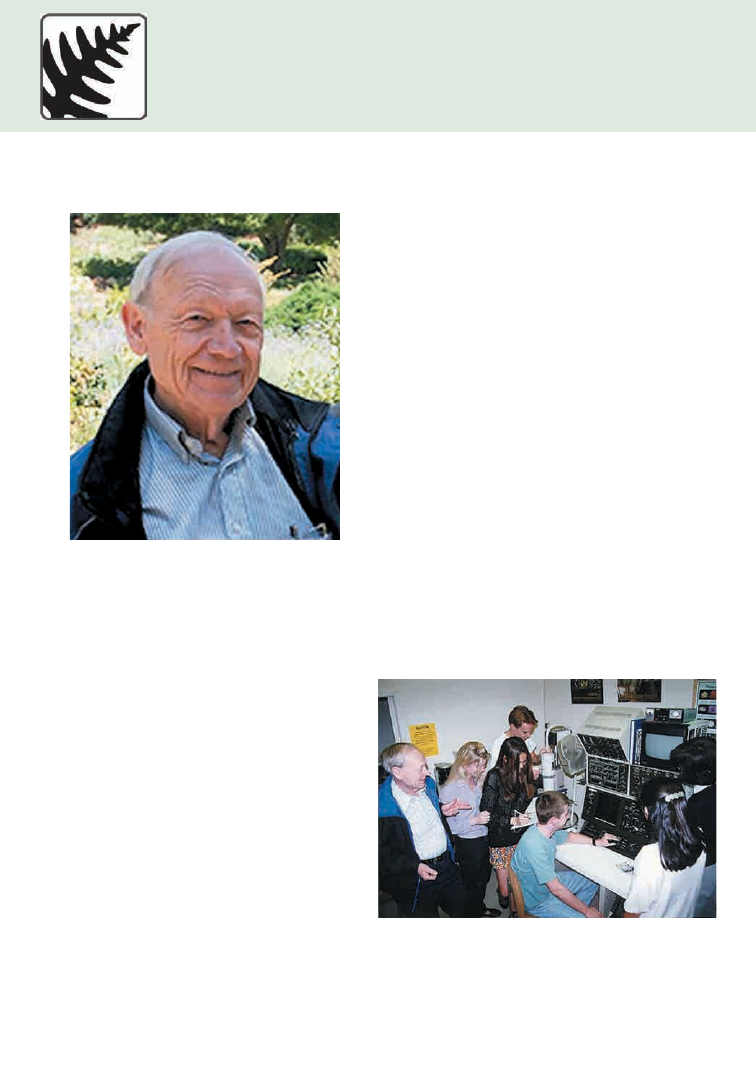
66
IN MEMORIAM
SHERWIN CARLQUIST
(1930–2021)
Dr. Sherwin Carlquist, known internationally
for his lifetime of scholarly works in botanical
science and photographic art, and by several
generations of colleagues, students, and friends,
died December 1, 2021 at the age of 91 at his
home in Santa Barbara. A long-term member
of BSA (65 years), plant anatomist at the
Rancho Santa Ana Botanic Garden, professor
at Pomona College and Claremont Graduate
School, research botanist at the Santa Barbara
Botanic Garden, and avid field researcher,
he spent half a century traveling the world
on National Science Foundation, National
Geographic, and other grants and the force
of his curiosity to author numerous seminal
books on island biology, plant anatomy, and
wood anatomy, as well as roughly 340 papers
in peer-reviewed journals. More remarkable
ANNOUNCEMENTS
than the quantity are his conceptual advances,
with many ideas in wood anatomy and island
biology explored for the first time.
Included among his pioneering advances are:
the founding of “ecological” wood anatomy,
the study of wood as reflecting function in the
context of climate and habit; ideas regarding
how small variations in developmental
programs can lead to functional diversity
(tracheid and fiber dimorphism, the functional
interrelationship between axial parenchyma
and imperforate tracheary elements);
recognition of the functional importance of
diversity in imperforate tracheary elements
(tracheids, fiber-tracheids, libriform fibers,
and vasicentric and vascular tracheids); the
hypothesis that wider conduits are more
vulnerable to drought-induced embolism
than narrow ones; the hypothesis that the
closest continental relatives of the Hawaiian
silversword radiation are the tarweeds of
California; pit membrane remnants in
Sherwin mentoring high-school students in the
scanning electron microscope laboratory at the
Santa Barbara Botanic Garden. Each student
published a peer-reviewed scientific paper.

PSB 68 (1) 2022
67
perforation plates of ferns and primitive
dicotyledons; bordered pits in ray cells and
axial parenchyma; successive cambia; monocot
and gymnosperm xylem; evolution of vessels
in Gnetales; and the functional significance of
scalariform plates. More information about
his research, publications, and field work is
available at his website www.sherwincarlquist.com.
A Californian genus of Asteraceae, Carlquistia,
is named for him, along with a species in
the genus Stylidium, a hybrid Huperzia
(Lycopodiaceae), and a fossil species of
Nuphar. A genus of fossil wood, believed to be
the oldest in South America, Carlquistioxylon,
also commemorates him.
Sherwin viewed his legacy as inspiring
people to build on his work and go beyond it,
following their own inspiration and insights.
He taught so many to risk being an outsider,
to think critically, access courage, and find
enormity in the everyday. He believed it was
essential to choose things to care for, and know
why they’re worth it. His lifelong body of work
will continue to speak for itself in both science
and art, which is how he would have wanted it.
-By Dana Campagna, Mark Olson, and Ed
Schneider
IN MEMORIAM
JACK LEE CARTER
A TEACHING BOTANIST
(1929–2020)
Long before the terrorist attacks of 9/11, one
could walk onto the campus of the National
Institutes of Health (NIH), in Bethesda,
Maryland, from almost anywhere. There was
no fence and no requirement to pass through
security. So it was that I (J.D.M.) walked onto
the campus with Jack Lee Carter on a spring
morning in 1977—my first visit to NIH and
my first meeting with the kind and gentle
man who would become a long-time friend
and colleague. We were on campus to attend a
planning meeting for a new project on genetics
education, being directed by the Biological
Sciences Curriculum Study (BSCS). Jack,
ever the botanist and teacher, wanted to show
me the campus flora, and so we arrived early

PSB 68(1) 2022
68
and wandered around admiring the many
beautiful native plants and the flower gardens,
tended by a clearly devoted grounds crew.
Jack, of course, knew what we were looking
at. I did not, but I enjoyed the walk and the
lesson, as Jack identified virtually every plant
we encountered.
Our self-guided tour of the NIH campus was
far from the only time Jack and I wandered
around together. Some months later I joined
the BSCS staff—in Boulder, Colorado—
where I was expected to put my new degree
in genetic counseling to work in the service
of the organization’s burgeoning initiatives in
human genetics education. Jack, by then on
the biology faculty at Colorado College (CC),
in Colorado Springs, was a regular visitor to
BSCS, having been on the staff there for a
couple of years in the mid-1960s. BSCS is one
of those places whose mission ensures that you
never really get away, even if you leave, and Jack
continued to work on BSCS projects for many
years. He knew the staff and administration
very well and was well acquainted with the
history and operation of the organization,
including its approach to biology education,
which still, after 63 years, emphasizes inquiry-
based instruction. Jack’s regular visits to BSCS
gave us a chance to spend more time together,
on the job and off.
At the time we met, Jack was serving as the
president of the National Association of
Biology Teachers (NABT) and had served for
four years as editor of the association’s journal,
The American Biology Teacher. In 1984, he
received NABT’s Honorary Membership, the
association’s highest honor.
Jack’s professional preparation prepared him
well for leadership in the science-education
community. The first in his family to attend
college, Jack began his undergraduate work at
Baker University in Baldwin, Kansas, in 1946–
1947 and continued at Kansas State Teacher’s
College (now Emporia State University) in
Emporia, Kansas, where he received his B.S.
Jack was drafted into the U.S. Army in 1950
and served two years in Virginia during the
Korean War, teaching the basics of chemical
warfare to officers. He was realistic about
his good fortune in escaping combat, telling
friends and family that his college degree kept
him from “getting his butt shot off in Korea.”
In 1951, Jack married his long-time Kansas
sweetheart, Martha Shelton. After completing
his M.S. at Emporia, he went on to earn a Ph.D.
in botany at the University of Iowa in 1960, and
began his teaching career at Simpson College
in Indianola, Iowa. It was here that Jack began
bending the minds of his students toward
botany and plants. Tom Croat, the prolific
plant collector from the Missouri Botanical
Garden, was one of the first undergraduates
to come under Jack’s spell. After several years
at Simpson, Jack, Martha, and their young
children returned to Emporia, where he
taught at Emporia State until 1965. Jack then
moved to BSCS for two years before taking a
faculty position at CC, where he remained for
22 years, teaching botany and directing the
herbarium, which now bears his name.
Jack was as committed to teaching as he
was to botany. His classes at CC embraced
the inquiry-driven strategies promoted by
BSCS, and he collaborated with faculty in the
education department to develop and improve
instructional strategies in biology. CC’s well-
known block plan, where students take one
course at a time, allowed for extended field
trips where students could observe and collect
native plants from Colorado, New Mexico,
and Arizona.

PSB 68 (1) 2022
69
In 1982, BSCS relocated from Boulder to
the CC campus, with two transplanted staff
(including me) and Jack as half-time director.
For a variety of fiscal and political reasons,
this transition was a bit dicey, and there
was some question about the organization’s
survival. Jack’s ability as an administrator
and his visibility in the science-education
community, combined with the generosity of
the CC administration and faculty, helped to
guide BSCS through this difficult period. It is
not an overstatement to say that BSCS might
not have survived this rocky stretch were it
not for Jack’s leadership, connections, and
political savvy.
I served as BSCS’s associate director during
Jack’s three-year tenure at the helm, and we
spent hours together working on matters
of budget, organizational policy, personnel,
and educational philosophy. For BSCS, that
philosophy has always included a rigorous
defense of the teaching of evolution, and
Jack was an able advocate, continuing the
organization’s steadfast resistance to never-
ending creationist attacks on its educational
programs.
Our many hours together included extensive
travel on BSCS business—trips that allowed
us to develop a personal relationship built on
mutual interests and a compatible worldview.
Jack loved to discuss politics, and his
sympathies were decidedly liberal, likely owing
to his family origins. He was born in Kansas
City, Kansas, on 23 January 1929 into a family
with strong Democratic political affiliations.
His grandfather was a U.S. marshal, sheriff
of Wyandotte County, and a state senator.
His father worked for the Santa Fe Railroad,
and his mother was a homemaker. If Jack’s
political preferences ran to the left, they were
more than anything pragmatic, and he could
not abide positions or policies that were not
rooted in sound logic, irrespective of their
party of origin.
Jack’s advice and counsel remained immensely
important as I assumed the BSCS directorship
in 1985 and he returned to full-time status
at CC. His knowledge of national trends
in science education and his familiarity
with campus politics were central to BSCS’s
renewed growth in its new location. I think
Jack was happy to be relieved of the extra
administrative burden at BSCS and delighted
to be back with his students on collecting trips
to the Southwest.
Jack’s formal departure from BSCS did not,
however, mean the end of our wandering
around together. In addition to a shared
political outlook, Jack and I shared a love of ice
hockey, baseball, and beer—indulgences that
we continued to pursue together for another
15 years, often with our spouses.
I left BSCS and Colorado in 1999 to return
to the East Coast and did not see Jack often
enough thereafter, though we did keep in
touch. I’m reminded of Jack each time a
new issue of the New York Review of Books
shows up in my mailbox. It was one of his
favorite periodicals, and he gave me my first
subscription in the early 1980s. I’ve never let
it lapse.
In addition to his active leadership in BSCS
and NABT, Jack maintained a long-time
membership in the Botanical Society of
America and was active in ensuring the
Society maintained a focus on plant education.
Jack represented the Society on the CUEBS
Biology Methods Advisory Group in the late
1960s (CUEBS gave rise to both AIBS and
BSCS). I (M.D.S.) first met Jack at the 1990
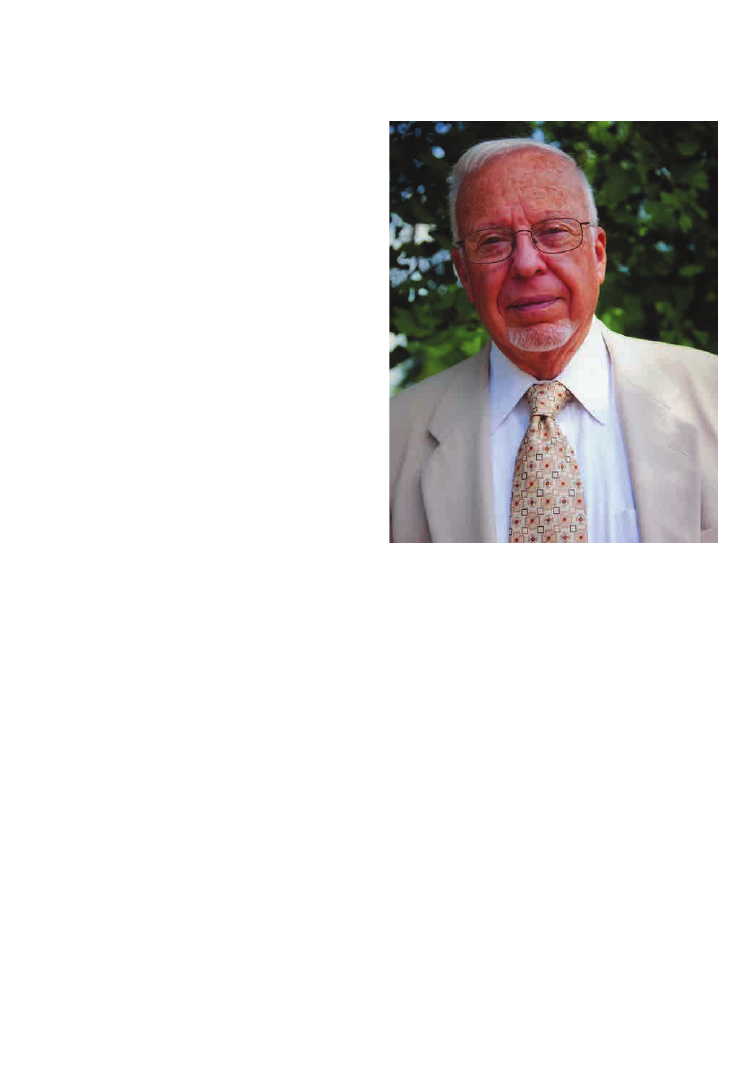
PSB 68(1) 2022
70
annual meeting where he was a panelist on
a symposium recounting CUEBS successes,
and failures. This led to his appointment
as a member of the section committee for
Education and Teaching that authored the
report for the BSA’s Botany for the Next
Millennium (1995). It was his good words
and encouragement that led me to accept a
position at Emporia State.
Throughout his retirement Jack maintained
his interest in botanical education through
leadership of both the New Mexico and
Colorado Native Plant Societies and publishing
statewide field guides: Trees and Shrubs of
Colorado; Trees and Shrubs of New Mexico;
Common Southwestern Native Plants: an
Identification Guide; and Gymnosperms of
New Mexico: a Field Guide.
Jack was always a gentleman whose kind
words and wisdom helped shape our world
and whose friendship will be sorely missed.
—Joseph D. McInerney, Marshall D. Sundberg,
and Gordon E. Uno
Joseph D. McInerney was on the staff of the Biological
Sciences Curriculum Study for 22 years and was
its director from 1985 to 1999. He was president
of the National Association of Biology Teachers in
1991. He retired as executive vice president of the
American Society of Human Genetics in 2017.
Marshall D. Sundberg, Roe R. Cross Professor of
Botany, Emporia State University. Distinguished
Fellow, BSA.
Gordon E. Uno, David Ross Boyd Professor of
Botany, University of Oklahoma. Past President,
BSA and NABT.
IN MEMORIAM
ALAN GRAHAM
(1934–2021)
Alan Graham, Emeritus Professor of Botany
and Geology at Kent State University and
Curator of Paleobotany at the Missouri
Botanical Garden, an incredibly productive
scholar, highly awarded teacher and researcher,
effective mentor, wide-ranging author, and
a gentleman in the finest sense of the word,
passed away at the age of 87 on July 8, 2021.
He is survived by Shirley Graham, his wife
and colleague of 61 years; his son Andrew and
daughter-in-law Julia; daughter Alison; son
Bruce; and granddaughter Kenzie Graham.
In 1520, grammarian Robert Whittington of
Oxford College described Sir Thomas More as
“a man for all seasons.” That phrase can have
multiple meanings in the case of someone like
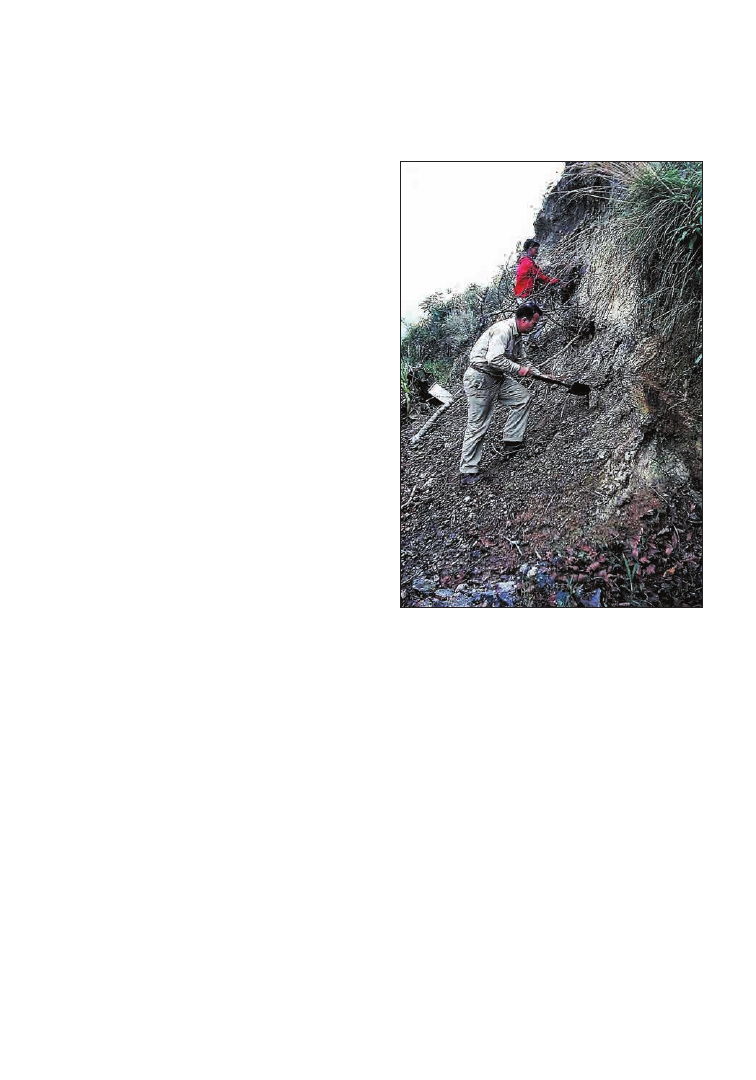
PSB 68 (1) 2022
71
More, but common usage today suggests a
person who, by preparation, personality, and
character, has the ability to address the wide
range of complex issues of a place and time.
This certainly applies to Alan, whose place
spanned the Americas, with a pioneering
focus on Latin America, over a span of time
from the Late Cretaceous through the entire
Cenozoic.
This wide-ranging personal journey began at
the University of Texas where Alan earned his
Bachelor’s degree with support from a full tennis
scholarship. From there he moved on to the
University of Michigan to study paleobotany
under the direction of Chester Arnold. His
PhD research involved a detailed study of fossil
material in the Michigan collections from
two Oregon Neogene sites: Succor Creek and
Trout Creek. The standard of the day would
have mandated a revision of the systematics
of the two megafossil floras, along with
observations of the implications with respect
to paleogeography and paleoecology. Alan
worked the megafossils of the two assemblages
but added a prescient twist: the study of fossil
pollen and spores derived from processing the
rock matrix bearing the fossil leaves and other
megafossil remains. Analysis of fossil pollen
had evolved into a standard approach in the
study of post-glacial sediments, particularly
in north-temperate sites, but its primary
application in older rocks was largely limited
to providing data on the age and environments
associated with petroleum exploration and
field development (stratigraphic palynology).
Trout Creek samples failed to yield useful
pollen and spores, but many of the Succor
Creek matrix samples were characterized by
a rich fossil pollen/spore record. This led to
the recognition of a number of new taxa in the
Succor Creek assemblage and a broadening
of the geographic and ecological implications
of the flora. This broadening of the scope of
data in research on ancient assemblages would
characterize virtually all of Alan’s later work.
Alan Graham and Enrique Martinez, Vera-
cruz, Mexico, 1967
It was during his time at Michigan that Alan
met, courted, and married another PhD
candidate in Botany, marking the start of a
61-year collaboration in life and science. With
their newly-minted PhDs in hand, Alan and
Shirley moved on to a one-year post-doc at
Harvard University prior to moving on to
permanent faculty positions at Kent State
University in Ohio. From the outset, Alan was
admired for the high quality of his teaching
and research, his mentoring of both graduate
and undergraduate students, and his ability
to secure NSF grant support. His teaching
reached far beyond the classroom and lecture
hall, where, spread over 12 summer field

PSB 68(1) 2022
72
sessions, he led “Biological Field Studies
in Mexico and the American West,” a life-
changing encounter with the biodiversity
and ecology of western North America. His
exemplary teaching skills were clearly evident
early in his career, when, in 1971, the Student
Advisory Council of the Kent State University
College of Arts and Sciences presented
him with an Outstanding Teacher Award.
In 1997 his university honored him with a
Distinguished Scholar Award in recognition
of his excellence and balance in teaching and
research.
In his poem, “The Road Not Taken,” Robert
Frost ends with a life-changing choice:
“Two roads diverged in a wood, and I ---
I took the road less traveled by,
and that has made all the difference.”
Alan Graham’s “road less traveled” was
stunning in its scope, encompassing nothing
less than the Cenozoic history of the
American Neotropics, a region characterized
by what is arguably the richest floristic
diversity and ecological complexity on the
planet. The consequences of the less-traveled
road would be over 200 published papers,
a pollen collection of over 35,000 reference
slides of extant taxa, and paleobotanical
and palynological collections sampling the
paleodiversity and ancient plant associations
across the New World tropics. Fundamental
studies in paleobotany, bolstered by new
insights on regional historical geology and
geochronology, the incorporation of new
insights into previously unknown climatic
drivers, sea level changes, and a developing
understanding of the role of land bridges—
which both promoted and filtered the
movement of plant taxa across vast areas of
ancient landscapes—expanded Alan’s vision
from a regional to a continental perspective.
His academic career ended with his retirement
early in the new millennium, but he was far
from finished with his life’s work. He and
Shirley moved on to curator positions at the
Missouri Botanical Garden in St. Louis for
what was to be a virtual second career lasting
19 years until his passing.
The fruits of his continental-scale synthesis
are to be found in several major awarded
books: A Natural History of the New World:
The Ecology and Evolution of Plants in the
Americas (University of Chicago Press,
2010); Late Cretaceous and Cenozoic History
of Latin American Vegetation and Terrestrial
Paleoenvironments (Missouri Botanical
Garden Press, 2010); and Land Bridges:
Ancient Environments, Plant Migrations
and New World Connections (University of
Chicago Press, 2017).
Given the quality, scope, and recognition of
his professional work, it was inevitable that
awards should follow:
2009
Distinguished Merit and Fellow Award
Botanical Society of America
Asa Gray Award
American Society of Plant Taxonomists
2011
Paleobotanical Section Award
Botanical Society of America
2014
A Festschift for Alan Graham
in His 80
th
Year
Missouri Botanical Garden
2018
Jose Cuatrecasas Medal for Excellence in
Tropical Botany
The Smithsonian Institution
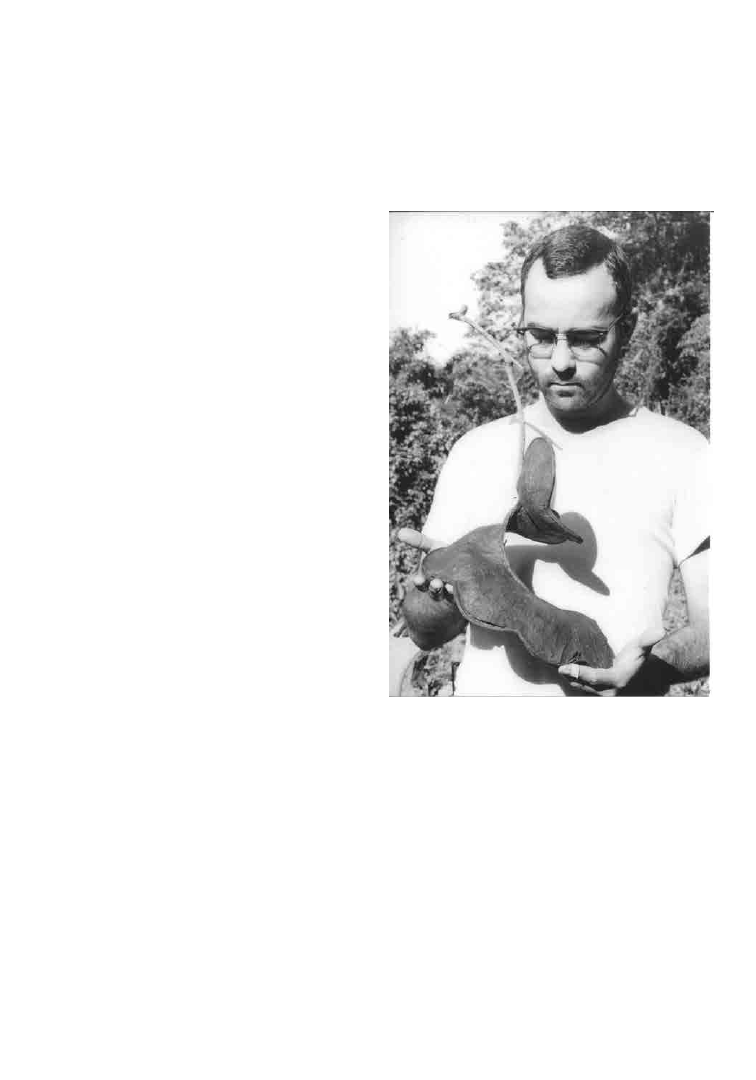
PSB 68 (1) 2022
73
Alan Graham was truly “A Man for All Seasons,”
an exemplar of a life well-lived, and he will be
missed. He leaves an indelible personal legacy,
as well as the specimens and writings that are
part of the fabric of his professional persona.
That said, his best and most significant legacy
can be found in his impact on his family,
generations of students who passed through
his classroom, the worldwide network of
professionals whose work he has influenced,
including his lasting impact in the American
Tropics—his collaborators, students, those he
has mentored and those he has inspired. Each
of these individuals, to varying degrees, will
continue to carry on and expand on the solid
base of exemplary scholarship he has helped
to create.
—Ralph E. Taggart, PhD, Emeritus Profes-
sor of Plant Biology and Geological Sciences,
Michigan State University
IN MEMORIAM
WILLIAM LOUIS STERN
(1926–2021)
Bill Stern with Entada fruit, Panama, 1957
Bill Stern, one of the world’s eminent wood
anatomists and orchid scientists, passed away
in Gainesville, Florida, at the age of 95 on
November 1, 2021. He was a member of the
“Greatest Generation”—those who grew up
during the Depression and served in World
War II. When the war ended, they were “mature
beyond their years, tempered by what they had
been through, disciplined by their military
training and sacrifices” (Brokaw, 1998). Bill
instilled the values he learned during wartime

PSB 68(1) 2022
74
in his students and collaborators alike—values
such as selflessness and honor. In his quest
for knowledge, there was never a margin for
error or reason for injustice of any kind. At the
same time, he had a profound sense of humor
that allowed him to make lifelong friends and
survive numerous physical ailments until the
end, including malaria and Covid-19 before
vaccines became available.
Bill was born on September 10, 1926, in
Paterson, NJ. In 1944, a few months after he
graduated from Paterson Central High School,
he enlisted in the U.S. Navy at the age of 17 and
served in Guam as a medical technician in the
tuberculosis ward and fashioned false teeth.
If he was allowed one indiscretion before his
honorable discharge in 1946, it was to save up
for the almost obligatory sailor’s tattoo. Upon
his return, he used the GI Bill to finance his
studies at the National Farm School (now
known as Delaware Valley University) in
Doylestown, PA, before enrolling in Rutgers
University and graduating summa cum laude
with a B.S. in botany and minor in zoology
in 1950. While studying in New Brunswick,
he met secretary Flory Tanis on a blind date;
their marriage in September 1949 would last
for almost 50 years until her death in February
1999. He then undertook graduate studies at
the University of Illinois, receiving his master’s
degree in botany (1951) after only one year
and his doctorate in botany with minors in
invertebrate zoology and paleobotany three
years later. His dissertation was devoted to
wood anatomy of Lauraceae. Bill customarily
wore a suit as a teaching assistant and still a
coat and tie on other school days. How times
have changed!
After beginning his first professional posts
as instructor and assistant professor in
wood anatomy as well as curator of the S. J.
Record Memorial Collection of Woods at Yale
University School of Forestry, he and Flory
started a family, first their daughter Susan
and then son Paul. While there, Bill taught
courses in plant and wood anatomy and edited
Tropical Woods for seven years (1953–1960).
Fieldwork for research took him to the Florida
Keys and Panama, supported by five different
NSF grants from 1955 through 1961.
Bill Stern, grad student, University of Illinois,
1952
In 1960 he accepted an offer from the
Department of Botany at the Smithsonian
Institution as Curator of the Division of Woods,
which became the Division of Plant Anatomy
in 1963. He later served as Acting Chairman
and then Chairman of the department
from 1964 through June 1967, overseeing a
faculty of 16. His research continued with

PSB 68 (1) 2022
75
more fieldwork in Panama, Hawaii, Oregon,
Jamaica, Dominica, and Luzon and Mindanao
in the Philippines (where the family lived for
a year); that led to the publication of several
papers such as one in Science on the fossil
forests of Ocú, Panama, with close friend and
colleague, Dick Eyde (Stern and Eyde, 1963).
In this era, he somehow managed to find
the time to serve as Editor of Plant Science
Bulletin (1962–1965) and Associate Editor of
BioScience (1963–1966) and Economic Botany
(1965–1975).
Bill left the Smithsonian in 1967 (but
remained Research Associate) to accept a
professorship at the University of Maryland,
where he worked until 1979. Freedom from
most administrative duties as department
chairman left more time for research, editing
professional journals, and more involvement
on the national scene. His anatomical work
focused on woody Saxifragaceae. Among
his more ambitious projects were Index
Xylariorum (institutional wood collections
of the world), a treatment of Saxifragales for
Encyclopedia Britannica, and the textbook
Humanistic Botany with Oswald Tippo, his
former advisor at the University of Illinois.
Tippo later became Professor and Chancellor
of the University of Massachusetts at Amherst
and served as editor of the American Journal
of Botany (1951–1953) and President of the
BSA (1955). Bill was a founder and editor of
Biotropica (1969–1972) and following that the
editor of Memoirs of the Torrey Botanical Club
(1972–1975). Toward the end of his tenure at
Maryland, he served as Program Director of
Systematic Biology at the National Science
Foundation in Washington, DC.
Beginning when he gave Flory a Cattleya plant
for Mother’s Day in 1973, he became intrigued
by orchids. Back then orchids were not the
disposable commodity that they are today, and
so Bill needed to research how to keep that
plant alive. What a mistake: one orchid became
two, two became three, and soon he and
son Paul were building a lean-to greenhouse
against their townhouse in Silver Spring, MD.
Systematic anatomy of Orchidaceae would
become his principal academic focus in the
last phase of his long career.
In 1979 the Department of Botany at the
University of Florida was seeking a Chair.
Bill applied, interviewed, accepted the offer,
and moved with Flory to Gainesville. He
remained Chair from September 1979 until
August 1985. Part of his goal was to attract
well-known orchid scientists and, with the
Florida Museum of Natural History across
the courtyard from his office in Bartram Hall,
the University of Florida became a center for
orchid studies in the United States. He was
instrumental in helping Norris Williams,
who specialized in orchid pollination and
systematics, secure a position in the Museum
and move to UF in 1981 with two of Norris’s
students from Florida State University:
Mark Whitten (1954–2019) and me. Mark
settled into the Museum and I into Bill’s lab
as postdoctoral research associates. Over the
years Bill collaborated on projects involving
developmental and systematic anatomy of
orchids; the culmination of the vegetative
work was volume 10 of the Anatomy of the
Monocotyledons series published by Oxford
University Press in 2014, 12 years after he was
named Emeritus Professor of Botany.
Bill and Walter Judd team-taught an ongoing
tropical botany course at Fairchild Tropical
Garden in Coral Gables, Florida, in its early
years. According to Judd (now Emeritus
Professor), the course opened his eyes to
tropical angiosperm diversity and made a
positive impact on the students involved:
“None of that could have happened without

PSB 68(1) 2022
76
Bill’s administrative work and encouragement.
Funding for summer field courses in biology
is difficult to acquire—and Bill’s support of the
course (as a departmental offering) was critical
in its long-term success.” One of their shared
doctoral students at UF was Barbara Carlsward,
now Professor of Biological Sciences at Eastern
Illinois University, who wrote that Bill “was a
friend and valuable colleague who inspired his
students to become more than they thought
possible. He encouraged and challenged me
both personally and academically like no one
else I’ve ever known.”
He maintained a strong service record with
the BSA throughout his career, including
election as President (1985–1986). He received
the BSA Certificate of Merit in 1987 and
another one in 1995 “honoring service and
outstanding scholarship for the advancement
of the botanical sciences.” He also served as
President of the American Society of Plant
Taxonomists in 1981 and on the Board
of Directors of the American Institute of
Biological Sciences (1987–1989). One of his
most valued honors was election as Fellow
of the Linnean Society of London. It was at
the Royal Botanic Gardens, Kew, that he met
classical scholar and author of Botanical Latin,
William T. Stearn (1911–2001); he chuckled
when signing his correspondence to Stearn as
“William Louis Stern, the later homonym.”
Bill’s selflessness and generosity persisted
throughout his long life and professional
career. When Jack Putz, newly hired as a plant
ecologist in the Department of Botany at UF in
December 1982, arrived in Gainesville for the
first time, Bill and Flory were out of town but
had left their car for him in the airport parking
lot with the keys to their house. A few years
earlier at the University of Maryland, Bill had
a student who was too nervous to stand up in
front of a class or take his oral PhD exam. Bill
found a therapist for this student—and paid
for it. If someone needed help, he was always
there to solve the problem. That was Bill Stern,
everyone’s dad and role model.
I thank Walter Judd, Jack Putz, Barbara
Carlsward, James Ackerman, and most of all
Susan Stern Fennell and Paul Stern for their
reminiscences in preparing this tribute.
REFERENCES
Brokaw, T. 1998. The greatest generation. Ran-
dom House, New York.
Stern, W. L. 2014. Anatomy of the monocoty-
ledons X. Orchidaceae (M. Gregory, and D. F.
Cutler, eds.). Oxford University Press.
Stern, W. L. and Eyde, R. H. 1963. Fossil for-
ests of Ocú, Panama. Science 140: 1214.
Tippo, O. and Stern, W. L. 1977. Humanistic
botany. W. W. Norton, New York.
—Alec Pridgeon, PhD, Past Sainsbury Orchid
Fellow, Royal Botanic Gardens, Kew

PSB 68 (1) 2022
77
IN MEMORIAM
RONALD L. STUCKEY
(1938–2022)
Ronald Stuckey in his office in July of 1987 in
the former Botany and Zoology building on The
Ohio State University campus. Photograph by
A. E. Spreitzer.
Ronald Lewis Stuckey was a good and kind
person—someone you could not dislike.
He loved plants, especially aquatics, and
he was intrigued by how natural geological
and landscape histories had shaped their
distributions. He loved the histories of
people, too, especially early botanists of the
Ohio territories and the often-neglected
contributions of women botanists. He was
mindful of impacts of people on distributions
of plants in Ohio and neighboring states, which
fueled his support for their conservation. He
might have been regarded as an eccentric,
as are all academics, which made him more
interesting to friends and colleagues—perhaps
even more loveable.
Ron was born in Bucyrus, Crawford County,
Ohio, on 9 January 1938 to Leora Irene
(Shuey) and Guy Ralph Stuckey. For the first
18 years of his life, Ron lived on a farm in
Lykens Township in Crawford County, where
he attended high school. Following high
school, Ron attended Heidelberg College in
Tiffin, Ohio, where he majored in biology and
worked as a biology assistant. He was a member
of the Biological Honorary Society (Tri-Beta),
serving as president for one year, and he also
earned membership in the Heidelberg Honor
Society. In his junior year (1959), he received
the Zartman Award for superior work in
biology, and in summer he attended the Franz
Theodore Stone Laboratory of The Ohio State
University on Gibraltar Island in Lake Erie,
where he took university courses in field
botany and aquatic mycology.
These academic successes motivated him to
pursue graduate studies in botany, and he
applied to and was accepted at the University
of Michigan (Ann Arbor). In 1962 he was
awarded an M.A. degree in Botany, on his way
to a Ph.D. During the summers of 1961 and
1962, he served as an assistant for the aquatic
plant course at the University of Michigan
Biology Station at Pellston in the northern
Lower Peninsula, coming under the influence
of Prof. Edward G. Voss, who became his
major professor. His dissertation topic was
the taxonomy and phytogeography of the
genus Rorippa (Brassicaceae: marsh cress).
He received a graduate dissertation fellowship
in his fifth year, which allowed full focus on
Rorippa, for which he was granted a Ph.D. in
May 1965 (published in 1972).
Ron applied for and was hired into a faculty
position at The Ohio State University in 1965
and began teaching classes in general botany,
local flora, and plant taxonomy. He was soon
promoted to Associate Professor (1970) and
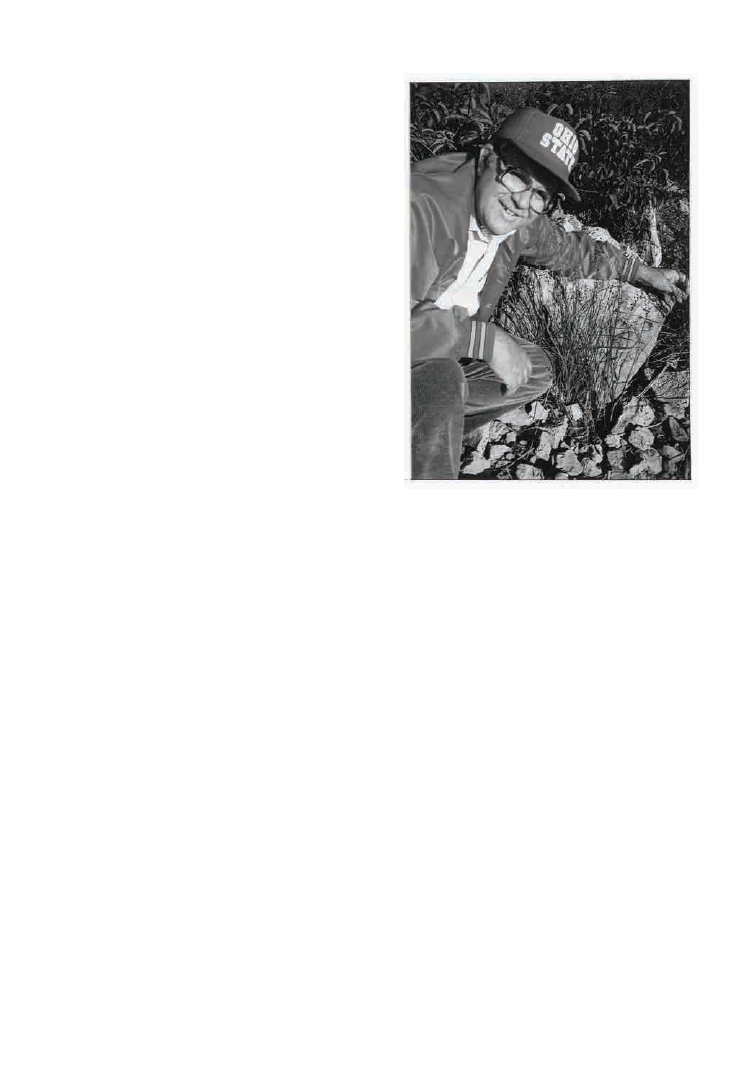
PSB 68(1) 2022
78
Professor (1978). In addition to his work in
Columbus, he served for five weeks in the
summer of 1973 as acting director of OSU’s
Franz Theodore Stone Laboratory in Lake Erie
and directed the teaching program there from
1978 until 1985.
When Prof. Clara G. Weishaupt retired as
curator of the OSU Herbarium, Ron was
appointed to that position and served in
this capacity from 1967 to 1976. This was an
important change, because Prof. Weishaupt
was trained as a plant physiologist and
not a systematic botanist. Based on his
experience at Michigan, Ron realized that
many improvements needed to be made to
the herbarium and plant systematics program
at Ohio State, and he worked hard to obtain
modern herbarium cabinets, hourly wages
for student mounters, and more space. He
also encouraged undergraduate and graduate
students to study topics in plant systematics.
Ron had many research interests: aquatics,
botanical history, conservation, floristics,
nomenclature, phytogeography, and
taxonomy. An important part of Ron’s
research, especially in the early years, was the
flora of the Erie Islands in northern Ohio. The
islands represented a good system to combine
floristics with history of the islands. A key
achievement was the publication with Thomas
Duncan (a former OSU undergraduate) of the
Flora of the Erie Islands, long delayed but finally
brought into print in 2010. On the wet sandy
beaches and abandoned limestone quarries
in western Lake Erie, Ron discovered a new
natural interspecific rush hybrid (between
Juncus alpinus and J. torreyi), named for him
as Juncus ×stuckeyi by his graduate student,
Mark Reinking (1981).
Ronald Stuckey at Marblehead Peninsula,
Ottawa County, Ohio, on 15 September 1988,
with the hybrid Juncus ×stuckeyi. Photograph
by Jane L. Forsyth.
Ron had an extremely retentive memory (a
valuable tool for efficient historical research),
and this is where he focused as his career
matured. Nearly 49% of his 115 publications
from 1962 to 1994 dealt with botanical history
(Burk, 1994). His principal focus was on the
early botany of the Ohio Territories, but he
also included analyses of historical herbaria in
the eastern states. He published several books
and monographs on historical topics: William
Starling Sullivant (Stuckey and Roberts,
1991); women botanists of Ohio (Stuckey,
1992); the collected papers of geologist Jane
L. Forsyth (Stuckey, 2003a); E. Lucy Braun
(Stuckey, 2001); and three books on Edwin
Lincoln Moseley, the educator-naturalist at
Bowling Green State University (Niederhofer
and Stuckey, 1998; Stuckey, 2003b, 2005).

PSB 68 (1) 2022
79
His other major publication category was
phytogeography (21.7%), with many articles
documenting the invasion of foreign aquatic
and wetland plants and their establishment
and migration throughout eastern North
America. He used historical information from
herbaria and older literature to explain the
present distribution of aquatic species, such
as in relation to the former Ohio canal system
(Roberts and Stuckey, 1992). Ron retired in
1991 and was named Professor Emeritus,
continuing to work actively while in good health.
Ron was a good teacher, who enjoyed using
a personal approach with his students. He
taught aquatic flowering plants on the main
campus in Columbus and Stone Laboratory
(1966–1991) to more than 500 students—
more students than at any other university
in the United States. He was very effective in
identifying highly qualified undergraduates
from his course in local flora, giving them
workspace in the Herbarium and encouraging
them to participate in collaborative research
projects. Some of these students continued
for M.S. degrees at Ohio State, and others
departed for advanced work at other
universities. He had two Ph.D. students
(Robert Haynes and Richard Lowden). At
the M.S. level he supervised 18 students on
topics such as Ohio floristics, vegetational
surveys, and phytogeography. In addition to
his appointment in the Department of Botany,
he had strong programmatic ties to the School
of Environment and Natural Resources, and a
number of his students obtained environmental
positions within the state.
Ron’s professional affiliations included
memberships in the American Society of
Plant Taxonomists; the Botanical Society
of America, where he served as historian-
archivist for nine years; the International
Society for Plant Taxonomy; the Native Plant
Society of Northeastern Ohio; the Ohioana
Library; and the Ohio Academy of Science,
where he served as historian-archivist and
President (1994). He gave a paper at the annual
meeting of the Ohio Academy every year from
1964 to 2001. He was also a member of the
Ohio Natural Areas and Preserves Association,
the Southern Appalachian Botanical Club, the
Columbus Natural History Society, and the
Ohio Academy of Medical History (of which
he served as president in 1981).
Because of Ron’s many professional
activities, he received several awards: the
Ohio Academy of Science Centennial Award
(1991); the Herbert Osborn Award from
the Ohio Biological Survey (2002); and the
Ohioana Book Award (2003) for his Lost
Stories, Yesterday and Today at Put-in-Bay
(Stuckey, 2003c). He was most proud of his
2010 induction into the Ohio Department
of Natural Resources Hall of Fame for
achievements in botanical conservation. In
response to his large donation of historical
botanical materials to Ohio State, the Ronald
L. Stuckey Herbarium Archives were dedicated
in June 2019 (Freudenstein and Stuessy, 2019).
As Ron aged, he suffered from bouts of
depression that interfered with his work, but
he always kept going, pushing to keep active
and make contributions. Apart from botany,
he continued to pursue his life-long interest
in bluegrass music to the extent that he could.
His long-term goal was to produce books
on botanical history of the Ohio Valley and
invasions of aquatic plants in the northeastern
U.S., each of which would have summarized
decades of research. Unfortunately, poor
health intervened, and these large projects were
not completed. Nonetheless, he continued
botanical research and publication up to 2006,

PSB 68(1) 2022
80
having produced more than 12 books and
over 200 research papers (including reviews
and necrologies). In later years physical
problems accumulated, which eventually led
to his passing on 11 January 2022 at age 84.
He was buried in Rock Creek Cemetery, Eden
Township, north of Melmore, Ohio.
REFERENCES
Burk, W. R. 1994. Ronald L. Stuckey: His
scientific publications (1962-1994) arranged
chronologically. Booklet published by the au-
thor: Chapel Hill, North Carolina. 42 pp.
Freudenstein, J. V. and T. F. Stuessy. 2019.
Dedication of the Ronald L. Stuckey Her-
barium Archives at the Ohio State University
(OS). Taxon 68: 1147–1148.
Niederhofer, R. E., and R. L. Stuckey. 1998. Ed-
win Lincoln Moseley (1865-1948): Naturalist,
scientist, educator. RLS Creations: Columbus.
Reinking, M. 1981. Juncus ×stuckeyi (Junca-
ceae), a natural hybrid from northern Ohio.
Brittonia 33: 170–178.
Roberts, M. L., and R. L. Stuckey. 1992. Dis-
tribution patterns of selected aquatic and wet-
land vascular plants in relation to the canal
system. Bartonia 57: 50–74.
Stuckey, R. L. 1972. Taxonomy and distri-
bution of the genus Rorippa (Cruciferae) in
North America. Sida 4: 279–430.
Stuckey, R. L. 1992. Women botanists of Ohio
born before 1900. RLS Creations: Columbus.
Stuckey, R. L. 2001. E. Lucy Braun (1889-
1971): Ohio’s foremost woman botanist; her
studies of prairies and their phytogeographical
relationships. RLS Creations: Columbus.
Stuckey, R. L. (compiler). 2003a. Linking
Ohio geology and botany: Papers by Jane L.
Forsyth. RLS Creations: Columbus.
Stuckey, R. L. 2003b. Bibliography and
archival guide to the writings of Edwin Lincoln
Moseley. RLS Creations: Columbus.
Stuckey, R. L. 2003c. Lost stories: Yesterday
and today at Put-in-Bay. RLS Creations:
Columbus.
Stuckey, R. L. (compiler and editor). 2005.
Predicting droughts and floods: Edwin L.
Moseley’s essays on long-range weather
forecasts. RLS Creations: Columbus.
Stuckey, R. L., and T. Duncan. 2010. Flora of
the Erie Islands: Its origin, history and change.
Lulu Press: Raleigh, North Carolina.
Stuckey, R. L., and M. L. Roberts. 1991.
Frontier botanist: William Starling Sullivant’s
flowering-plant botany of Ohio (1830-1850).
Sida Bot. Misc. No. 6: i-x, 1–5.
-John V. Freudenstein and Tod F. Stuessy,
Herbarium and Department of Evolution,
Ecology, and Organismal Biology, The Ohio
State University, 1315 Kinnear Road,
Columbus, Ohio 43212
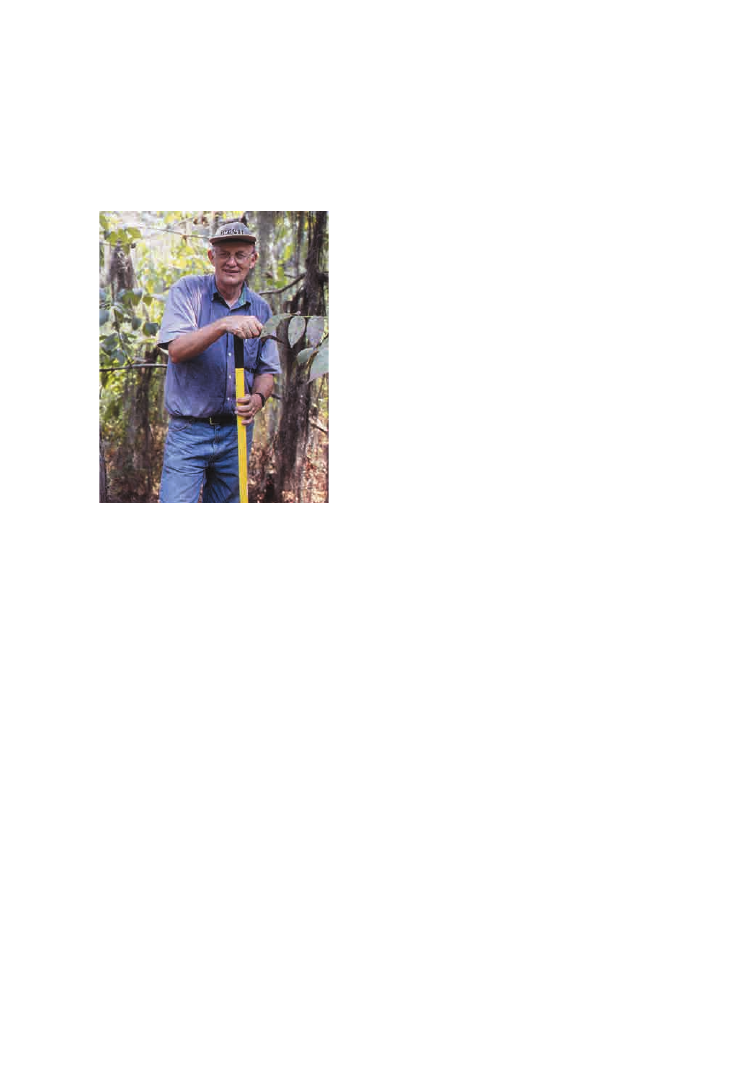
PSB 68 (1) 2022
81
IN MEMORIAM
LEONARD THIEN
(1938–2021)
Students of floral evolution, plant ecology,
karyology, and molecular systematics were
much saddened by the loss of Professor
Leonard B. Thien of Tulane University,
Louisiana, on October 24, 2021 after a long
illness. In 1991 Professor Thien became an
elected Fellow of the American Association for
the Advancement of Science for his studies in
cytology and the pollination biology of what
we now call basal or relictual angiosperms.
While Len Thien maintained a lab at Tulane
for almost 40 years his field studies took him
from the American Midwest to the Hudson
Bay region of Canada, Latin America,
Madagascar, Australasia (New Caledonia,
Australia and New Zealand) and China.
Len’s origins were distinctly Midwestern as he
was born in Breese, Illinois. He took his BS at
Southern Illinois University. His Masters was
completed at Washington University, St. Louis,
and this allowed him to meet the staff and use
the facilities at the Missouri Botanical Garden,
introducing him to the Neotropics. The
NSF awarded him a Research Assistantship
under then Curator Calaway Dodson (1928–
2020). Len assisted Dodson on a field trip to
Ecuador collecting orchids. It’s obvious that
Dodson appreciated Len’s work because he
named several new species after him, citing
the young botanist as a “co-discoverer.” This
included Stanophea ×thienii, now recognized
as a naturally recurring hybrid. Len remained
interested in orchids for the rest of his career,
contributing to taxonomic revisions while he
and his graduate students investigated novel
insect-orchid interactions.
From Washington University Len went on to
UCLA for his PhD, in the laboratory of Harlan
Lewis (1919–2008). He graduated in 1968 and
married his wife, Lorraine, in 1966. She was
also a student at the university and survives
him. He was hired quickly by the University of
Wisconsin in Madison as an Assistant Professor
of Botany. Len and Lorraine weren’t keen on
Madison. It was a place of student protests in
the 1960s, leading to the arrival of the National
Guard following the explosion of the Army
Mat Research Lab so close to Len’s office.
However, during this period he completed
his first piece of fieldwork, published in the
American Journal of Botany (Thien, 1969). It
remains a significant publication today (see
below). Len discovered that the blunt-leaved
orchid, Platanthera (Habenaria) obtusata was
pollinated by female mosquitos in the genus
Aedes. His field sites horrified Lorraine. Len
worked alone in those deep Wisconsin bogs.
You could vanish without a trace if you fell
through the sphagnum mats. Incomplete
records indicate that he joined the Botanical
Society of America by 1970. More than 80
publications would follow.
Happier and successful experiences awaited
Len when he joined the Biology Department
at Tulane University in 1971. He was promoted

PSB 68(1) 2022
82
to Associate in 1975 and Full Professor in
1981. The 1970s were very good to Len, as
it was the decade of the birth of his son Ben
and daughter Laura. His research developed
during this period and he began using species
of what we now think of as basal angiosperms
(eumagnoliids and ANITA Group) as model
systems to develop theories on the evolution
of the first flowers. The refugium flora of the
American south was generous and his first
paper on the pollination of American Magnolia
species also appeared in the American Journal
of Botany (Thien, 1974). Over the following
decades he and his students would go on
to examine the reproductive biology of the
native American species of Liriodendron,
Illicium, and Saururus. Of course, there
weren’t enough relictual taxa in North
America to keep him busy, which meant trips
to tropical islands of the southwestern Pacific
(Thien, 1980). His interest in the Winteraceae
took him to New Guinea, New Caledonia,
and finally to Madagascar. Len was adept
at building consortiums of scientists with
mutual interests who would work on different
aspects of a project to produce a more holistic
interpretation of the reproductive biology and
phylogeny of obscure lineages (see Thien et
al., 2003).
A most important feature of the Thien lab was
his positive and often rapid approach to the
incorporation of innovations and methods
unfamiliar to botanists. For example, to
collect mosquitos carrying orchid pollinaria,
he baited carbon dioxide traps with dry ice
first described a few years earlier by DeFoliart
and Morris (1967). As a Fellow of the Hormel
Institute, a research center more devoted to
biomedicine and meat chemistry, Len first
worked on analyses of floral fragrances in the
mid-’70s (Thien et al., 1975). He also kept up
with biochemical analyses and fluorescence
techniques to produce increasingly detailed
and sophisticated interpretations of floral
evolution. When the Biology Department split
in two, the new Cell and Molecular Department
became Len’s, apart from the Ecology and
Evolution Department. He learned genetic
analyses to produce phylogenies attracting
new colleagues from Japan and China. His
research was supported by at least 11 state
and national agencies. As more people came
to Tulane to learn from him and write up
their results, husband and wife repeatedly
hosted and entertained graduate students and
welcomed visiting scientists.
David White, his first graduate student, has
great memories of being in the field with Len.
Conversations were never dull. Len absolutely
hated snakes, so common in Louisiana, but
could never kill one unlike so many folks in
the state. He was too gentle of a man. Many
times, he even walked into the webs of the
huge golden orb spider as it tends to spin
Photos Property of Dr. David White (note the pollinators, a fly and beetles)

PSB 68 (1) 2022
83
at eye level. For Len, his swamps and study
sites were places for “critter respect.” The
pollinators of I. floridanum are small and not
willing to have their photos taken. Focusing
on the spectacular red flower meant meeting a
copperhead snake flicking its tongue as the lens
came into focus. It became a special bonding
moment between Len and David remembered
long after publication (Thien et al., 1983).
With the subdivision in departments, Len’s
lectures broadened. His courses in ecology
gave way to molecular biology with a lab.
However, Len’s passion was to teach nature’s
wonders out-of-doors. Jean Lafitte National
Historical Park was only a 30-minute drive
from campus and a favorite for class trips. Boat
trips, though, could be a challenge. On about
the first scouting trip for David’s research in
another part of the state, during high tide in
an old university boat driven by David, a sharp
turn in the bayou was missed and the vessel
ended up aground 30 m into the wire grass
marsh. They were marooned for more than
half an hour, close to dark in an age without
cell phones. Finally, a second boat came along
and there was no need to wave considering
the extent of their predicament. “Boy, do we
feel stupid,” Len said. “No worries,” said the
rescuer in his broad Cajun accent, “It happens
all the time.” Len said he loved that story as,
50 years later, David has never had a similar
accident nor seen such a one after thousands
of boat miles.
Len always gave one of his collaborators
the impression he was looking forward to
retirement. During one night in a hotel in the
New Caledonian countryside (he and I were
investigating the floral biology of Amborella
tirchopoda; Thien et al., 2003) he said abruptly,
“Do you know what to retire means, Peter?
It’s a military term and means to retreat
from the field.” A few years later, though, he
showed his deep loyalty to Tulane after the
university reopened following Hurricane
Katrina. The highways into New Orleans were
still strewn with debris. He would call me and
often sounded angry describing how often he
had to change his tires to and from Tulane.
However, his usually unflappable manner
not only explains how he progressed so well
under bad conditions but helps us understand
why his projects were successful even when
he worked in culturally distinct, and often
politically unstable, parts of the world. This
must explain why, in his last years at Tulane,
Chinese colleagues found it so important
to work with him on the Schisandraceae,
allowing him to investigate that family in the
ANITA group although it’s poorly represented
in the American south.
Younger botanists may still wonder does
it really matter what I publish in the long-
term? It did in Len’s case. Let’s return to Thien
(1969). Over 50 years later, a team of scientists
published an extraordinary paper in the
Proceedings of the National Academy of Science
(Lahondere et al., 2020). Acknowledging the
work of Leonard Thien, they returned to that
little, green-flowered orchid and its mosquitos.
Platanthera obtusata emits a nonanal-rich
scent uncommon in other members of its
genus. The nonanal attribute that balances
levels of excitation and inhibition in one of the
insect’s antennal lobes, and the same segment
also warns the mosquito to avoid incoming
fumes of DEET.
Len’s legacy teaches us that making a
fresh discovery is laudable, but opening
an intellectual window to both current
colleagues and future scientists is better. This
should always remind us that science is a
torch race even when it takes a half a century
to pass. Leonard Thien leaves a far more
knowledgeable scientific world because of his
passion to learn, teach, and complete research;
a noble trifecta. We thank you for your gifts.
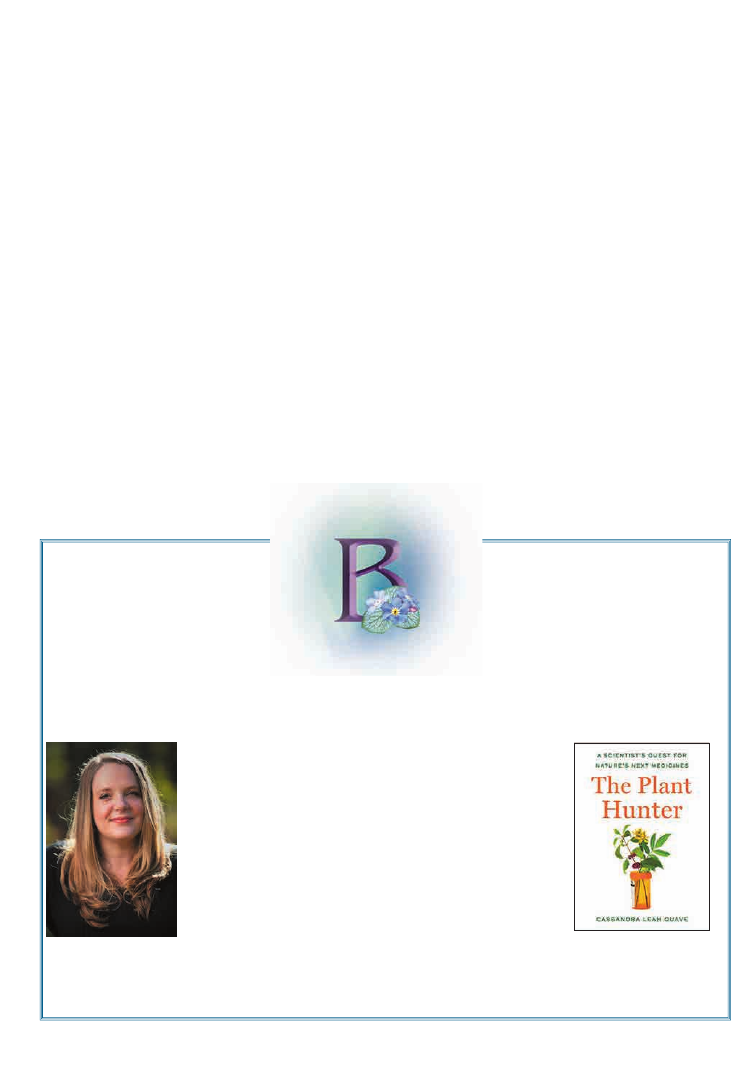
PSB 68(1) 2022
84
REFERENCES
DeFoliart, G. R. and C. D. Morris. 1967. A
dry ice-baited trap for the collection and field
storage of hematophagous Diptera. Journal of
Medical Entomology 4: 360–362.
Lahondere, C., C. Vinauger, R. P. Okubo, G.
H. Wolff, J. K. Chan, O. S. Akbari, and J. A.
Riffell. 2020. The olfactory basis of orchid pol-
lination by mosquitoes. PNAS 117: 708–716.
Thien, L. B. 1969. Mosquito pollination of
Habenaria obtusata (Orchidaceae). American
Journal of Botany 56: 232–237.
Thien, L. B. 1974. Floral biology of Magnolia.
American Journal of Botany 61: 1037–1045.
Thien, L. B. 1980. Patterns of pollination in the
primitive angiosperms. Biotropica 12: 1–14.
Thien, L. B., W. H. Heimermann, and R. Hol-
man. 1975. Floral odors and quantitative tax-
onomy of Magnolia and Liriodendron. Taxon
24: 557–568.
Thien, L. B., T. L. Sage, T. Jaffre, P. Bernhardt,
V. Pontieri, P. H. Wesston, D. Malloch, et al.
2003. The population structure and floral biol-
ogy of Amborella trichopoda (Amborellaceae).
Annals of the Missouri Botanical Garden 90:
466–490.
Thien, L. B., D. A. White, and L. Yatsu. 1983.
Reproductive biology of a relict: Illicium flori-
danum. American Journal of Botany 70: 719–727.
—Peter Bernhardt, Research Associate, The
Missouri Botanical Garden; and David White,
Professor Emeritus, Loyola University
ANNOUNCING!
BOTANY 2022 PLENARY SPEAKER!
DR. CASSANDRA QUAVE
THE PLANT HUNTER
GET A PREVIEW & READ A REVIEW
OF HER NEW BOOK ON PAGE 97
Plenary Lecture - Sunday, July 24 - 7:30 pm
Book signing to follow

85
By
Amelia Neely
BSA Membership &
Communications
Manager
E-mail: ANeely@
botany.org
MEMBERSHIP NEWS
The 2021 Gift Membership Drive (October
through December 2021) was a great success.
We had a goal of 175 gift memberships, and
the BSA community purchased 187—thank
you!
You can purchase gift memberships at any time,
including the new 3-year gift membership
for both students and developing nations’
colleagues.
Want to donate a gift membership to a student
or developing nations’ colleague instead?
Simply put your own name and email in the
recipient fields. Visit crm.botany.org to
get started.
2021 Gift Membership Drive
Results and Drawing Winner
Congratulations
Summer Blanco
2021 Gift Membership Drive
Winner of Free Registration
to Botany 2022!
Summer (she/they) received their bachelor’s
degree in Biology with a Botany option
from the California State Polytechnic
University, Pomona. Following her
undergraduate education, she took a position
as a post-baccalaureate research assistant
in the Biochemistry and Molecular Biology
department at Michigan State University.
Currently, they are pursuing their PhD in Plant
Biology at the University of Georgia studying
flower color polymorphism in Geranium.
Summer is excited to be coming to Anchorage in
July!

PSB 68(1) 2022
86
INTRODUCING
BOTANY360:
THE BSA COMMUNITY
EVENT CALENDAR
We are excited to announce the launch of
Botany360! Botany360 is a community event
calendar that highlights events happening
during the other 360 days outside of the Botany
Conferences. The program was a direct result
of the BSA strategic planning process, and the
goal is to keep the BSA community connected
and supported with a variety of workshops,
webinars, and gatherings that will include
professional development opportunities,
discussion sessions, and networking events.
To access the calendar, go to
https://botany.org/calendar/display.
If you are interested in adding an event to the
Botany360 calendar, email aneely@botany.org.
BSA AWARD
OPPORTUNITIES
BSA is proud to provide over $100,000 in award
support each year. The following BSA Awards
and Grants have a deadline in April–May 2022.
Visit the BSA Awards Homepage at
https://botany.org/home/awards.html
to see the complete awards schedule.
April 1, 2022 Deadline
• Distinguished Fellow of the Botanical
Society of America
• BSA Emerging Leader Award
• Jeanette Siron Pelton Award
• PLANTS Grants
• BSA Young Botanist Awards
• Charles Edwin Bessey Teaching Award
April 15, 2022 Deadline
• Professional Members Travel Awards
• BSA Student and PostDoc Travel Awards
• Developing Nations Travel Awards
• PUI Faculty and Future Faculty Confer-
ence Awards
• Sectional Travel Awards (see full list on
BSA awards page)
May 15, 2022 Deadline
• BSA Impact Award

PSB 68 (1) 2022
87
Do you want to know more about what the
BSA has to offer you as a member? Each
month a new BSA resource will be highlighted
in the BSA Membership Matters newsletter in
the “Did You know” section. Below are the
first two resources. Visit botany.org and
browse the website to find even more great
information.
Looking for a summer internship or a new
full-time position? Did you know that
BSA has a free jobs board at https://jobs.
botany.org/? Each month in the Membership
Matters Newsletter, we give you a sampling of
what is on the board in the highlights section,
but right now there are over 70 job positions
posted! New positions are being posted
regularly, so check back often!
Did you know that during the “Great Pivot
of 2020” BSA created a resource page at
https://botany.org/home/resources/online_
resources.html for teaching virtually? This
webpage was updated throughout the
pandemic with information as it became
available. The page has recently been
overhauled to reflect the current reality of
increased in-person learning/teaching and
highlights even more online resources for
classrooms as well as the previous virtual
teaching links.
Make sure to check out the Membership
Matters eNewsletter for more great
information, events, and news. Not receiving
the eNewsletter? Email aneely@botany.org.
DID YOU KNOW?

88
Double Helix of Phyllotaxis: Analysis of the Geometric Model of Plant Morphogenesis...........88
Driven by Nature: A Personal Journey from Shanghai to Botany and
Global Sustainability .............................................................................................................................................90
Flora of North America North of Mexico Vol. 10 Magnoliophyta:
Proteaceae to Elaeagnaceae...........................................................................................................................92
The Forgotten Botanist: Sara Plummer Lemmon’s Life of Science and Art ...............................93
Guide to the Vascular Flora of Buxton Woods, Dare County, North Carolina,
U.S.A. Sida, Botanical Miscellany 54 ..........................................................................................................95
Presenting Science Concisely................................................................................................................................96
The Plant Hunter: A Scientist’s Quest for Nature’s Next Medicines ................................................97
Spices, Scents and Silk: Catalysts of World Trade......................................................................................98
Stomata: How Plants Breathe: Topographic Perspectives in Selected Plant Families.......100
BOOK REVIEWS
Double Helix of Phyllotaxis:
Analysis of the Geometric
Model of Plant Morphogenesis
Boris Rozin
2020. ISBN: 978-1-62734-74808
$39.95 (paperback); 182 pp.
Brown Walker Press / Universal Pub-
lishers, Inc.
Plant phyllotaxis has been of interest to
botanists, mathematicians, gardeners,
horticulturalists, and anyone who has
marveled at the incredible symmetry and
patterns displayed in the growth patterns
of plants. How this remarkable symmetry
develops and is maintained has fascinated
biologists, mathematicians, physicists,
and other scientists for hundreds, if not
thousands, of years. Adler et al. (1997)
reviewed the history of the study of
phyllotaxis and divided it into three periods:
an Ancient Period (from antiquity to the
14th century), a Modern Period (from the
15th century to 1970), and a Contemporary
Period (from 1970 to today). Within these
periods, Adler et al. observed that, within
this history, there has been movement and
progress between experimental-observational
and theoretical-mathematical viewpoints of
research. This book by Rozin is a contribution
to the theoretical-mathematical analysis of
phyllotaxis in which he develops the Double-
Helix Model (DHM) of phyllotaxis.
Rozin opens with three short chapters
(Introduction, Mathematical Foundations,
and Phyllotaxis), which total 20 pages, to set
the stage for the development of his DHM that
he explores in Chapters 4–10, covering 100
pages. These are followed by three chapters
(11–13) and six supporting appendices.
Being a botanist, with my strengths in
taxonomy and morphology, I found the book
weak in the discussion of the botanical aspect
of phyllotaxis. Chapter 2 (9 pages) sets up the

PSB 68 (1) 2022
89
mathematical foundations with a discussion
of the golden ratio, recursive sequences
(highlighting the Fibonacci sequence), then
generalized recursive sequences, and spirals,
which is a lot of material, in a short space,
and important for the development of the
DHM to follow. Chapter 3 reviews botanical
phyllotaxis, concepts, and terminology, but
is quite short (8 pages) and relies heavily on
the work of Jean (1994). This chapter was too
short with the concepts so tersely explained
that I had to seek other papers for clarification
and understanding. It provided the minimal
foundation and did not discuss the wide
variety of research on phyllotaxis that has
occurred in the Contemporary Period. The
author is a mathematician and so the weak
botanical discussion is not surprising, but
improving and strengthening this chapter
would help the many potential readers not well
versed in either the biological or mathematical
aspects of phyllotaxis. I found myself needing
a copy of Jean (1994) and acquiring papers
cited by the author and many not cited as
I perused recent literature on phyllotaxis.
For example, Rozin very briefly mentions
that the various arrangements of leaves on
stems, from opposite to pinnate and other
periodical patterns, are based in some form
of fundamental phyllotaxis; unfortunately, he
does not discuss this any further.
Chapter 4 sets the mathematical background
for the DHM and is very short at 5 pages;
consequently it is dense, but understandable
and very interesting for mathematically
inclined readers. Chapter 5 presents the Planar
DHM on Archimedean Spirals and is very
detailed covering 41 pages and mathematically
dense, but with helpful diagrams and graphs.
Chapter 6 covers Fibonacci Lattices on Planar
non-Archimedean Spirals and so enlarges
the scope of Chapter 5. Chapter 7 covers the
Cylindrical D-H Model and so moves to the
application of the model to three dimensions,
with colorful drawings and diagrams.
Chapter 8, Phyllotactic Lattices with Rational
Divergence Coefficient, expands the three-
dimension aspect of the DHM. Chapter 9
then provides some discussion of the DHM
assessing some strengths, weaknesses, and
areas for further research. Chapters 8–10
provide observations about phyllotaxis, how it
should be measured, and concluding remarks
assessing the DHM.
A unique attribute of this book is the
availability of 119 videos depicting the
spirals, cylinders, and other structures and
how changes in the parameters of equations
or sets of equations change the structure and
phyllotactic pattern. The author put in a great
deal of work to develop these videos, and they
are a great aid in enhancing understanding.
I found the videos very enlightening, and
they add a tremendous amount to the
understanding of the equations. One video in
particular, titled “Unified Morphogenesis of
Spiral Phyllotaxis,” is remarkable in showing
the growth of parastichies from an isolated
shoot apical meristem and converting into
a two-dimensional sunflower capitulum,
then transitioning to a three-dimensional
cylindrical pineapple, and finally expanding
into a stem with leaves in spiral arrangement.
These videos can be accessed on the author’s
YouTube channel by searching for the book
title and author.
The author provides a wealth of support for his
DHM of phyllotaxis but does not discuss any
other competing models and how the DHM
may compare to them. In a recent review of
Rozin’s book by Gielis (2021), he points out
that Rozin has omitted accounting for the
fact that the Fibonacci sequence of numbers
is not rigidly adhered to in plants, and
discussion of this natural variation is needed.
The mathematics may be precise, but nature

PSB 68(1) 2022
90
is often not precise, as is frequently observed
by biologists.
This book is a strong contribution to the
theoretical-mathematical development of
phyllotaxis, but it exclusively focused on the
DHM. The book is tersely written, as often
found in mathematically based books, and
there are places where the flow of English is a
bit awkward, but there are not many. Overall,
the figures are very good, but in some cases
the captions could be improved for better
understanding. This is an excellent book for
anyone interested in this particular model
of phyllotaxis, but it is not a good overview
of the wide field of the study of phyllotaxis
or the various other models that have been
proposed. Even with the problems noted
above, it is a concise introduction to the
theoretical-mathematical study of phyllotaxis
and the DHM model and will provide the
adventuresome reader with insight into the
complexity of phyllotaxis and development.
By working through this book and videos, I
have gained a substantially greater knowledge
and understanding of phyllotaxis. For
mathematically inclined botanists and
biologists, it is very interesting and I found a
number of fascinating points to consider in
thinking about plant morphology and plant
development in general.
REFERENCES
Adler, I., D. Barabe, and R. V. Jean. 1997. A history of
the study of phyllotaxis. Annals of Botany 80: 231–244.
Gielis, J. 2021. Review of: Double helix of phyllotaxis:
Analysis of the geometric model of plant morphogen-
esis. The Quarterly Review of Biology 96: 139–140.
Jean, R. V. 1994. Phyllotaxis: a systemic study in plant
morphogenesis. Cambridge: Cambridge University
Press.
—Richard Lis, California Department of Fish
and Wildlife, Redding, California 96001
Driven by Nature: A
Personal Journey from
Shanghai to Botany and
Global Sustainability
Peter H. Raven
2021. ISBN-13: 978-1-935641-
19-3
Cloth, US$35.00. 359 pp.
Missouri Botanical
Garden Press
Probably every botanist in the world knows
something about Peter Raven: President
Emeritus of the Missouri Botanical Garden
(MoBot), member of the U.S. National
Academy of Science, Past-President of
the Botanical Society of America, author
of popular introductory biology and
introductory botany textbooks, and vocal
and influential environmentalist. This is all
true, and there are many more superlatives
that could be included. But after reading
Raven’s autobiography, I have a much greater
appreciation for the influences, both positive
and negative, that drove his remarkable
journey. In the preface he identifies three
themes that provided life-long orientation:
collecting, people, and self-motivation.
Kids collect things; Raven began with butterflies
at age 8, then moved on to beetles and the
Student Section of the California Academy
of Sciences (CAS). At 10, CAS’s botanist,
Alice Eastwood, drew his attention to plants,
and later her successor, John Thomas Howell,
cultured his interest in collecting plants (two
perfect examples of the effect of interested and
enthusiastic mentors profoundly impacting
the life of a young person). In 1950, at age 14,
“a man named Stebbins” offered to provide
Raven a ride to the Sierra Club Base Camp
where he had a summer job. Raven asked if
they could do some collecting along the way
and, after he explained to Mr. Stebbins the
process of collecting plants, he was assured

PSB 68 (1) 2022
91
that Stebbins understood what this entailed
and that it would not be a problem. They
spent several days collecting together in the
Sierras before Stebbins dropped Raven off for
his summer job. Collecting continued to be
an important component of his professional
training, postdoctoral work, his first academic
job at Stanford, and whenever possible during
his tenure at Missouri Botanical Garden
(MBG). His sabbatical year collecting in New
Zealand is the focus of a full chapter in the
middle of the book.
As illustrated by the above accounts, people
and networking were important to the young
Peter Raven and continue to be so. One of
the most interesting parts of the book for
me was simply to learn more about many of
the botanists I have known, or known of, as
Raven introduces them as part of his growing
botanical social network throughout the book.
And every time, from Edgar Anderson and
Dan Axelrod, through Paul and Anne Ehrlich
and Mildred Mathias, to E.O. Wilson and
Wu Zhengyi, he gives credit to each for their
accomplishments and their contributions to
his own. Snapshots of colleagues and mentors
are peppered throughout the book—a bit of
visual botanical history from the mid-20th
century to the present.
Raven has many accomplishments, so it is
not surprising that throughout his life he has
been a driven multi-botanical tasker. His
success is being able to focus on big ideas
while being inspirational, persistent, and
persuasive in convincing others to come along
and be part of the big ideas. Whether it be the
Flora of North America Project, building the
international reputation of the MBG, inspiring
the need for world resource conservation, or
championing science and science education,
Raven consistently surrounds himself with a
network of individuals that pick up the details
and fill in the missing links to make a project
successful.
The 14 chapters divide roughly into four
groups. Three chapters focus on his family
history and early life. Three more focus on his
preparation as an academic botanist, from an
undergraduate to his first faculty position at
Stanford. Four chapters describe his transition
from an academic to an administrator and
the transition of the MBG from a national
to an international presence. The final four
chapters champion the broader impacts of
conservation, education, and science at the
national and international levels. Raven is a
good storyteller and his is a good story. Young
and early-career botanists will be inspired by
Raven’s story, and many of us older ones will be
surprised at some of the things we learn from
reading it. All of us will enjoy the experience
of learning more about Peter Raven.
—Marshall D. Sundberg, Roe R. Cross Pro-
fessor of Biology, Emporia State University,
Emporia, Kansas

PSB 68(1) 2022
92
Flora of North America
North of Mexico Vol. 10
Magnoliophyta: Proteaceae
to Elaeagnaceae
Flora of North America Editorial
Committee
2021. ISBN-13: 9780197576076
Hardcover, US$95.00. 488 pp.
Oxford University Press
The latest volume in the Flora of North
America series treats 454 species in 66
genera of 12 families. The families covered
in this volume include the Proteaceae,
Buxaceae, Gunneraceae, Haloragaceae,
Combretaceae, Lythraceae, Onagraceae,
Myrtaceae, Melastomataceae, Surianaceae,
Polygalaceae, and Elaeagnaceae. The bulk of
the volume (at 270 pages) is taken up by the
Onagraceae. More than 25% of the species
are illustrated with line drawings of excellent
quality. I do wish the line drawings had
labels underneath each illustrated plant part.
For instance, the illustration for Terminalia
catappa (Combretaceae) shows two flowers
(one staminate, the other bisexual) that have
differing lengths. But you wouldn’t know
which is which unless you looked very closely
to see the style in the longer flower. I am not
familiar with that species (or family), so it
took me a bit to understand why there were
two flowers in the illustration.
This volume is the same as previously
published volumes regarding layout and book
quality. Each family has the typical technical
description followed by general information
and a key to genera (if applicable). Each species
description is accompanied by a distribution
map with dots in states or provinces where
the plant is found. Some species have longer
descriptions than others, as has been seen in
previous volumes, and some aren’t as fully
described as others (e.g., one species has seed
size given but another species in the same
genus will not). I have found this type of
omission to be an annoyance when trying to
develop keys to a smaller group of species in
a narrower geographic range. I always find it
enjoyable to read species entries and learn the
taxonomic history, uses, and other interesting
facts. Thankfully, many of the difficult genera
(e.g., Myriophyllum, Oenothera) have a lot
of this extra information for most species,
which is very helpful in understanding and
identifying them.
I tried a handful of the keys and they all
worked well. There were no glaring mistakes
or inconsistencies. My largest complaint
with this volume is the data quality for the
range maps. Ammannia robusta (Lythraceae)
and Oenothera curtiflora (Onagraceae) are
each known to grow in Wisconsin. The
former was first collected in 2000 and the
latter in 2006. However, Wisconsin does
not have a distribution dot on either of the
respective species maps. The data for these
specimens (with photos) have been available
on the WisFlora website (https://wisflora.
herbarium.wisc.edu/index.php; a portal for
the consortium of Wisconsin herbaria) since
at least 2006. Wisconsin has also been omitted
from the range maps of other species in
previous volumes of Flora of North America,
and not just waifs and sporadic weeds but
well-known native species, e.g., Cardamine
pratensis (Brassicaceae). I understand that a
work of this scope is difficult to make perfect,
but when such a large repository of data is
freely available, it seems odd that it would
not have been incorporated into the present
work. Especially when its data have also been
added to other databases such as USDA Plants
and The Biota of North America Program
(BONAP).

PSB 68 (1) 2022
93
The Forgotten Botanist:
Sara Plummer Lemmon’s
Life of Science and Art
Wynne Brown
2021
ISBN-13: 978-1-4962-2281-7
$27.95 (Paperback); 328 pp.
University of Nebraska Press
If I’m honest, I don’t often enjoy biographies.
I usually find them unnecessarily dense,
sluggish, and hard to get through. Despite
this, I chose to review Wynne Brown’s The
Forgotten Botanist, and in doing so, I feel like
I won the lottery. I lived in Tucson, Arizona,
for six years during my graduate work
studying botany, ecology, and evolutionary
biology in the shadow of Mt. Lemmon, and
doing much of my field work there at the top
of the mountain. As I read this book, I kept
exclaiming, “How did I NOT KNOW about
this fascinating woman?”
Sara Plummer Lemmon, the subject of this
engaging biography, was in fact the Lemmon
that Tucson’s highest mountain was named
after. Brown brings this 19th-century botanist
alive in her recounting of a fascinating woman
passionately dedicated to the study of plants.
Brown benefits from a rich and deep mine of
personal letters written by, to, and about Sara
Plummer Lemmon, and Sara’s lively voice
shines through in the excerpts dotting the
landscape of the book’s pages.
Sara Plummer (I’ll refer to her by her first name
from here on, as the author does) left the East
Coast in 1870 and traveled alone to California.
She was 33 years old at the time, and having
struggled with a number of serious illnesses,
she moved west in the hopes of recovering her
health. Rail travel was iffy, so she sailed south,
crossed the isthmus of Panama, and then back
north along the Pacific coast. Settling in Santa
Conversely, there are two species mapped
as occurring in Wisconsin that, to my
knowledge, do not grow here. Ludwigia
decurrens (Onagraceae) and Myriophyllum
aquaticum (Haloragaceae) are both mapped
for the state, but I can find no specimens to
corroborate this. I searched the Consortium of
Midwest Herbaria, Consortium of Northern
Great Plains Herbaria, and the Consortium
of Northeastern Herbaria but could find no
specimen records of either species. Strangely,
BONAP shows Ludwigia decurrens in
Walworth Co., Wisconsin but again, no
specimen (that I can find) verifies this and the
species is not even listed in Flora of the Chicago
Region (Wilhelm and Rericha, 2017), which
covers this area. The occurrence of Ludwigia
decurrens in Wisconsin seems unlikely given
its native range, but the possibility that
Myriophyllum aquaticum has been found here
is troubling. This species is prohibited by state
law from being sold in Wisconsin and there
is no record of it growing here. If a specimen
exists to prove that a wild population is (or was)
here, it would be nice to know where so it can
be found and eradicated (if established). Flora
of North America authors “are expected to
have seen at least one specimen documenting
each geographic unit record (except in rare
cases when undoubted literature reports may
be used)…” so this begs the question where
these species’ specimens were seen. Again, I
understand it is hard to keep any published
volume of this scope perfect, but range data at
this broad scale should be accurate.
Overall, this is another fine volume in this
monumental series.
—John G. Zaborsky, Botany Department,
University of Wisconsin – Madison, Madison,
Wisconsin, USA; jzaborsky@wisc.edu

PSB 68(1) 2022
94
Barbara, she quickly became integrated into
society there and soon established the town’s
first public library, and for a while, running
the library was Sara’s primary occupation.
However, she also became engaged in a
community of inquisitive women interested
in the natural world, and with them formed
the area’s first natural history association. In
the company of these women, she learned
how to identify and collect plants and create
herbarium specimens, and her life’s passion
was born.
Six years later, Sara meets the love of her life,
John Gill Lemmon, another avid botanist. They
married in 1880 and lived 28 years together,
by all accounts in very happy companionship
and collaboration. They wrote books together,
taught classes together, traveled and expired,
collected plants, and presented at two World’s
Fairs together. This biography celebrates their
relationship and how interwoven their work
was. They collected plants throughout the
southwest together, discovered new species
together, wrote several books together, taught
classes together, and from their letters, seemed
happiest when they were at each other’s side.
This book is peppered with interesting stories
of a fascinating life; in these pages, you’ll read
stories of harboring refugees after the San
Francisco earthquake, representing the botany
of the West at two World’s Fairs, lobbying for
the golden poppy to be named state flower of
California, ascending Mt. Shasta in hobnailed
shoes to study pines, making donuts on an
open fire and raising wild turkey chicks,
hiding for 8 days in darkness in a cave with a
crazy hermit miner, and so much more. You’ll
read about her connections with John Muir,
Clara Barton, and Asa Gray, among others,
and about her work in journalism, forest
conservation, and women’s suffrage.
Most importantly, Sara was a highly
accomplished and respected botanist in her
time, discovering (with J.G.) hundreds of
new species of plants, collecting thousands of
specimens documenting the floral diversity
of the western states, and sharing her love
of plants with others. She was also a talented
artist and created beautiful illustrations of
many of the plants they studied, and some of
these are included in the book. Sadly, most of
her artwork has been destroyed over the years,
and little of it remains today.
Brown’s book is full of engaging narrative,
great storytelling, and evocative character
development. Interspersed images of Sara’s
artwork and herbarium specimens, as well as
photos of her and her husband complement
the writing very effectively. Importantly,
Brown does point out and acknowledge the
ways in which Sara’s actions and words were
imbued with the racism and colonialism so
prevalent in white American culture of the
time. The structure of the work flows well and
only rarely did I find the reading becoming
dense or sluggish. The one thing I wished for
that the book lacked was an index. Many times
I find myself wanting to refer back to points or
topics in the text; an index would have made
this book a more useful historical account.
I highly recommend this book to anyone
wanting to understand the contribution
of women to the field of botany, but also to
anyone who wants to read a fascinating and
memorable tale of life as a botanist in the 19th
century. Sara will come alive for you on these
pages. Hopefully, her days of being a forgotten
botanist may finally be in the past.
—Amy Boyd, Warren Wilson College

PSB 68 (1) 2022
95
Guide to the Vascular Flora
of Buxton Woods, Dare
County, North Carolina,
U.S.A. Sida, Botanical Mis-
cellany 54.
Amanda L. Faucette, Alexander
Krings, and David L. Lindbo
2020;
ISSN: 0883-1475;
ISBN-13: 978-1-889878-60-7
$35.00 US, 236 pp.
Fort Worth: Botanical Research Institute of Texas Press
This is the fourth volume in the Illustrated
Floras of North Carolina Project and follows
the pattern of the other three issues. There are
discussions of edaphic and climatic features; a
treatment of plant communities with more than
270 color images, graphs, and charts. Among
the 476 species documented by collecting and
herbarium surveys, I was intrigued that the
eastern mistletoe, Phoradendron leucarpum,
is not included because it is frequent on trees
in wetland sites along the coast.
The remainder of the book consists of keys to
species and line drawings taken from Britton
and Brown 1913. (I continue to believe the
axiom that keys are made by people who don’t
need them for people who can’t use them; the
inclusion of good images is a propitiation for
this shortcoming.)
Especially helpful are images of Carex achenes
and perigynia. Likewise, images of grass
spikelets, and details of Asteraceae flowers
aid identification and pedagogical use of
these challenging taxa. In field botany or even
plant taxonomy classes, sedges and other
graminoids often receive scant attention. The
Guide to the Vascular Flora of Buxton Woods
is everything you would want in a local flora.
For me, it is a template for a planned future
regional flora (sans keys).
It could be argued that limited funds and
resources for botany could be more effectively
used. On the other hand, is there a better way
to raise local plant awareness than through
authoritative and accessible works like this?
Buxton Woods includes threatened plant
communities—a problem exacerbated with the
continuing development of the Outer Banks
as a tourist destination. Accordingly, this
book deserves the attention of conservation-
minded, natural history-oriented citizens,
wildlife enthusiasts, urban planners, and
educators of the region. It should be featured
in local bookstores as well as gift shops at the
many Outer Banks’ tourist attractions.
While the work deals with a very restricted
region, it will have application throughout
much of the mid-Atlantic coastal area. The
price is low for a publication of this quality,
making it an ideal textbook or supplement
resource for field botany courses.
The book is well edited and carefully
proofread, and color reproduction—while not
outstanding—is good. My copy of the book
has distracting unevenness of print with half
of some pages lighter than the other half.
The consortium producing these volumes,
Herbarium of North Carolina State University
and Botanical Research Institute of Texas,
deserve kudos for their latest edition. I look
forward to the next.
— Lytton John Musselman, Blackwater Eco-
logic Preserve, Old Dominion University,
Norfolk, Virginia 23529

PSB 68(1) 2022
96
Presenting Science
Concisely
Bruce Kirchoff, illustrations by
Jon Wagner
2021. ISBN-13: 9781789246995
Paperback $30.00; 126 pp.
CAB International, Wallingford,
UK
This book about communicating science is
particularly directed toward biologists, not
just botanists—but it is perhaps less useful
for other disciplines, such as the physical
sciences, where the culture may be somewhat
different. Kirchoff, a plant morphologist and
long-time active member of the Botanical
Society of America, has long had interests
in ancillary subjects, as demonstrated by his
book Emerson’s Science of the Spirit: A Visual
Interpretation of Emerson’s Natural History of
Intellect (Kirchoff, 2009) and his involvement
in educational and cognitive psychological
theory to help in the production of keys and
in the recognition of plants and their organs.
I have sat through more than one painfully
deficient scientific presentation with him and
am not surprised that he would undertake
this book and use his psychological interests
to strengthen it.
The two cornerstones of the book are (1) the
art of presenting science through storytelling
and transforming the story into a play of three
or more acts, and (2) a focus on knowing and
reaching the author’s audience. The book is
primarily about presenting science orally
and visually, although the principles are also
relevant to writing scientific articles, as in
organizing an introduction or discussion
and in producing a title. The book is
organized as concise chapters; Chapters 3–8
cover the different types of presentations,
from three-minute (or “lightning”) talks, to
elevator “pitches” of 15–90 seconds, to more
traditional talks of 12 minutes or more, and
finally to poster presentations. The principles
of narrative and audience are stressed in each
presentation type. Kirchoff brings the lessons
home by presenting examples from different
biological disciplines and giving examples
for the reader to examine and solve. Each
chapter cites the relevant literature, some
articles as recent as 2021. The chapters on
posters are particularly useful, because they
include a detailed discussion (and examples)
of titles and bring in cognitive psychological
principles, and EyeQuant technology to track
visual movement on the poster. These two
chapters by themselves are worth the price of
the book.
The illustrations, created in color for the
book by Jon Wagner, are at once whimsically
humorous and totally to the point of the
discussion in the text. I was especially taken
by the illustration of hundreds of poster
presentations ongoing in a vast convention
center hall, showing the personal enthusiasm
and conversations going on simultaneously.
I recommend this book to anyone who works
as a biological scientist and presents research
results to a variety of audiences (just about
every reader of the Plant Science Bulletin).
Presenting Science Concisely is published by
CABI (Centre for Agriculture and Bioscience
International), a global non-profit institute
focused on sharing information in agriculture
and the environment. The book is certainly
relevant to their mission. It is a slim volume,
perhaps a bit expensive for its size, but can also
be purchased at reduced cost as an e-volume,
PDF. or on Kindle.
REFERENCES
Kirchoff, B. K. 2009. Emerson’s Science of the
Spirit: A Visual Interpretation of Emerson’s Natu-
ral History of Intellect. Tellus Books.
— David Lee, Emeritus Professor, Florida
International University, Miami, FL.

PSB 68 (1) 2022
97
The Plant Hunter: A Sci-
entist’s Quest for Nature’s
Next Medicines
Cassandra Leah Quave
2021. ISBN-13: 9781984879110
Paperback, US$26.00; 384 pp.
Viking, New York City, New York,
USA
Did you know that salicin within willow tree
bark was used as a basis for the discovery
and development of aspirin? Well, maybe so.
However, you probably did not know that the
resin from Croton lechleri was used to create an
anti-diarrheal drug, or that miswak, a natural
toothbrush, comes from the Salvadora persica
plant, or that four billion people living in
developing countries rely on medicinal plants
as their primary form of medicine. In The
Plant Hunter, Dr. Cassandra Quave, a leading
medical ethnobotanist, regales readers with
stories of her life and adventures to remote
corners of the world to learn from traditional
healers about medicinal plants so scientists
can better understand the safety and efficacy
of the plants that billions of people rely on for
their medical care. This page-turning book is
organized into three parts, with four chapters
per part, as well as a detailed prologue,
epilogue, and appendices with additional
resources, scientific names, acronyms, and
citations.
The book starts with a prologue that provides
a brief history of antibiotics and ethnobotany.
Dr. Quave also takes the time to introduce
herself and explain that her drive to find
medicinal plants to treat bacterial infections
stems from her youth when she had to have
her leg amputated and she faced a subsequent
infection that led to a near-death experience.
The prologue transitions to Part One, titled
“Nature,” which focuses on the early part of
Dr. Quave’s life. Chapter 1 sheds light on her
parents, amputation, and love of the outdoors
and science, which led to her middle school
science fair experiments, volunteering at a
local hospital, and early college days at Emory
University. A college trip to Peru in Chapters 2
and 3 takes the reader on an adventure where
we meet the warm and caring Don Antonio,
who teaches a young Cassandra about
medicinal, cultural, and spiritual significance
of many plants in the Amazon. Over time,
young Cassandra learned about how, with the
influence of western medicine, there was a lot
of significant loss of Indigenous knowledge.
Yet, western medicines were too expensive,
so many people suffered and died from very
treatable illnesses. Seeing this illness and
death in person when shadowing Señor Vidal,
a local doctor, convinced Cassandra that she
wanted to be an ethnobotanist. Chapter 4
takes young Cassandra to Italy, where she
worked with Dr. Pieroni to study ethnic
Albanian folk-functional foods. While in
Italy, she learned how to cook, treat spiritual
ailments with elderberry and walnut, and
solidified her stance on the importance of
preserving traditional knowledge. She is also
introduced to Marco, who would become her
husband and companion.
Part Two, titled “Infection,” focuses on the
transition from young Cassandra to Dr.
Quave. Chapters 5 and 6 detail Cassandra’s
graduate school years at Florida International
University, education about botany, Latin,
and phytochemistry, her marriage to Marco,
the birth of her first child, her struggles being
a mother and scientist, and more adventures
in Italy where she conducted dissertation
research looking at plants, such as chestnut,
that can be used to treat dermatological
issues. Chapter 7 focuses on the newly minted
Dr. Quave’s transition from doctoral student
to postdoc and from botany to microbiology
and natural products chemistry. She details

PSB 68(1) 2022
98
her research with blackberries and the
development of the PhytoTEK company with
her colleague, Sahil Patel, which focuses on
plant technology and traditional ecological
knowledge. The eighth and last chapter in Part
Two details Dr. Quave’s move back to Emory
University and her research into blackberries
and chestnuts to target bacterial biofilms and
toxins. She reflects on her transition from full-
time lecturer to PI and director and curator
of the herbarium, her adventures dumpster-
diving for lab equipment for her new (to her)
lab, and transition to joining the dermatology
faculty and running three lab spaces.
Part Three, titled “Medicine,” brings more
adventure and concludes with Dr. Quave
in the present day of the COVID-19
pandemic. Chapters 9 and 10 discuss her
travel to biodiversity hotspots like the
Mediterranean, where she was able ride a
mule up to some Roman ruins to collect
fragrant tree wormwood, and more about her
research in Florida with yellow water lilies
and the invasive, but medicinally important,
Brazilian peppertree. She also discusses the
importance of including and giving back to
the communities that provide the traditional
knowledge about medicinal plants. Chapters
11 and 12 take Dr. Quave on more adventures
to Albania and the U.S. Capitol to bring the
antibiotic resistance issue to the forefront of
policymaking. The issue of antibiotic resistance
is further discussed in the epilogue to drive
home the point that “nature is all around us; it
is within us…We must remember our place in
the natural world and work with it to discover
new ways for it to help us as we help it.”
On the outside, this book seems like it could be
a heavily scientific text focused on medicinal
plants. In truth, this is the story, a memoir, of
one very strong, persistent, and caring scientist
and ethnobotanist who shared the story of
her life and research so others can learn more
about antibiotic resistance and the importance
of medicinal plants and traditional ecological
knowledge. In addition to learning about
the importance of blackberries, Brazilian
peppertree, bacterial biofilms, biopiracy, and
brews (and following the life and loves of Dr.
Quave), readers also get a glimpse into some
of the struggles faced by scientists who are
mothers, women, and non–able-bodied. Dr.
Quave often reflects on her struggles to be
a scientist and mother, conduct fieldwork
as an amputee, and address mansplaining,
sexism, and academic bullying. As a scientist,
I appreciated her honesty, vulnerability, and
tips for stopping these inequities. In all, this
book provides a little for everyone. Interested
in medicinal plants, traditional knowledge,
bacteria and antibiotic resistance, botanical
collections, or inequities in science with a
dash of adventure and romance on the side? If
yes, then this book is for you.
– A.N. Schulz, Department of Forestry, Missis-
sippi State University, Starkville, Mississippi, USA
Spices, Scents and Silk:
Catalysts of World Trade
James F. Hancock
2021. ISBN 978-1789249743
(hard cover) $130, £95.00,
€110.00
9781789249750 (paper) $40,
£29.99, €35.00
ePDF 9781789249767; ePub
9781789249774
CABI, Oxfordshire, UK; Boston, MA
James Hancock, Professor Emeritus,
Department of Horticulture, Michigan State
University, pinpoints the world’s leading
spices used since antiquity as frankincense,
myrrh, cinnamon, pepper, ginger, cloves,
saffron, nutmeg, and mace. Hancock divided
this broad subject into readable stand-alone

PSB 68 (1) 2022
99
chapters, each with its own list of references,
eliminating a need to search through a long
alphabetical bibliography at the end of the
book. Hancock acknowledged that he quotes
freely from these cited authors, whose own
words are eloquent.
Hancock traces the quest for profits from
trade in spices, scents, and silks that motivated
ancient peoples to explore the world in search
of exotic luxuries from distant lands, while
competing for long-distance trade dominance.
Readers can travel in time, beginning with the
earliest great civilizationseserved in the walls
of four sphero-conical vessels excavated in
12th-13th–century layers at Dvin, Armenia,
using gas chromatography combined with
mass spectrometry (GC-MS). These vessels
all contained trace levels of—Egypt, Sumer,
and Harappa—along ancient Mediterranean
trade routes, overland to the Land of Punt for
incense, or spice depots of the Indian Ocean.
Transitions from the Golden Age of Byzantium
to the eastern Roman Empire and the rise of
Venice, led to medieval shifts in the balance
of power. Portuguese discovery and conquest
enabled the Portuguese to build an empire.
After the Spanish built their empire, the Dutch
and English conquered Southeast Asia.
The title of James Hancock’s journey through
history via trade in spices and scents was
enticing. Having spent many weeks searching
for further information about several topics
included and omitted from this book, I
discovered a tome with a similar title by
Lawton and Wheeler (2004), which suggests
lack of originality. Hancock acknowledges in
his Preface that he “use[d] a blend of primary
literature and historical fiction to produce
what I believe is an expansive, sometimes
amusing narrative.” Reading this volume
alone, it would not be simple to separate fact
from fabrication, to determine whether a
construct is accurate. One source he cites, is
Secrets of Saffron by Willard (2002), a book of
fiction. I would suggest that readers proceed
with caution in accepting details without
checking facts further. Studying the citations
closely, it is dissatisfying to find that many are
secondary sources and compilations.
It is also disappointing that the Index includes
only a single mention about Armenian
contributions, consisting of two sentences in
connection with caravans along the silk route,
although Armenia was mentioned on another
page as an ancient source for horses and mules
in world trade. Omitted are significant details
about the Armenian trade at its zenith. Its vast
commercial network was spread not only over
the Levant but over Europe, India, and the Far
East, centered at New Julfa, Isfahan, and Iran
(Hussain, 2005; Mkrtchyan, 2005; Ranjbar
and Manesh, 2016). Armenian settlements
were found in all important trading and
production centers, as well as on the transit
points on all major routes. A substantial
Armenian community was present in all ports
of consequence.
Barnard et al. (2016) analyzed the organic
residues pr fat and oils, findings that they
interpret as the remains of scented oils,
suggesting the function of these vessels as
containers for perfumes.
As I contemplate the implications presented
by this book vis- à-vis trends in scholarship,
within my own experience there have been
several recent concerns noted about books
reviewed in this Bulletin where I observed
lack of academic rigor. It seems that there is
weakness in the
Editorial process, leading me to question what
direction science writing is taking. That said,
there is plenty here to satisfy general readers
with an interest in the global economics of the
spice trade through history.

PSB 68(1) 2022
100
Stomata: How Plants
Breathe: Topographic
Perspectives in Select-
ed Plant Families
Douglas Clark
2021. ISBN-13:
9798757725406
Paperback, US$44.99; 300 pp.
Paedia Press, San Francisco, CA
As a fan of Teaching Plant Anatomy (Peterson
et al., 2008) I was anxious to examine this
new book by Clark. Unfortunately, I was
disappointed. Nevertheless, there are some
good aspects to highlight. The first 30 pages
begins with an introductory-level description
of the stomatal apparatus and reasons for
studying stomata. Textbooks tend to focus
only on water use efficiency, but the author
also includes studies of climate change,
plant classification, uptake of nutrients and
chemical treatments, plant pathogens, and
possible use in landscape plantings to reduce
fire risk. The author than moves to preparing
peels, epidermal shaving, and epidermal casts.
This section is not very useful on its own
(e. g., “There are many videos and written
instructions for these methods available on
the internet” [p. 4]). Much more useful is the
section on microscopic image acquisition—
stacking images and stereo stacked images
to provide 3-D visualization. Even here,
though, additional background information
is necessary. For instance, to calculate the
number of images required for a stack, it is
necessary to establish known focal points
above and below the stoma of interest. But
you will have to go elsewhere to find the
depth of field of the particular lens you want
to use and how to set up Köhler Illumination.
The latter is also necessary to calculate depth
measurements for 3-D views.
REFERENCES
Barnard, H., S. Shah, G. E. Areshian, and K. F.
Faull. 2016. Chemical insights into the func-
tion of four sphero-conical vessels from me-
dieval Dvin, Armenia. Muqarnas Online 33:
409-419.
Hussain, R. K. 2005. Armenian, Iranian and
Turkish Merchants in India, 1550-1800. Ph.D.
dissertation, Aligarh Muslim University,
Aligarh, India.
Lawton, J., and N. Wheeler. 2004. Silk, Scents
and Spice: Tracing the World’s Great Trade
Routes: The Silk Road, the Spice Route, the
Incense Trail. UNESCO. Paris.
Mkrtchyan, N. 2005. Indian settlement in
Armenia and Armenian settlements in India
and South Asia. Indian Historical Review 32:
64–87.
Ranjbar, M. A., and R. S. Manesh. 2016. New
routes to Iran’s international trade in the Safa-
vid Era. Ancient Asia 7:1-6.
Willard, P. 2002. Secrets of Saffron: The
Vagabond Life of the World’s Most Seductive
Spice. Beacon Press, Boston.
— Dorothea Bedigian, Research Associate,
Missouri Botanical Garden, St. Louis,
Missouri, USA

PSB 68 (1) 2022
101
The two short chapters on methods and results
of in vivo studies were the most interesting.
The author provides illustrated descriptions
of how to construct a chamber that allows
for testing of different gasses, different
temperatures, and different wavelengths of
light while examining the effects on living
stomates. The results include data from two
experiments using Tradescantia spathacea.
The first plots change in “stomatal open area”
(pore?) in response to changes in temperature,
humidity, and CO
2
concentration over a
4-hour period. The second examines the
effect of different light intensity and quality
on the “stomal opening extent” over a 3-hour
period. There are clear teaching and research
applications for these techniques.
The majority of the book (pp. 30–295) provides
“topographic perspectives [of 47 species] in
selected plant families,” and it is here that I
was most disappointed. Many of the images
are very attractive and the 3-D images can be
informative (if accompanied by a planar image
with depths indicated). This was done only for
Arugula ‘Astro’, Dianthus hybrid, Echinopsis
lageniformis, Ginkgo biloba, and Tradescantia
spathacea. For most of the other plates, the
only labeling is a scale bar. At the beginning of
this section the author provides an illustrated
table of seven stomatal complex types, mostly
taken from Metcalf and Chalk (1950), but
Metcalf and Chalk presented this terminology
in their 1979 second edition. The latter
edition also includes a very useful set of well-
labelled illustrations of a stomatal apparatus
in both tranverse section and surface view.
Interpretation of outer and inner ledges, the
inner back cavity, outer ledge aperture, and
actual pore (stoma) is all clearly demarcated.
This is important because in the author’s table
of stomatal density and stoma size in Agave,
Masdevallia, and Peony, it is not clear if the
pore, the stomatal ledges, or the entire extant
of the guard cells is presented for stoma size
(or if this is even consistent between species?).
The references are useful and include one
of the authors articles in Microscopy Today
24(4): 12-15. Two others are mentioned in the
acknowledgements, Microscopy Today 27(1):
12-17 and 27(4): 18-23. These three articles
contain the information that I found most
useful in the text and I would recommend
downloading them before deciding to
purchase the book.
REFERENCES
Metcalf, C.R. and L. Chalk. 1950. Anatomy of the Di-
cotyledons (2 vols). Oxford University Press, Oxford.
Metcalf, C.R. and L. Chalk. 1979. Anatomy of the Di-
cotyledons, Second Edition. (2 vols). Oxford Univer-
sity Press, Oxford.
Peterson, R. Larry, Carol A. Peterson, and Lewis H.
Melville. 2008. Teaching Plant Anatomy through cre-
ative laboratory exercises. National Research Council
of Canada.
—Marshall D Sundberg, Roe R Cross Professor
of Biology, Emporia State University, Emporia, KS.

Virtually Explore Anchorage
The Scenery, some Facts, and some Trivia!
We invite you to join us in this race across Anchorage, Alaska, and Beyond.
Starting at the Ted Stevens International Airport and going 130 miles around
Anchorage - taking in the sites!
Make your fitness miles count towards a good cause - supporting activities at Botany 2022!
For every milestone you reach, a tree (or two) will be planted to honor your accomplishments
by the non-profit Trees, Water, People. As you reach certain milestones you will receive an
emailed postcard and a bit of information about what you just saw or what is up ahead!
Get Excited to Visit Alaska!
Take your time to complete the challenge!
You can connect your favorite fitness app to the platform or manually
enter your progress. Each time you complete a distance-based activity
you will advance along the map. Every time you work out, you advance!
So run, hop, skip, row, jump, skateboard, swim, or a combination - you choose. Do cartwheels
if that is your thing! When you finish the race you will receive a beautiful certificate of
completion, the satisfaction of helping the Earth by having 10 more trees planted, and if you
are in Anchorage this summer a commemorative key chain!
Join us now - tell your friends! The cost is $15.00 (USD)
The health benefits are immeasurable and it’s just fun!
Join Here: https://www.myvirtualmission.com/missions/146528/exploring-anchorage
Hope to see you on the trail!
Questions? Email johanne@botany.org
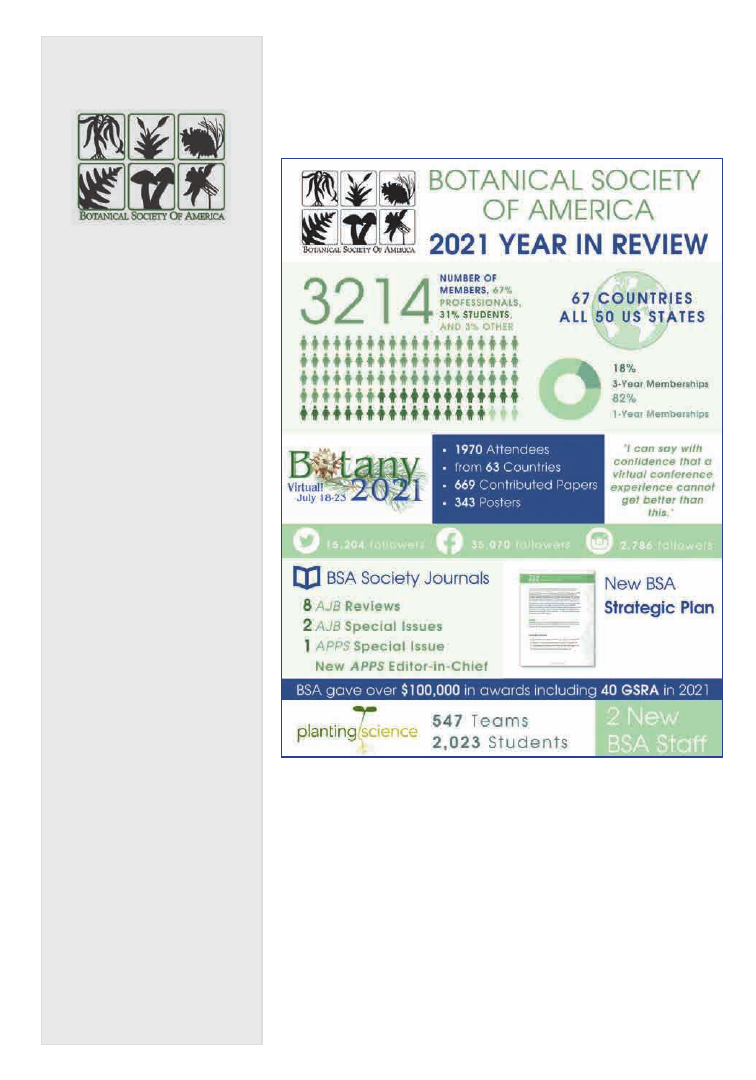
Plant Science Bulletin
The Botanical Society of
America is a membership soci-
ety whose mission is to: pro-
mote botany, the field of basic
science dealing with the study
& inquiry into the form, func-
tion, development, diversity,
reproduction, evolution, & uses
of plants & their interactions
within the biosphere.
ISSN 0032-0919
Published 3 times a year by
Botanical Society of America, Inc.
4475 Castleman Avenue
St. Louis, MO 63166-0299
Periodicals postage is paid at
St. Louis, MO & additional
mailing offices.
POSTMASTER:
Send address changes to:
Botanical Society of America
Business Office
P.O. Box 299
St. Louis, MO 63166-0299
bsa-manager@botany.org
The yearly subscription rate
of $15 is included
in the membership
Address Editorial Matters (only) to:
Mackenzie Taylor, Editor
Department of Biology
Creighton University
2500 California Plaza
Omaha, NE 68178
Phone 402-280-2157
psb@botany.org
Plant Science Bulletin
Spring 2022 Volume 68 Number 1

LI-600 Porometer/Fluorometer
Rapidly survey plants in ambient conditions.
Visit
licor.com/600 to learn more.
•
Measure stomatal conductance and
chlorophyll a fluorescence
•
Determine leaf angle relative to the sun
•
Track measurement locations
•
Generate and scan barcodes
•
Manage configurations and data